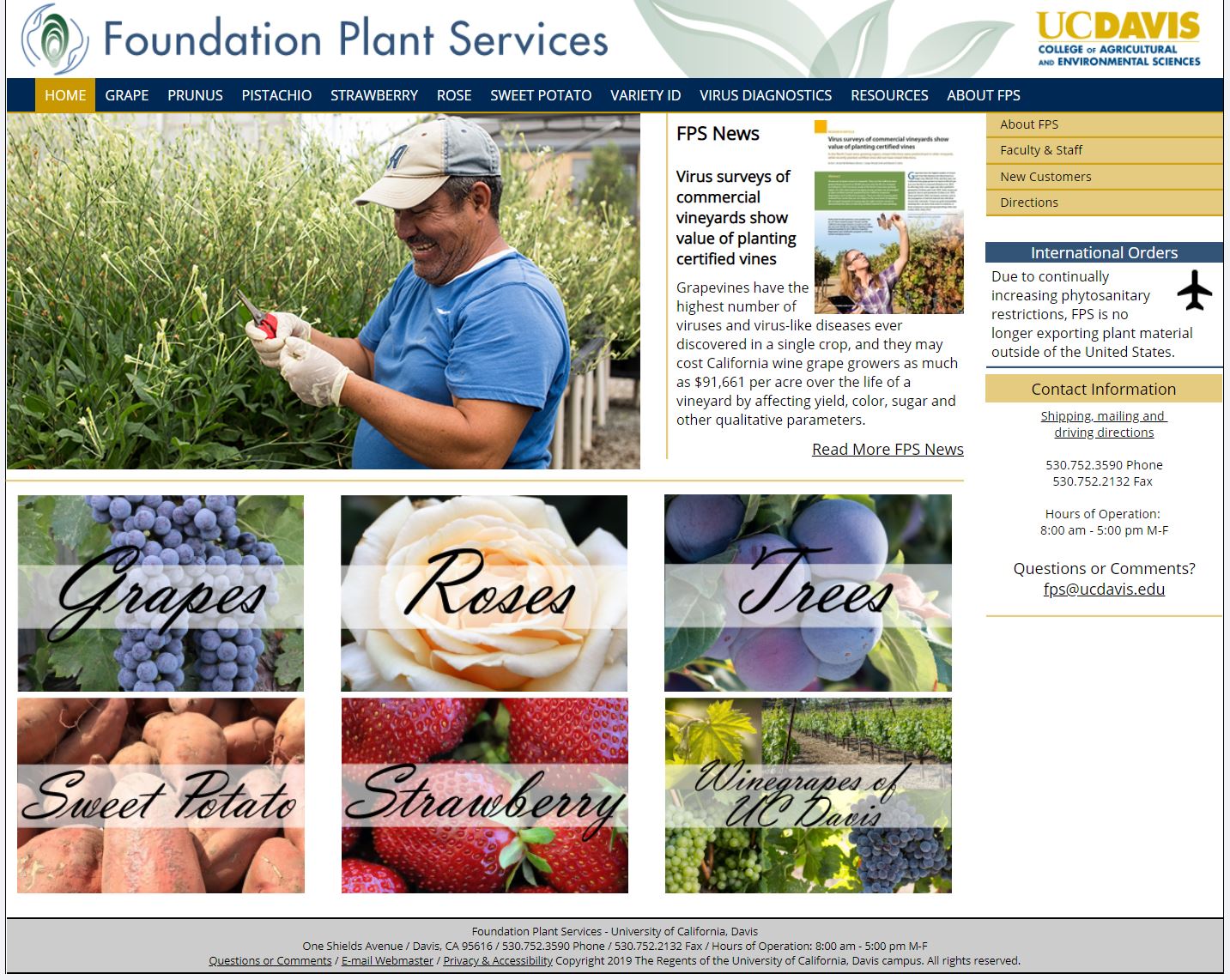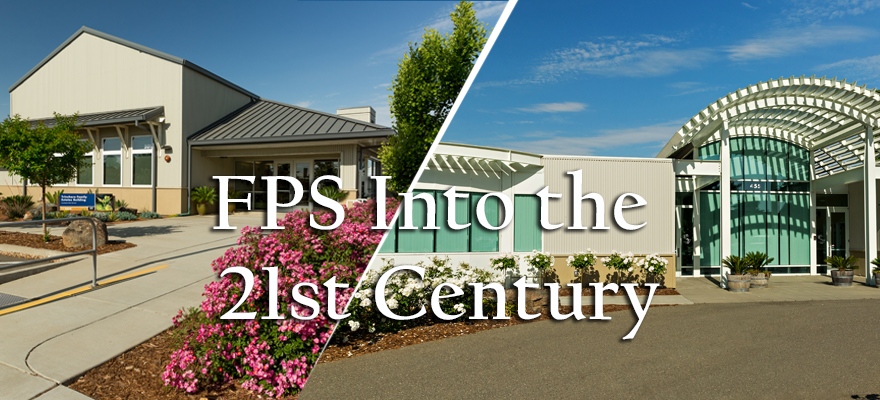
Written by Nancy L. Sweet, FPS Historian, University of California, Davis - March, 2019
© 2019 Regents of the University of California
Moving into the 21st Century
-- Anne Foley Scheuring, Science & Service: A History of the Land-Grant University and Agriculture in California, at p. 119 (1995).
Foundation Plant Services is a clean plant center at the University of California, Davis. The primary goal of the center is to create, maintain and distribute high quality, virus tested plant material to customers. Secondary goals include information sharing and diagnosis on disease issues and development of advanced technologies for disease detection. Although the work includes applied research, FPS is mainly a service center with a focus on extension work and outreach to the industry.
Extension work at public universities has been defined as the “bridge” between the land-grant colleges and farmers in the countryside. The purpose of extension work is to bring university experiment station research directly to the people who could use it to improve their lot. 1 Anne Foley Scheuring, Science & Service: A History of the Land-Grant University and Agriculture in California, at p. 146 (ANR Publications, Regents of the University of California, 1995). FPS’ largest customer group consists of grapevine nurseries, grape growers and wine makers.
Despite the nod towards the service component in the above quotation, the practical reality is that university administrators often place a greater value on teaching and research, exemplified by favoring publication over service work for academic promotions. Land grant colleges have a difficult time making a place for applied research and service work. Extension programs and service centers frequently experience funding and staffing difficulties as a result of the tension between competing needs at the public universities. The difficulty was even more challenging at the University of California in the face of budget cuts in the decades prior to 2000. For a time, it appeared that FPMS/FPS might become another casualty in that scenario. 2 Anne Foley Scheuring, Science & Service: A History of the Land-Grant University and Agriculture in California, at pp. 146-155 (ANR Publications, Regents of the University of California, 1995).
FPMS/FPS faced serious challenges in the 1980’s. Although sales of the certified grapevine material mostly carried their own funding weight at FPMS, the primary concern late in the decade was the future of virus testing at the grapevine importation and quarantine program at the facility. Austin Goheen’s retirement left a void in the Davis program. The Department of Plant Pathology had withdrawn from FPMS some of the resources previously used to test and treat the imported grapevine material on the basis that the work involved time-consuming service work and not research. The center lacked the facilities and personnel to continue adequate testing and treatment work requested by its customers: the grape and wine industry. The future of the clean plant program at UC Davis was uncertain.
Fortunately, the key players in that scenario – University of California, FPMS, CDFA (California Department of Food & Agriculture), nurseries, winemakers and growers – recognized a mutual need and cooperated to develop a center that has become a national leader for healthy grapevine material. FPMS made significant strides in improving the quality of its clean plant program beginning in the late 1980’s with the addition of new scientists and the application of new testing and therapy strategies to combat serious disease threats.
Significant upgrades in disease testing technology initiated beginning in the 1980’s have transformed the quality of the foundation grapevine material available in 2019. At the same time, the distribution of a clean plant product as well as decades of education on its value have improved the quality of vineyards throughout the United States for the benefit of FPS customers and the public. Those efforts have made FPS one of the premier clean plant centers in the world.
FPMS RESTRUCTURED
The problems experienced in the 1980’s by FPMS and its umbrella unit FSPMS (Foundation Seed & Plant Materials Service) were addressed in a comprehensive fashion by the University of California. As a result of an intense and thorough evaluation process, FPMS emerged as a stand-alone service center with strong leadership. New facilities, upgraded technology and more effective disease testing and treatment strategies set the center on a positive course.
The restructuring effort was motivated in part by the problems experienced by FPMS in the 1980’s. The unexpected incidence of viruses in the foundation vineyard, inadequate FPMS nursery practices and mix ups regarding grape rootstocks caused much concern within the grape industry. 3 Letter from Cal Qualset, acting Director FSPMS, dated October 18, 1993, Foundation Plant Services collection AR-050, box 34: 6, Department of Special Collections, Shields Library, UC Davis.
After several years of meetings addressing needed improvements to the clean plant program at UC Davis, FPMS underwent an extensive evaluation by a special industry/University task force, the recommendations of which would materially affect the program in 1993. Efforts to restructure the FPMS program proceeded at the University on a parallel track with the development and construction of the new importation and quarantine facility, which was completed in 1994.
An extensive review of FPMS was undertaken as part of a review of the UC Davis umbrella unit FSPMS (Foundation Seed & Plant Materials Service). FSPMS had since 1975 become too complex technically and too large to be served by a single Director. Unique advancements in technology and industry needs differed for hundreds of seed-produced crops versus clonally reproduced crops. It appeared that effective satisfaction of future industry demands would require expansion and efficient reorganization of the programs. A review was conducted to judge the effectiveness of the FSPMS program, including services to its clientele, organizational and managerial efficiencies and fiscal condition. 4 Review of Foundation Seed and Plant Materials Service (FSPMS), A Task Force Report, College of Agricultural and Environmental Sciences, University of California, Davis, December, 1992, p. iv (hereafter referred to as Task Force Report).
The FPMS portion of the review was conducted in three phases. After an internal review within the University, an external review was conducted in 1991 by a review team composed of representatives from clean plant centers similar to FPMS in Canada and the U.S. The external review received little input from the grape industry. The findings were characterized as “anecdotal” and “claims without evidentiary support”. FPMS Advisory Committee member and grape winegrower Phil Freese reported to the FPMS Grape Committee in November of 1991 that a final phase of the review had been approved by AES Dean John E. Kinsella in October 1991. The review would have substantial industry and University representation.
Dean Kinsella appointed Calvin Qualset, Robert Woolley and Phil Freese as co-Chairs of the UCD-Industry Task Force, which included members from all the University departments that interacted with FPMS, as well as representatives from industry, CDFA and USDA. 5 Minutes, FPMS Grape Subcommittee Meeting, November 5, 1991, included in FPMS 1992 Annual Report, Foundation Plant Services collection AR-050, box 29: 49, Department of Special Collections, Shields Library, UC Davis; Task Force Report, supra, at p. 3. Qualset was at the time Chair of the UC Davis Agronomy and Range Science Department and Director of the Genetic Resources Conservation Program. Woolley, owner and general manager of Dave Wilson Nursery, represented the fruit and nut tree constituency. The Task Force completed its review in December, 1992, and published its findings in spring, 1993. Dean Kinsella accepted all of the recommendations of the report before his untimely death in 1993. 6 “Dean’s Review of Foundation Seed and Plant Materials Service Completed”, FPMS Newsletter, number 13, October 1993, page 1.
The most visible and important recommendation was that the umbrella unit FSPMS be disbanded and two independent service centers be formed, each with its own Director. One new center included Foundation Seed Program and the California Crop Improvement Association for seed-related services. The second center was Foundation Plant Materials Service (FPMS), which was then a unit with eight employees that provided a program for clonally propagated crops such as grapes, strawberries, and fruit and nut trees.
UC agreed to create a faculty-level Director’s position for FPMS, composed of 70% FTE Academic Administrator series and 30% Cooperative Extension specialist. The new Director would thereafter report directly to the Office of the Dean, College of Agriculture and Environmental Sciences at UC Davis. 7 Task Force Report, supra, at pp. iv and 16-18. A PhD was required in a field relevant to the FPMS mission (horticulture, plant pathology or genetics). The USDA-ARS would no longer provide personnel to manage any aspects of the FPMS program.
Recruitment for the Director position for both new centers was underway by fall of 1993. Cal Qualset had served as Acting Director of the umbrella organization FSPMS since 1991 and continued to do so until the Director positions could be filled for the new centers. 8 “Dean’s Review of Foundation Seed and Plant Materials Service Completed”, FPMS Newsletter, number 13, October 1993, page 1; Minutes, FPMS Grape Advisory Board Meeting, June 15, 1993, Foundation Plant Services collection AR-050, box 23: 14, Department of Special Collections, Shields Library, UC Davis; “FPMS Staff Changes”, FPMS Newsletter, number 11, October 1991, no. 11, p. 1.
Deborah Golino
Deborah Golino received her Bachelor of Science degree from UC Riverside in 1974 in Plant Sciences. She thereafter achieved Master’s (1983) and Doctoral (1987) degrees in Plant Pathology from UC Riverside. While studying in her graduate programs, Golino was employed as a technician and USDA researcher in the USDA-ARS (Agricultural Research Service) Boyden Fruit and Vegetable Insects Laboratory at UC Riverside where she performed basic and applied research on arthropods that transmit pathogens of fruit trees. Her thesis was based on her work at the entomology laboratory on vectors for phytoplasma/bacteria on citrus.
Golino had begun to work her way up the federal GS system while at UC Riverside. In the 1980’s, the USDA-ARS had begun to downsize the number of researchers around the country and cut the budgets for agricultural research. The pool of ARS researchers around the country had been halved in the prior 20 to 25 years. The Boyden Entomology Lab was closed in 1987, and the scientists were transferred.
Golino’s USDA area director, Bill Chase, was acquainted with Dr. Bob Webster in the Department of Plant Pathology at UC Davis and saw that Golino was transferred to Davis. She agreed to work with grapes, manage the grape imports and oversee the testing at FPMS in light of Goheen’s retirement. She was transferred from Riverside to Davis in 1987.
As was Austin Goheen, then-USDA scientist Golino was initially associated with the Department of Plant Pathology at UC Davis. Her assignment included research on virus and virus-like diseases of grapes and development of virus elimination techniques. She was immediately appointed to the FPMS Grapevine Technical Advisory Committee. 9 Minutes, FPMS Grape Subcommittee Meeting, November 17, 1987, included in 1988 FPMS Annual Report, Foundation Plant Services collection AR-050, box 29: 49, Department of Special Collections, Shields Library, UC Davis; “New USDA Research Plant Pathologist at UCD”, FPMS Newsletter, number 7, November 1987, p. 2.
The reinstatement of the grapevine importation program at FPMS was a matter of some urgency to the grape and wine industry. After Goheen decided to retire in 1986, grape importations at FPMS ceased. He had stopped processing the quarantine selections in anticipation of retirement. FPMS distributed Goheen’s collection of approximately 700 grape selections from the Plant Pathology facilities to facilities managed by FPMS, the Department of Viticulture & Enology, and the NCGR in the winter and spring of 1987. FPMS assumed responsibility for holding the selections that were scheduled to be indexed in 1987-88 and all selections that remained in quarantine at that time.
Demand for imports increased as new work was being done at programs in Europe. Growers and nurserymen were unhappy and lobbied for a replacement for Goheen. The quarantine hiatus in California encouraged illegal clonal importation activity, which reached an all-time high; much needed screening and indexing processes were often by-passed in favor of quick, potentially dangerous illegal entry. 10 Alley, L. and D.A. Golino. “The Origins of the Grape Program at Foundation Plant Materials Service”, Proceedings of the ASEV 50th Anniversary Meeting, Seattle, Washington, June 19-23, 2000, pp. 227-228; “Grape Program Changes”, FPMS Newsletter, number 8, November 1988, at pp. 3-4.
Golino’s commitment in 1987 to oversee the FPMS work was a welcome solution to the void created by Goheen’s retirement. In October of 1988, she indicated to the FPMS Industry Advisory Committee a willingness to serve as scientific administrator for a grape quarantine program at FPMS, to familiarize herself with the laws and science involved and to develop protocols. She agreed to apply for an importation permit in her name when [Goheen’s] prior permit expired in July of 1989.
At the time, Golino expressed a reservation about the fact that a permit came without any funding or facilities to support a federal quarantine program. She stated an intent to seek funding from USDA-APHIS (Animal and Plant Health Inspection Service) to do the quarantine work at FPMS. Golino also voiced her opinion that FPMS needed additional facilities (greenhouse, screenhouse, field plot, laboratory, environmental control chamber) and staff to implement an active program. 11 Minutes, FPMS Grape Industry Advisory Committee Meetings, October 7 and 19, 1988, Foundation Plant Services collection AR-050, box 23: 12, Department of Special Collections, Shields Library, UC Davis; “Grape Program Changes”, FPMS Newsletter, number 8, November 1988, at pp. 3-4.
There were only three permit holders for grape importation in the United States in 1988: David Cameron at OSU (Oregon State University); Dennis Gonsalves at Cornell University, New York; and Goheen at Davis. Cameron’s permit at OSU was dependent on his ability to send his quarantine material to Davis for the leafroll index, and he had stopped accepting new materials. 12 Minutes, FPMS Grape Industry Advisory Committee Meeting, October 7, 1988, FPS collection AR-050, box 23: 12, Department of Special Collections, Shields Library, UC Davis; Minutes, FPMS Grapevine Advisory Committee Meeting, January 10, 1986, AR-050, box 23: 11. The reason for a shortage of permit holders was that only research scientists associated with a university or a publicly-funded research organization (USDA/ARS) could hold departmental permits for importation. 13 Deborah Golino, “Grapevine Importation: the process and the problems”, Practical Winery & Vineyard, May/June 1989, pp. 81-84.
Only two grape centers in North America were actively processing imports through quarantine in the 1980’s: (1) Cornell University in Geneva NY and (2) the Canadian Food & Inspection Agency in Saanichton, British Columbia. A scientist at Missouri, R. N. Goodman, Department of Plant Pathology, University of Missouri, received an importation permit for grapes for the Fruit Experiment Station at Mt. Grove (SW Missouri State University) in 1994. 14 Letter from R.N. Goodman, Adj. Res. Prof. University of Missouri-Columbia, Adj. Prof. Fruit Experiment Station, Mt. Grove, to Susan Nelson-Kluk, Manager, dated September 27, 1994, on file at FPS.
Grape industry members in California were eager to reinstate the quarantine program at FPMS and supported Golino’s proposals by way of an industry resolution to the California Department of Food & Agriculture (CDFA) on November 16, 1988. The FPMS Grape Industry Advisory Committee endorsed the idea of a new quarantine facility and program. The Committee asked FPMS staff for a plan for release of [Goheen’s] pending plant material, including the Winegrowers’ clones [see below], within the following two years. FPS Advisory Committee member, grower and winemaker Phil Freese noted that the best way to improve FPMS public relations would be to efficiently import and release new foreign grape selections. 15 Minutes, FPMS Grape Industry Advisory Committee Meetings, October 7 and 19, 1988, FPS collection AR-050, box 23: 12, Department of Special Collections, Shields Library, UC Davis.
The transition from Goheen to a new permit holder would not be without a few roadblocks. Golino was a young research scientist and, as such, was expected to perform research and to publish to advance within the federal agency. Her administrators at USDA-ARS initially told her she could not hold the importation permit for the work at FPMS because her job was to do research, and service work was not part of the ARS mission.
The California grape and wine industry, including interested parties such as Rich Kunde and Phil Freese, had put pressure on Congress and the USDA-ARS to ensure that Austin Goheen was replaced. They did not understand that replacement of Goheen did not necessarily mean FPMS would inevitably be granted a USDA scientist to do the FPMS work. FPMS staff were initially upset that Golino would not be allowed to acquire a new permit and that imports would not resume. Apart from the permit and staffing issues, Golino felt that FPMS could not do effective quarantine work without proper facilities. 16 Alley, L. and D.A. Golino. “The Origins of the Grape Program at Foundation Plant Materials Service”, Proceedings of the ASEV 50th Anniversary Meeting, Seattle, Washington, June 19-23, 2000, p. 227.
APHIS (Animal and Plant Health Inspection Service) is a co-equal sister department of ARS within the USDA. APHIS provides oversight on the importation and quarantine regulations in the United States and establishes guidelines and issues permits allowing importation of grapevine material into the country. While the USDA-ARS initially denied Golino permission to hold a permit for the FPMS program, Director Joseph Foster at the APHIS National Plant Germplasm Quarantine Program informed her that someone qualified as a scientist acting for FPMS would need to be named on the new permit before an importation program could be restarted. The FPMS program was between a rock and a hard place in 1988.
The concept of the APHIS “Departmental Permit” was described in the prior chapter (“Origin of Foundation Plant Services”). USDA Departmental Permits were issued to qualified scientists at places like universities and other government agencies to bring prohibited plant materials into the United States for research under strict conditions through regulated importation and quarantine facilities. Dr. Joseph Foster felt that issuance of an importation permit in the name of a person at a certain institution rather than the institution itself would provide greater responsibility and accountability. 17 Interview with Erich Rudyj, Coordinator, National Clean Plant Network, USDA-APHIS, on September 22, 2017.
In February, 1989, Golino informed the FPMS Technical Committee that USDA-APHIS policy would not permit transfer of quarantine materials previously imported under Goheen’s permit to Golino’s custody unless the name of a qualified plant pathologist was on the departmental permit issued to FPMS. Goheen’s permit was set to expire in 1989. 18 Minutes, FPMS Technical Committee Meeting, February 3, 1989, FPS collection AR-050, box 23: 12, Department of Special Collections, Shields Library, UC Davis.
The impasse was resolved in 1990 when Golino was awarded a Departmental Permit (No. 61201) to test and qualify for release Vitis accessions imported by Goheen under his old Departmental Permit (No. 57319). The accessions previously on hold at FPMS were released for disease testing and treatment.
Golino was eventually awarded a Departmental Permit in her own name (no. 61541) in 1991-92 for new importations of grape varieties and clones into the United States. USDA-ARS agreed that Golino could hold the grapevine importation permit in her name “as long as she didn’t do any of the work” at FPMS and instead did her research work. [Golino was later reissued another Departmental permit in 1995 to reflect her change of status to Director of FPMS.]
Grape importation through FPMS would not resume until the 1992-1993 season, about the time a new FPMS facility with appropriate equipment was finally constructed. 19 Alley, L. and D.A. Golino. “The Origins of the Grape Program at Foundation Plant Materials Service”, Proceedings of the ASEV 50th Anniversary Meeting, Seattle, Washington, June 19-23, 2000, p. 227.
A new Director at FPMS
The University of California conducted a national search to fill the new Director position at FPMS beginning in 1993. Numerous qualified candidates were considered. Deborah Golino had been working with FPMS for years by that time and was familiar with the scientific and technical issues and funding problems experienced by the program. She had the requisite PhD in Plant Pathology to qualify under the USDA regulations for a grape importation permit and years of experience with the USDA researching plant pathogens.
The committee offered the FPMS Director position to Golino. She was a young research scientist in an atmosphere where research, teaching and publishing were normally required for advancement. Golino recognized the tension between the “twin goals of discovery and service” when she arrived in the Department of Plant Pathology at UC Davis in 1987 as a USDA-ARS scientist. The decision to accept the position presented a dilemma.
FPS has its historic roots in UC Davis faculty research programs on viruses of cherries and grapevines in the 1950’s. At that time, creating clean plant material by screening for viruses was cutting edge science. As the years passed, this important work became less part of a modern research program for faculty and more of a service program for industry. The challenges faced in continuing the work of the clean plant centers at universities arise in part from the traditional dichotomy between research and service work, frequently resulting in short-changing the service component. USDA scientist Austin Goheen had made sacrifices in terms of career advancement for the service work he performed at FPMS from the 1960’s through the 1980’s.
The clean plant and outreach work at FPS were considered service work by the time Golino interviewed for the Director’s position. The grape and wine industry that had lobbied for her position at FPMS were most interested in that FPMS service work. The dilemma she faced was ultimately resolved when Golino accepted the Directorship at FPMS in 1994 notwithstanding the possible professional and financial challenges.
University centers with faculty members in the Director position often did not give the Director adequate time to complete the service work as well as meet expectations for research, teaching and other academic work. UC Davis attempted to remedy that situation when they hired Golino as the new Director for FPMS in 1994. The funding structure for the Director position was established with an eye toward value for service work.
UC Davis committed a faculty administrative position to serve as FPMS Director. Golino was hired to fill that position. The position description for the FPMS Director assigned 70% of the Director’s time to the Academic Administrator title (College of Agriculture and Environmental Sciences) and 30% to the Cooperative Extension Specialist title (Agriculture & Natural Resources). With those faculty titles, it would be possible for the new Director to have career success while administrating service work.
Service work is highly valued by the industry stakeholders, who demonstrated their commitment by substantial funding commitments to the FPMS program. The industry group IAB (California Fruit Tree, Nut Tree and Grapevine Improvement Advisory Board) was established in 1988 to promote production of high-quality tree and grapevine nursery stock. The IAB committed to providing 40% of the new faculty Director’s salary and benefits.
Golino officially assumed the Director position at FPS on November 1, 1994. The new Importation & Quarantine Facility was built and opened the same month.
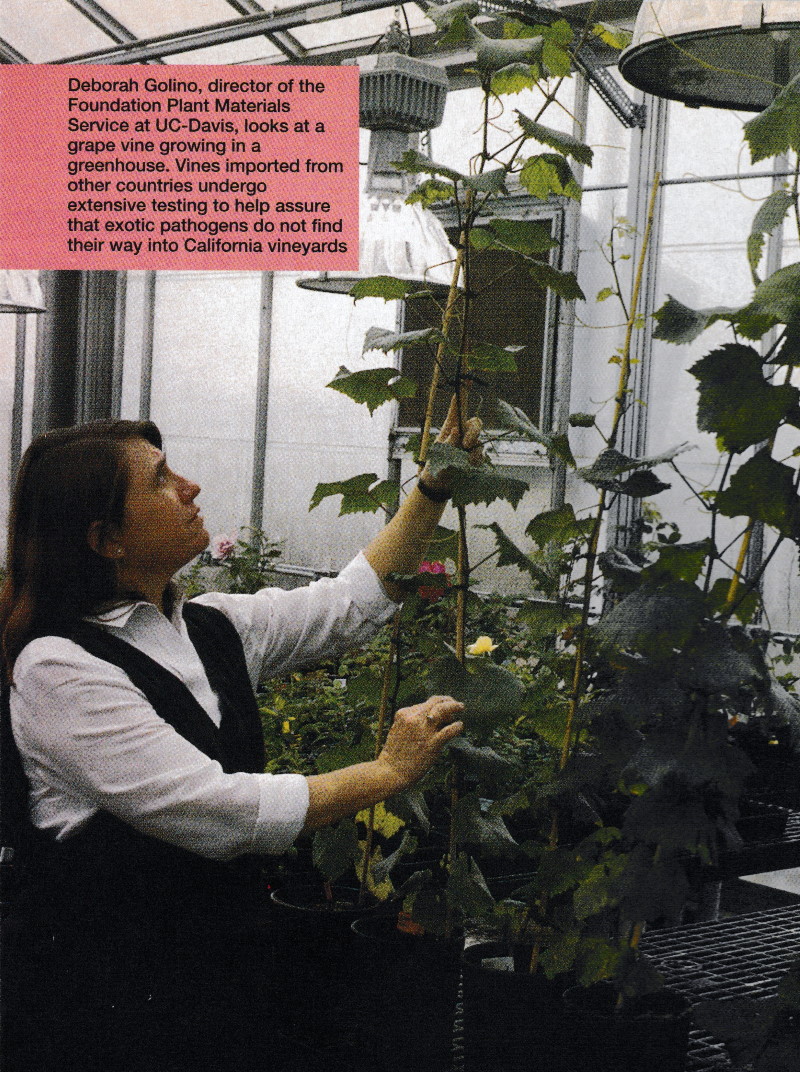
As recommended in the 1992 Task Force Report, Golino organized the center into crop units when she was appointed Director of FPMS. She appointed specialists from the FPMS staff as Managers for the various crops: Susan Nelson-Kluk for the Grape Program; Mike Cunningham for the Tree and Rose Programs; Golino for the Strawberry Program. 20 Message from the Director, Newsletter, Foundation Plant Materials Service, no. 14, November 1995, page 1. Adib Rowhani was assigned to head the FPMS plant health section, and Cunningham was charged with overall responsibility for all plant materials maintenance, propagation and distribution.
The Task Force also recommended more direct involvement with FPMS by the faculty of the University departments that had research and extension responsibilities for the crops handled by the center. UCD Viticulture & Enology Professor Dr. Andy Walker had served as Interim Associate Director for Viticulture at FPMS since November 1, 1993, during the search for a new FPMS Director. On October 18, 1994, Golino requested that Walker remain in that capacity for frequent input and consultation on viticulture matters particularly related to ampelography and identification of the FPS foundation collection. 21 Memo from Deborah Golino, FPMS Director, to all FPMS Advisors, dated October 18, 1994, FPS collection, AR-050, box 23: 14, Department of Special Collections, Shields Library, UC Davis.
The Task Force Report recognized the significant service work the FPMS grape program had performed for California agriculture in the past, benefitting the industry enormously by increasing vineyard productivity and fruit quality. The Task Force found that the grape program had been the most financially solid of the FPMS programs over the prior 30 years, generating enough income to cover its operating costs in most years. A major factor in the profitability projection for the future was the introduction of “new products”, i.e., grape scion and rootstock selections that would be processed through the new National Grapevine Importation and Clean Stock Program beginning with the first imports in 1992-93. That program would be required to generate its own operating revenue. 22 1992 Task Force Report, supra, at p. 12.
Phil Freese, then Vice-President at Mondavi Winery, was one of the co-chairs of the Task Force and a long-time industry advisor to FPMS/FPS. He entered the grape and wine industry in the late-1970’s with a doctorate in the biological sciences (biochemistry and biophysics) from UC Davis. Freese would eventually establish his own consulting and winery business, WineGrow, with plantings on multiple continents. Freese and his wife, respected winemaker Zelma Long, established Vilafonte Vineyards in Stellenbosch, Western Cape of South Africa.
Freese saw the Task Force project as a tale of government, academics and industry working together to produce a platform that continues to refresh itself and adapt to evolving needs. His close association with FPMS/FPS over the years has led him to conclude that the University and industry collectively came together to establish a successful framework for the future.
Freese indicates he was fortunate to have had the opportunity to spend a lot of time with Austin Goheen, who was dedicated to the theory of working with “clean materials and keeping them clean”. Freese also saw that the late 70’s and into the 80’s was a time of strong demand to bring in different clonal selections and varieties and to broaden the reservoir of different rootstocks. He recalls the words of his mentor, Robert Mondavi: “Wine characters and styles were driving the industry in its full-on pursuit of production of ‘wines that would stand in the company of the wines of the world’.”
Freese saw Austin Goheen’s retirement as a threat to the continued sanitary health of the FPMS grapevine collection. At the same time, there was a new and emerging need for additional clonal materials. The university program needed everything in the late 1990’s – propagation and dissemination of tested materials, scientific research into previously unknown or uncharacterized diseases, awareness that California was not using all the available rootstocks and scions and yet was striving to compete to the higher standard of wines of the caliber of the rest of the world. This “new era” required maintaining previous capacities while building on new capabilities in the future.
Given the funding shortage faced by the University, this “new era” required new solutions driven by an individual that could assume a wide variety of professional challenges. Freese saw that FPMS needed leadership, scientific knowledge and a research direction to address existing and future issues, as well as a great manager, team builder, a person with academic credentials and “research gravitas”, who could work effectively in both the academic and the grower’s worlds. He states that Golino was exactly the “right person in the right place at the right time to take on the future” of the FPMS/FPS program.
Much remained to be done by way of outreach to the grape industry once the new FPMS team was in place. Long-time Production Supervisor Mike Cunningham felt that FPMS needed a Director with political acumen who could anticipate and adjust to future industry needs. When FPMS had been part of the umbrella unit FSPMS, the Directors Burt Ray, Cal Qualset and Bob Ball were more agronomically oriented and spent much time with the seed work and less with the clonally-propagated crops. Cunningham saw that Golino had a practical streak resulting in focus on big picture issues and results. She also possessed exceptional communication and networking skills that facilitated strong relationships with members of the grape and wine industry.
Golino quickly grew into the Director position at FPMS. As the center moved into the new facility, she hired more people, and the state-of -the-art laboratories came to life. Disease testing and treatment made significant advances to upgrade the plant material. New imports and domestic accessions greatly diversified the foundation grapevine collection. The technology and outreach media underwent significant overhaul, mostly in the years after 2010. The following topical threads illustrate the significant initiatives and improvements over which Golino presided as Director of FPMS/FPS.
GRAPEVINE IMPORTATION & QUARANTINE FACILITY (1995)
“The National Grapevine Importation Program began in 1995 as a result of a cooperative effort by UC, the USDA, CDFA, and the grape industry. The new program included a new importation and quarantine facility, state of the art laboratory facilities for disease testing and variety identification and field facilities and vineyards.” -- FPMS Grape Importation brochure.
From 1995 through 2018, more than 2,100 new grape selections were introduced at FPS, including new foreign and domestic varieties, clones and rootstocks, plus germplasm intended for research. The quarantine facility completed in 1994 and dedicated in 1995 made that result possible.
FPMS had ceased accepting new grape material from foreign and domestic sources prior to 1989. No disease elimination work to clean up accumulated quarantine selections had been done since Goheen’s retirement. The quarantine grapevine material received by Goheen under his permit had been languishing for years in the Department of Plant Pathology field facilities and the greenhouses at the National Clonal Germplasm Repository in Davis. There was a backlog of more than 300 grape selections known to be diseased and needing treatment in Davis before they could be released from quarantine. Valuable quarantined material already collected by Harold Olmo and others was in danger of being lost because of the makeshift nature of the FPMS facilities in which the material was held after Goheen’s retirement.
The Department of Plant Pathology had indicated an intention to reassign the facilities and field space used by Goheen for his work on quarantine processing. The existing facilities at FPMS were completely inadequate to house a grape importation and quarantine program in 1989. Structures appropriate for isolation of quarantined grapevine material were needed prior to any importations under a new permit. FPMS did not have adequate facilities to maintain on an indefinite basis the selections that had been accumulated by Goheen.
The grape and wine industry was anxious to assist with a solution. The FPMS Grape Industry Advisory Committee recommended that FPMS increase prices for grape materials (October, 1988) and reinstate user fees for additional income (May, 1989). Influential Advisory Committee members such as Phil Freese and Zelma Long shared the vision for a new facility and provided invaluable support in securing federal and industry funding. Deborah Golino travelled to local growers meetings around California educating on the need for new FPMS testing and treatment facilities before grape importations could be resumed.
In April of 1989, FPMS submitted a proposal to the USDA requesting funding for a Grapevine Importation & Quarantine facility at UC Davis. The goals were to provide importation services for commercial grape growers and researchers and to protect the U.S. grape industry from introduction of dangerous foreign pathogens. 23 Susan Nelson-Kluk, “Grapevine importation revived at FPMS”, Practical Winery & Vineyard, September/October 1992, pp. 22-23. The proposal was submitted to the USDA too late to obtain funds from the USDA budget for federal fiscal year 1989-90.
Winemakers Robert Young and Louis Martini approached Congressman Vic Fazio for assistance. Fazio placed an allocation of $130,000 for design and planning activities in the House of Representatives agriculture funding bill for 1989-90. Although the Senate removed the item from the budget bill, it was reinstated by a House/Senate conference committee in October, 1989, after a vigorous letter writing campaign conducted by the industry. 24 “FPMS Grape Importation Project”, FPMS Newsletter, no. 9, November 1989, page 2. FPMS was ultimately provided with $124,160 from the 1990 federal budget for design and planning of the new facility. 25 “Grape Program Report”, FPMS Newsletter, no. 10, November 1990, page 1.
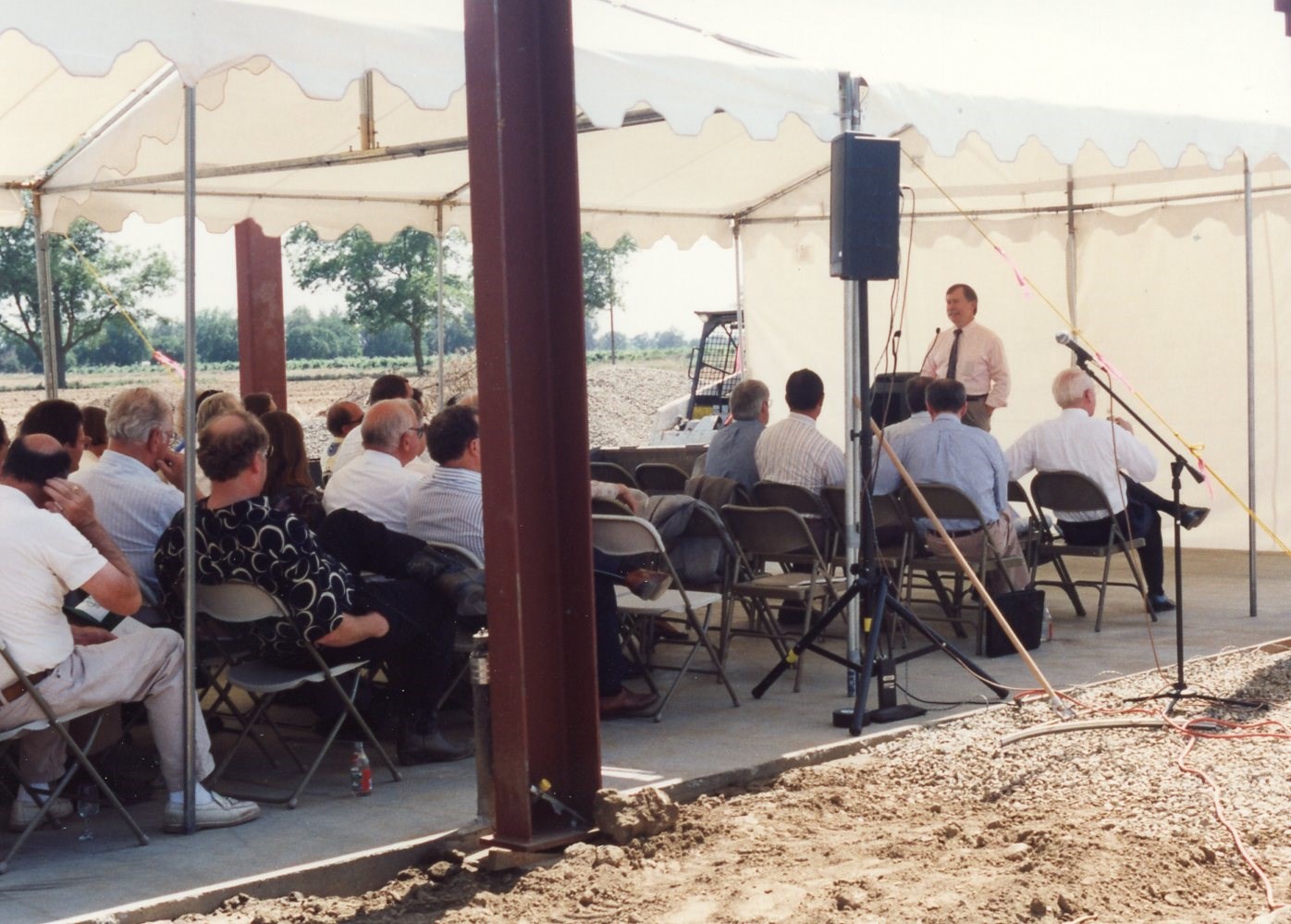
The $3.5 million building project was ultimately funded jointly by the federal government, the University and private industry. Industry advocacy efforts, organized by winegrower Phil Freese, resulted in appropriations from the federal budget to FPMS of $870,090 (1991), $1,610,000 (1992) and $582,000 (1993) for a National Grape Importation and Clean Stock Facility.
The USDA required partial matching funds for the project. The industry group IAB (California Fruit Tree, Nut Tree and Grapevine Improvement Advisory Board) donated $125,000 for a quarantine screenhouse and $180,000 for a portion of a greenhouse. 26 “Grape Program Report”, FPMS Newsletter, no. 10, November 1990, page 1; IAB Board Minutes, April 1992, Foundation Plant Services collection AR-050, box 34: 7, Department of Special Collections, Shields Library, University of California, Davis . The University made contributions in funds, staff services and land to make up the balance needed. 27 Letter from Phil Freese to Grape Industry Members dated October 14, 1991, reprinted in FPMS Newsletter, number 11, October 1991, p. 2; “National Grapevine Importation Program”, FPMS Newsletter, no. 12, November 1992, p. 3.
FPS’ dire need for its own dedicated quarantine structures was about to be satisfied. A new facility was constructed in phases between 1990 and 1994 at the corner of Hopkins and Straloch Roads west of the UC Davis campus. FPMS Manager Susan Nelson-Kluk performed an important role as liaison between UC and the USDA during the planning and construction of the facility. The official ground-breaking ceremony for the new facility was held on June 1, 1992.
Phase I of the project included completion of facility planning as well as construction of outbuildings – a quarantine screenhouse and strawberry clean stock greenhouse in 1990. One small setback occurred when the sodium lights were stolen from the strawberry greenhouse by suspected pot growers. A primary quarantine greenhouse, indexing greenhouse, soil storage area and headhouse were completed as Phase II in November 1992. Those facilities made it possible for FPMS to import foreign grapevine materials and perform disease testing. Grape importations resumed in the 1992-1993 dormant season.
Phase III saw completion of the laboratory/office area and second screenhouse in 1992. Construction of the laboratory was necessary before FPMS could perform disease elimination treatments. A second indexing greenhouse, landscape irrigation, and all fixed equipment were completed in 1993 in Phase IV.
The new facility was occupied in September, 1994. The initial design plans proposed a vibrant and, some thought, “garish” color scheme for the building, which eventually was muted to rose and purple to evoke the colors of grapes. The new facility was a 15,620-square foot complex including laboratories, business offices, screenhouses and greenhouses. The modern laboratory facilitated expansion of existing services and space to conduct research for improving disease detection and disease elimination technologies. An open house and dedication of the facility was held on April 21, 1995. 28 Alley, L. and D.A. Golino. “The Origins of the Grape Program at Foundation Plant Materials Service”, Proceedings of the ASEV 50th Anniversary Meeting, Seattle, Washington, June 19-23, 2000, p. 228.
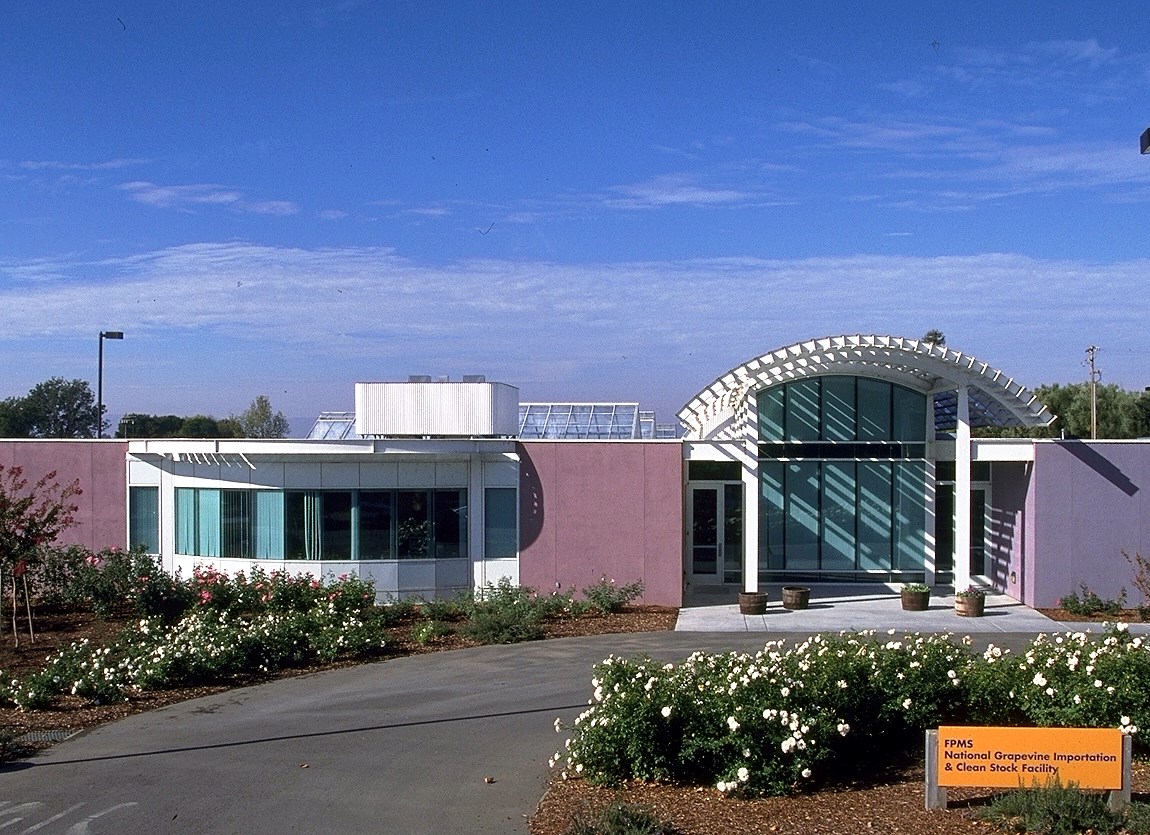
The first foreign grapevine material since 1989 was imported in the winter of 1992-93 and began the testing process at FPMS in anticipation of release from quarantine. Those imports included 40 selections from France and Italy that were sponsored with IAB funds accumulated through assessments on nurseries participating in the California R&C Program. 29 Susan Nelson-Kluk, “Grapevine importation revived at FPMS”, Practical Winery & Vineyard, September/October 1992, pp. 22-23; FPMS Newsletter, no. 12, November 1992, p.3; FPMS Newsletter, no. 13, October 1993, p.3.
NEW DIRECTIONS IN DISEASE TESTING AND TREATMENT
“The focus of the FPS grape program is to produce the highest quality virus-tested and true-to-variety plant materials, using state-of-the-art technology” --Deborah Golino, Challenging Times Ahead for FPS, FPS Grape Program Newsletter, October 2003
The key to improving the health status of vineyards in the state is selecting and supplying the highest quality of plant material to the industry. 30 Golino D.A., M. Fuchs, S. Sim, K. Farrar, and G.P. Martelli, “Improvement of Grapevine Planting Stock Through Sanitary Selection and Pathogen Elimination”, Grapevine Viruses: Molecular Biology, Diagnostics and Management, Chapter 27, p. 561, eds. B. Meng, G.P. Martelli, D.A. Golino, M. Fuchs (Springer International Publishing AG 2017). Significant changes in disease testing and treatment introduced at FPS in the 1990’s resulted in a much more consistent output in terms of phytosanitary standards. Quality control standards have been much improved. The advancements in disease testing technology developed since the 1980’s and improvement in quality control standards have transformed the nature of foundation grapevine material available at FPS in 2019.
The early FPMS efforts in disease testing and treatment, some of which are still used today for field index testing at FPS, are fully described in the prior chapter, “Origin of Foundation Plant Services”. Two scientists were added to the FPMS team in the late 1980’s. They directed significant upgrades in those early testing and treatment protocols. Dr. Adib Rowhani developed and implemented new technologies for more effective detection of grape viruses beginning in 1988. Dr. Deborah Golino eventually became FPMS Director. Golino and Rowhani added significant expertise and direction to the floundering program.
Adib Rowhani
Bob Webster was the Chair of the Department of Plant Pathology at UC Davis from 1984 to 1989. It was a time of budget cuts at the University, and major changes were being made in the way campus funds were being used to support faculty. For many years, Plant Pathology farm staff had planted and maintained the field virus index for FPMS, even though FPMS was no longer part of the Plant Pathology Department. Webster discontinued that tradition, asking FPMS staff to assume responsibility for the field index themselves.
In addition, at about the same time, Austin Goheen retired from the USDA-ARS. With his retirement, there was an end to the virus testing and heat treatment therapy provided to FPMS by Goheen and his technician, Carl Luhn.
Amid those major transitions, Webster took a step to ensure that FPMS work was continued despite the loss of resources. He successfully lobbied the Dean’s Office (College of Agriculture & Environmental Sciences, UC Davis) for funding for a dedicated Plant Pathology Specialist position to provide much needed technical support to FPMS. That faculty member would be responsible for overseeing accurate virus testing and effective disease elimination therapy for the FPMS program. Dr. Adib Rowhani was hired in spring of 1988 to fill that position.
Rowhani received his Bachelor of Science degree in Plant Protection from the University of Shiraz in Iran. He earned his Master of Science degree in Plant Pathology from McGill University in Montreal (1977) and PhD degree in Plant Pathology with emphasis on virus diseases from University of British Columbia (1980).
Rowhani arrived at UC Davis in 1980 for a post-doctoral position in the Department of Plant Pathology. He chose UC Davis because of the prestige and world-wide reputation of the Department. Rowhani explained that the move in 1980 from the large, cosmopolitan city of Vancouver, British Columbia, to the then-small village of Davis was unsettling at first. At the time, Davis had only two or three stoplights. Wheat and alfalfa were grown in the area where the busy thoroughfare of Covell Boulevard now exists. West Davis consisted of fields and crops. 31 Author interview of Dr. Adib Rowhani, January 29, 2018.
From 1980 to 1988, Rowhani studied the etiology of blackline walnut disease with Dr. John Mircetich. Rowhani was experienced with cutting edge virus disease testing technologies including ELISA, dsRNA extraction, virus purification and antiserum production. He cooperated with scientists nationwide on protocols for grape, fruit and nut tree and strawberry disease testing techniques. 32 “New Staff at FPMS”, Newsletter, Foundation Plant Materials Service, University of California, Davis, number 8, November 1988, p. 2.
Rowhani was approached about the FPMS specialist position about 1987 or 1988. The College of Agriculture conducted a national search and interviewed four candidates. Rowhani was ultimately selected and started at FPMS in spring, 1988, when FPMS was still one unit within the larger entity FSPMS (Foundation Seed & Plant Materials Services, see prior Chapter “Origin of Foundation Plant Services”).
When Rowhani started at FPMS, there were only four or five employees, including the Manager (Susan Nelson-Kluk), the Production Manager (Mike Cunningham), field supervisor (Matt Gallagher) and office staff (Cheryl Covert). Rowhani’s position was Director of Laboratory Operations, responsible for oversight of the health status of FPMS plant material
Rowhani spent time with Austin Goheen for about one year when Goheen was approaching retirement at UC Davis. Rowhani shadowed Goheen during that time and learned much about grapevines, especially about field indexing and inspections. He worked as staff Plant Pathologist on all crops at FPMS, primarily grapes and trees.
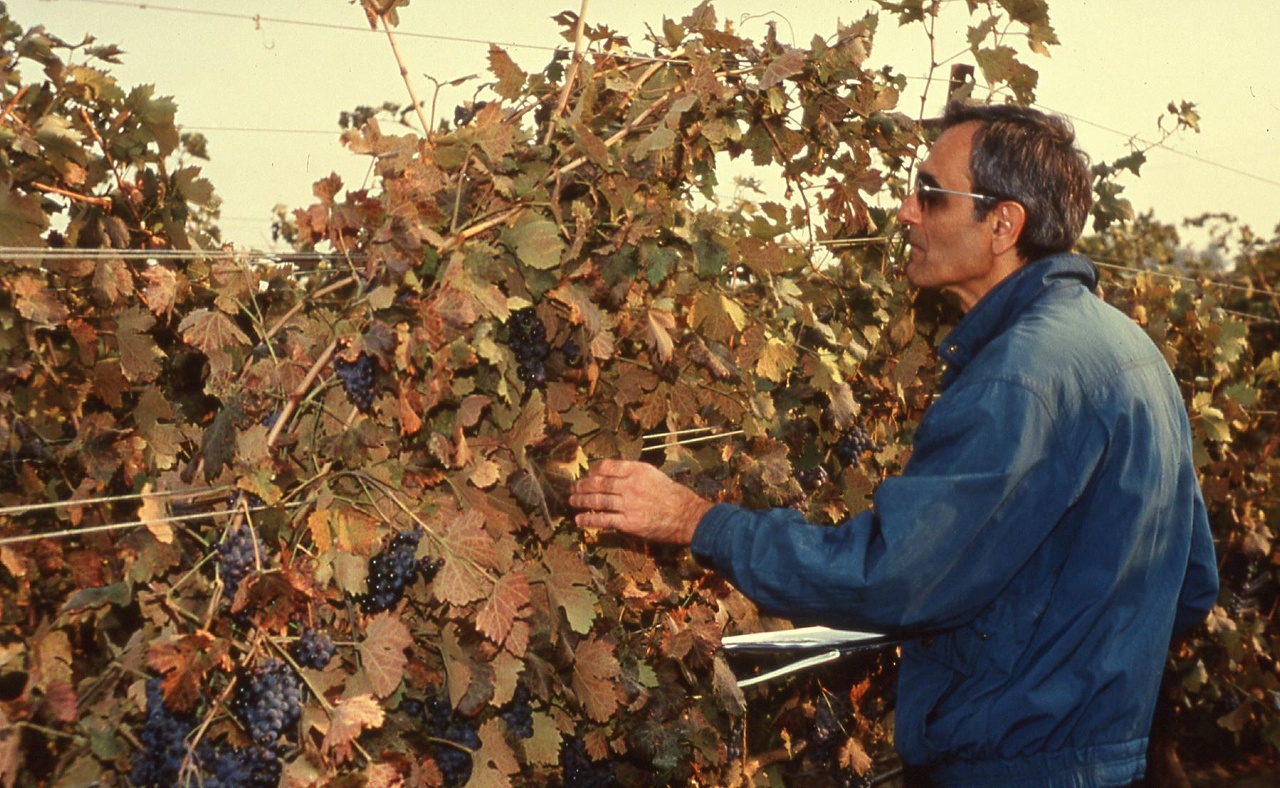
At the time Rowhani started at FPMS, the foundation grapevines included in the California Grapevine Registration & Certification Program were planted in the Hopkins Road Foundation Vineyard as well as in the Department of Viticulture vineyards further south off Hopkins Road. The “Hopkins Road foundation vineyard” was located near where the parking lot adjacent to the current UC Davis Mail Division facility is situated. The foundation vines in the Hopkins Road vineyard and Viticulture vineyard were interplanted with vines that suffered from virus and vines that had not been tested for disease.
The Department of Viticulture vines ended up in the certification program out of necessity. If a grower wanted a particular variety that was not already included in the FPMS Hopkins Road foundation vineyard, Goheen would identify a vine of the desired variety in the Department of Viticulture vineyard, index it and include it on the CDFA list of registered (foundation) materials if the results were negative. When CDFA came to do the required inspections of foundation vines, the inspectors, Goheen and Rowhani would first look at the vines in the FPMS Hopkins vineyard and then find and inspect the “foundation vines” interspersed in the Department of Viticulture vineyard. Rowhani indicates that the inspections took a very long time.
Although the FPMS “foundation vineyard” west of Hopkins Road included certified grapevine selections in the late 1980’s, to Rowhani’s eyes, many of the vines were obviously diseased. The 20- to 30-year old vines were head trained on posts and exhibited symptoms of trunk and virus disease and eutypa. Diseased vines were growing next to apparently healthy vines. Rowhani describes many of the diseased vines as “really miserable” in appearance.
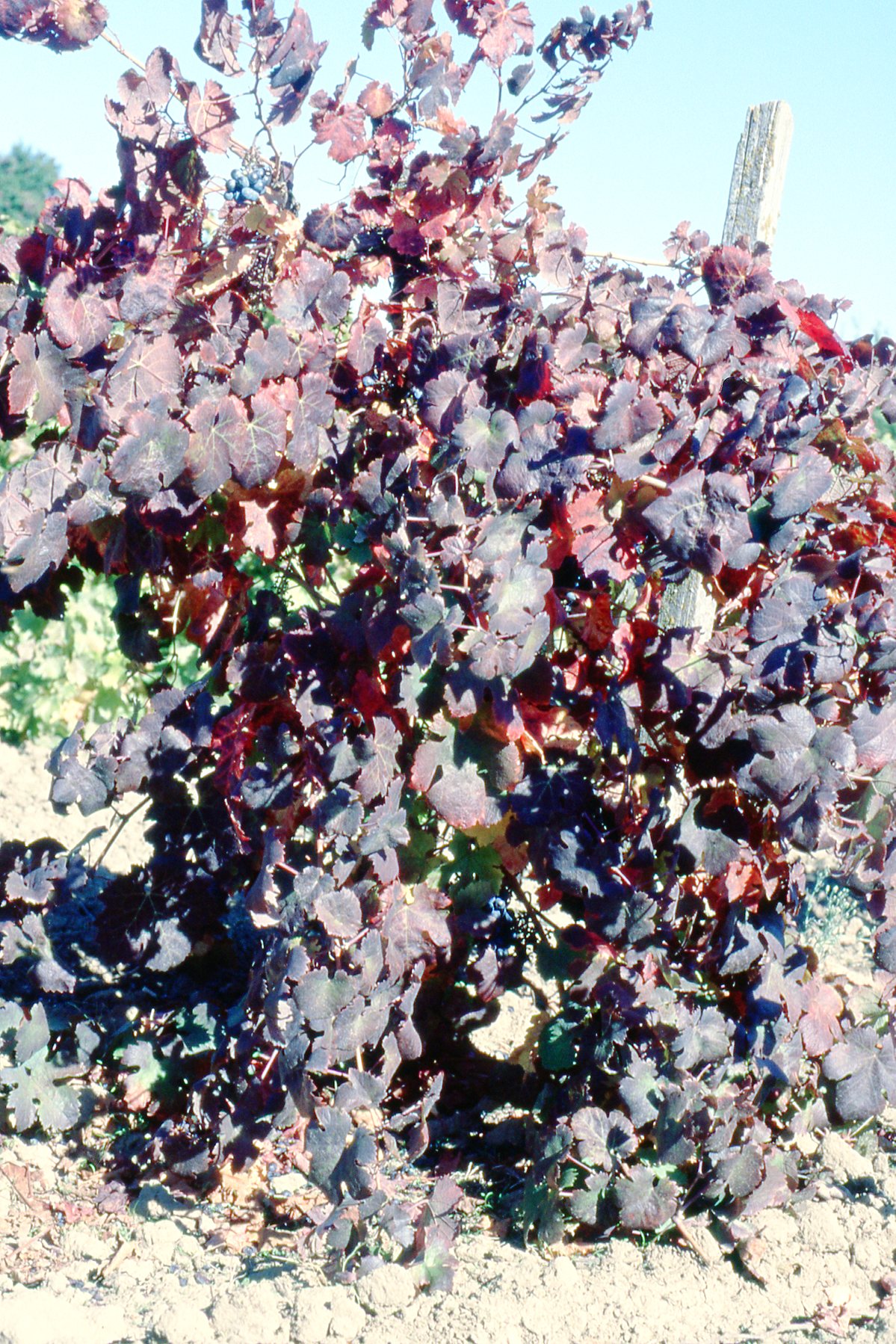 Charbono in Hopkins vineyard, 1980’s |
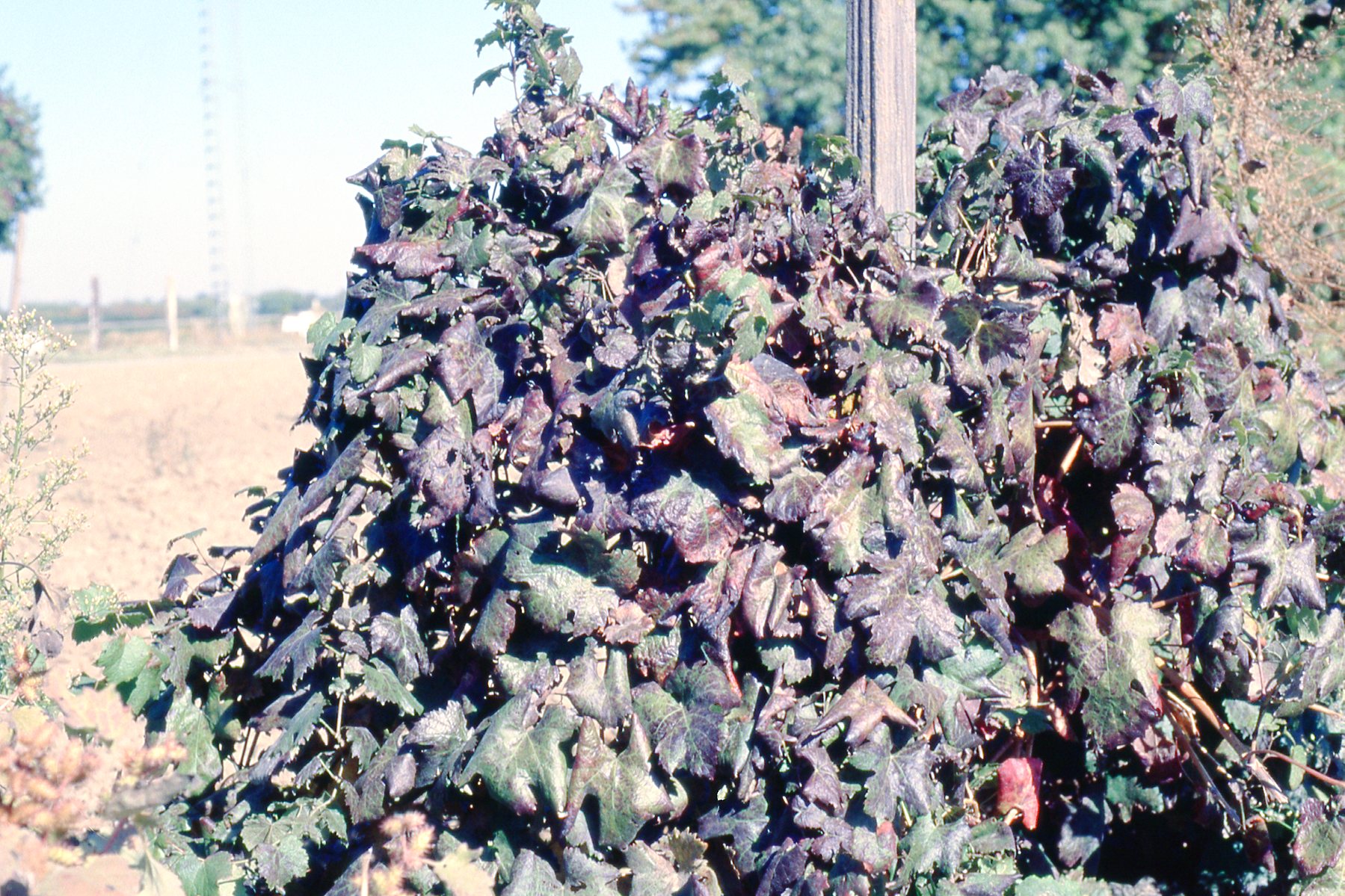 Lagrein in Hopkins vineyard, 1980’s |
Goheen did not believe that the sickly vines suffered from viruses. He believed that the sickly vines were the product of poor cultural practices and phylloxera. 33 Interview with Adib Rowhani, January 29, 2018. At that time, the science was not clear on whether virus spread from vine to vine and on mealybug’s role in that spread. Goheen believed that leafroll viruses did not spread vine to vine, and the UC Davis vineyards were managed with that philosophy. Additionally, foundation vines were not habitually retested since it was believed that virus did not spread and there was no need for retesting once a vine tested negative for virus. The discovery that mealybugs spread leafroll virus was not generally accepted until the early to mid-1990’s.
Traditional field index and herbaceous host index testing were the only tests used on grapevines for the California Grapevine R&C Program at FPMS when Rowhani was hired in 1988. He initiated a major upgrade in disease testing around 1990 after Goheen retired. Rowhani developed a laboratory program to implement newer, more sensitive, faster, and cheaper testing methods for screening plants for grape diseases. 34 “RSP and the CA Grapevine R&C Regulations” FPMS Grape Program Newsletter, October 2000, page 7.
The first major molecular test Rowhani implemented at FPMS was the “ELISA test”, which screened for a range of suspected “known” viruses and virus strains. The enzyme linked immunosorbant assay (ELISA) is a rapid, cost effective serological test for detecting viruses in woody plants. ELISA has its limitations, one of which is that the test lacks the sensitivity to reliably detect viruses when they occur in low titers.
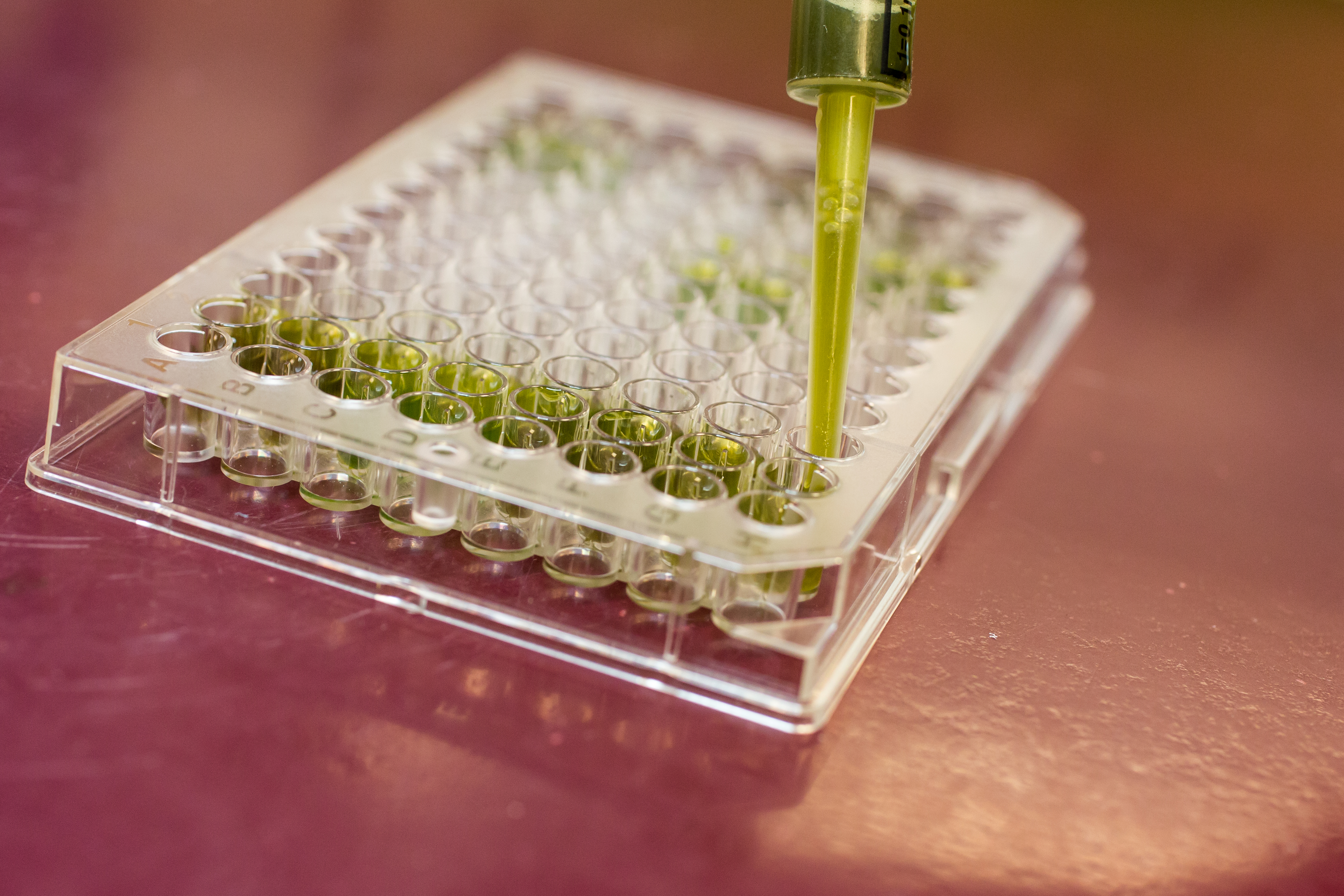 |
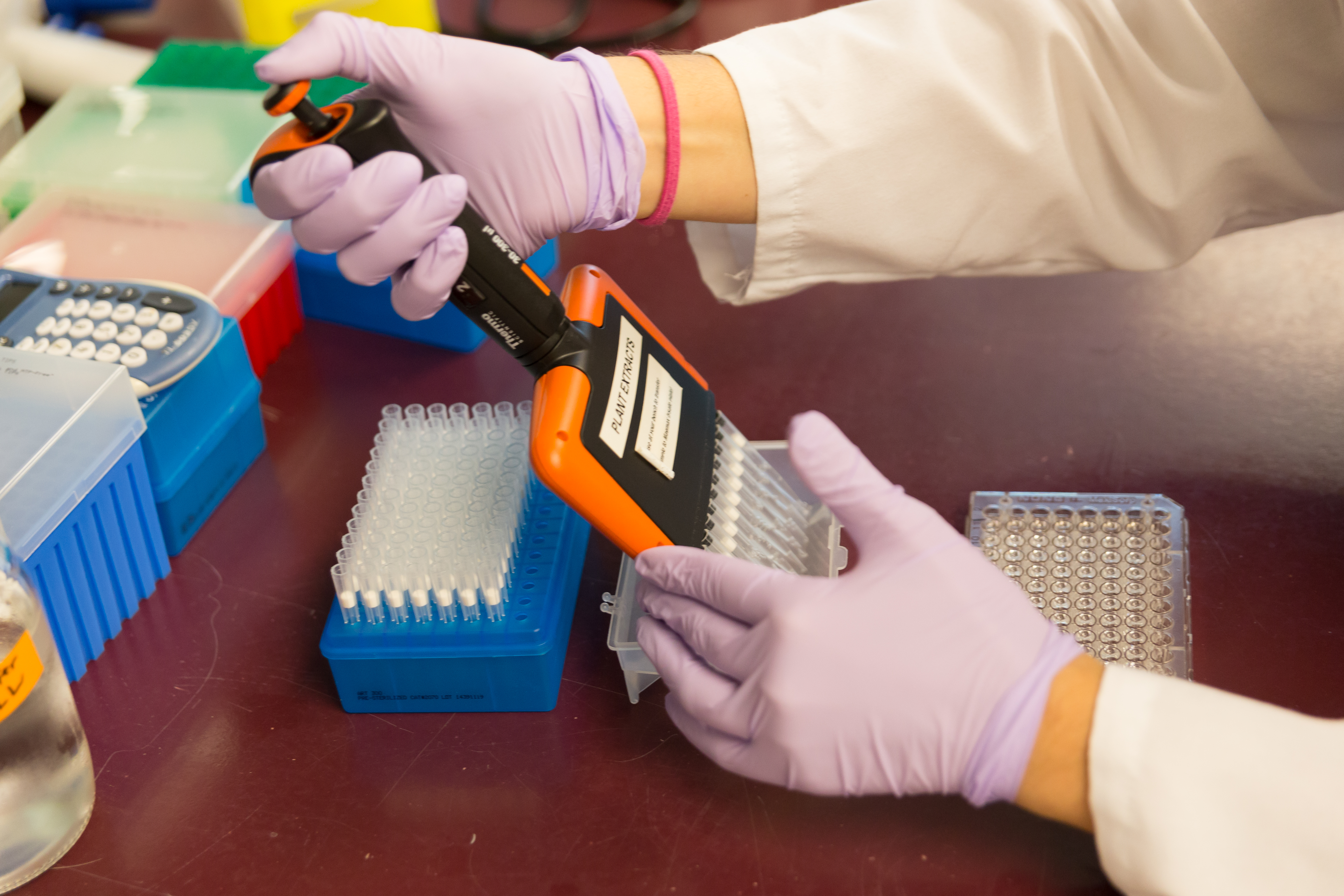 |
Additionally, the highly purified virus preparations required to produce antisera needed for the ELISA test were often difficult to obtain in the late 1980’s. 35 Adib Rowhani, “PCR for the Future”, FPMS Grape Program Newsletter, October 1999, page 9. At the outset, Rowhani obtained the antibodies needed for grapevine testing for leafroll virus from Plant Pathologist Dennis Gonsalves at Cornell University in New York. Rowhani then purified his own virus at FPMS. Notwithstanding the limitations, the ELISA test proved to be an effective detector of virus in FPMS grape material in the 1990’s.
Disease threats to FPMS vineyard
Rowhani’s skills would be tested by serious disease issues affecting the FPMS grapevine collection in the 1980’s and 1990’s. Two major setbacks were experienced when serious viruses threatened the clean plant program in 1989 (fanleaf degeneration) and 1992-93 (leafroll virus). Fanleaf degeneration and leafroll virus are two of the most destructive diseases to grapevines. Industry confidence in FPMS’ ability to provide grape material free of viruses was shaken by the two episodes. Rowhani was instrumental in sorting out the problems.
Fanleaf virus
In 1989, fanleaf infection was found in San Joaquin County in certified stock released through the California Grapevine R&C Program. Rowhani was at the time developing the fanleaf ELISA testing protocol for FPMS. It was not until an ELISA test for fanleaf virus was available in the 1980’s that FPMS realized that the fanleaf virus had passed through the index process undetected in foundation grapevine material.
When the fanleaf virus was discovered in a certified grape nursery in San Joaquin County in 1989, CDFA required that FPMS test the entire foundation vineyard for fanleaf virus using the new technology before it would allow any of the vines to continue to be registered. ELISA testing can be an effective diagnostic tool for certain diseases such as fanleaf degeneration where a single virus or bacterium is responsible for causing disease. FPMS subjected all the registered foundation vines and non-registered blocks to ELISA testing in 1990. The culprit turned out to be Nebbiolo fino 01, which was the only FPMS selection that tested positive for fanleaf virus. 36 Minutes, FPMS Viticulture Technical Committee Meeting, August 3, 1990, FPS collection AR-050, box 23: 13, Department of Special Collections, Shields Library, UC Davis.
Nebbiolo fino 01 attained registered status in the Grapevine R&C Program in 1970 by testing negative for all the prohibited viruses on the field index test. The selection was planted in the Hopkins Foundation Vineyard in 1966 (F12 v13-14) and in the Brooks South Foundation Vineyard in 1984 (BKS G6 v9-10). The original material had been collected from the old UC Foothill Experiment Station vineyard near Jackson, California.
The mother vines for the Nebbiolo fino budwood were the suspected source of the infection. FPS Program Manager Curtis Alley had had a problem during the index testing process. Somehow the original Nebbiolo budwood was combined with another selection from a different source vine that had the same number of heat treatment days. Nebbiolo fino 01 tested positive for fanleaf virus at FPMS on July 2, 1990, using the new ELISA testing method. The Nebbiolo fino 01 vines were removed from the Hopkins Foundation Vineyard and from the Brooks South Vineyard. 37 “Testing of the Foundation Vineyard for Fanleaf Virus with ELISA”, FPMS Newsletter, no. 10, November 1990, p. 2.
CDFA tested all increase blocks in the R&C Program and advised all nurseries and growers to tell their customers about the fanleaf problem. The discovery of fanleaf virus necessitated a review of the entire program. CDFA was concerned with brokering sales between nurseries, replants and top-working on increase blocks, tracking sales of FPMS material and transferring certified material between participants in the program. 38 Report from FPMS Technical Advisory Committee, April 23, 1990; Minutes, FPMS Grape Subcommittee Meeting, December 13, 1989, included in 1990 Annual Report; both documents on file in FPS collection AR-050, box 29: 49, Department of Special Collections, Shields Library, UC Davis.
The fanleaf issue did cause consternation amongst nurseries and growers. FPMS Grape Program Manager Susan Nelson-Kluk saw a positive side to the crisis. She believed that the episode significantly increased nursery awareness of viruses due to the extensive testing conducted for fanleaf virus in 1989-1990.
Leafroll virus
The fanleaf scare was followed a few years later by discovery of leafroll virus in the FPMS vineyard. Rowhani had worked since 1988 on developing ELISA testing for leafroll detection in FPMS vines. In 1992, he tested one vine of each registered grape selection in the FPMS foundation vineyards for three leafroll associated viruses using the recently-developed ELISA technology. Molecular tests for virus are specific to each virus, so a separate test was developed for each leafroll-associated virus. The results of the testing caused much upheaval in the industry.
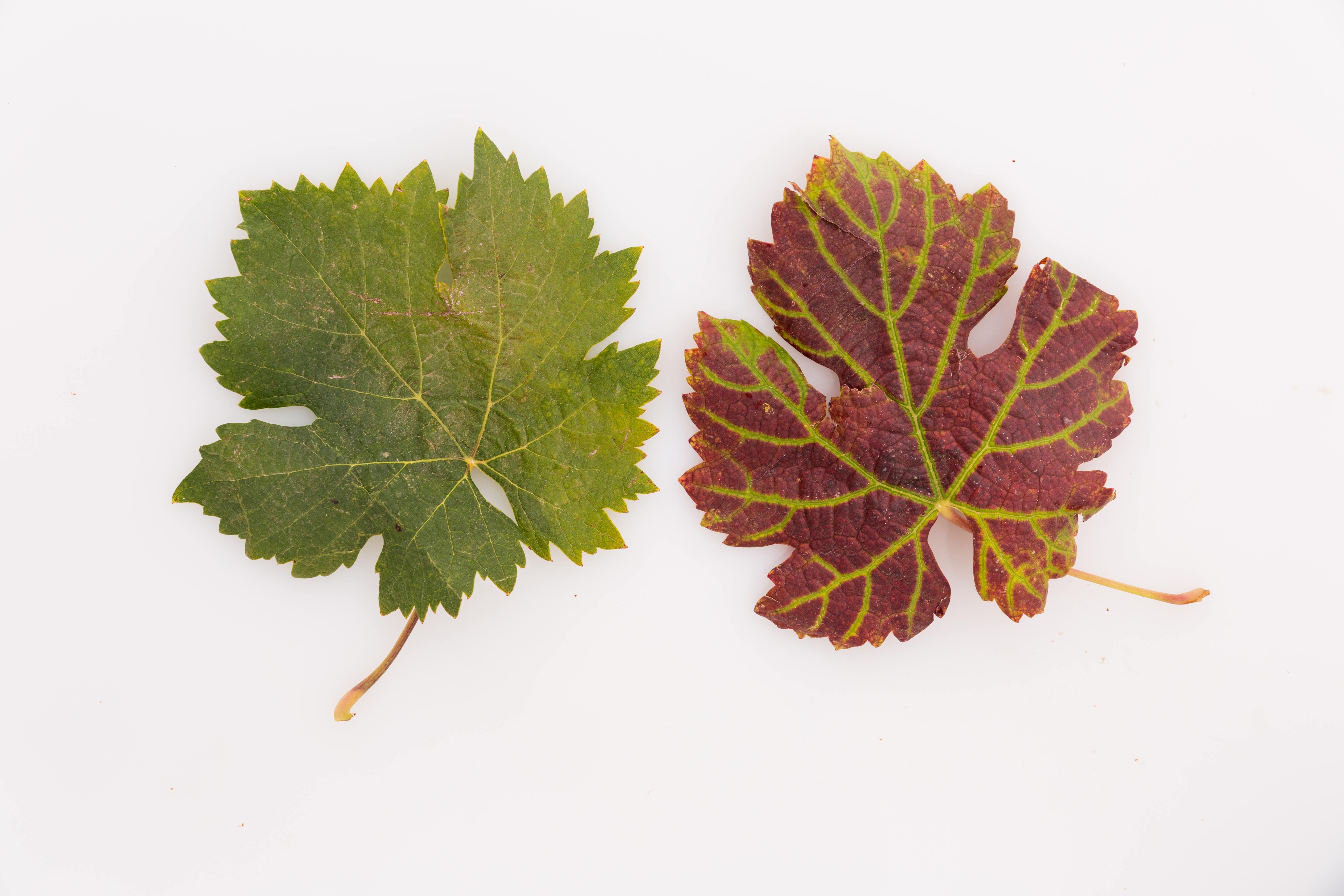
In October of 1992, Rowhani reported to the FPMS Grape Technical Committee that preliminary testing revealed approximately 20% of the rootstock and scion foundation vines tested positive for grapevine leafroll virus, mostly strain 3. 39 Memo dated October 2, 1992, covering Minutes of Grapevine Technical Advisory Committee Meeting, September 28, 1992, FPS collection AR-050, box 23: 13, Department of Special Collections, Shields Library, UC Davis. All the ELISA-positive vines were in the old Hopkins Foundation Vineyard west of Hopkins Road and had been propagated from sources that previously tested negative on the field index test. ELISA technology was still relatively new at the time, so the Committee felt that registration of the vines should not be changed based solely on the preliminary results and that further study was necessary.
CDFA and UC Davis decided not to distribute foundation stock from vines that tested positive using the ELISA testing. Distribution was limited that year to registered vines in the Brooks Foundation Vineyard (BKS and BKN). 40 “Grapevine Leafroll Associated Virus Testing by ELISA”, FPMS Newsletter, no. 13, October 1993, p. 2. The amount of foundation stock available from FPMS in 1992-93 was severely reduced because only foundation vines testing negative for leafroll virus were used to fill orders after 1992. 41 Minutes, FPMS Grape Industry and Technical Advisory Committee Meeting, March 23, 1993, FPS collection, AR-050, box 23: 14, Department of Special Collections, Shields Library, UC Davis. In March, 1993, the FPMS Grape Industry Advisory Committee and Technical Advisory Committee were combined into a single committee named the FPMS Grapevine Advisory Board. Glen Stoller was elected to replace Phil Freese as chair of the committee. Minutes, FPMS Grape Industry and Technical Advisory Committee Meeting, March 23, 1993, AR-050, box 23: 14.
Rowhani recalls that there were many meetings between industry, nurseries, state and university attendees during this period, along with much shouting by unhappy people who had invested hundreds of thousands of dollars in foundation material. Ultimately, CDFA and the nurseries negotiated a two-year grace period to allow the nurseries time to sort through and purge their inventory.
Extensive retesting of the FPMS foundation vineyards was conducted in 1992-1993. Final ELISA results for 1992-93 showed that approximately 1% of the rootstock and 29% of the scion vines in the old Hopkins Foundation Vineyard tested positive for leafroll virus. 13.8% of the scion vines in Brooks North (BKN) tested positive, while only 2.5% of the vines (rootstocks and scions) in Brooks South (BKS) were positive.
All vines in the Brooks blocks had been propagated from the old Hopkins Foundation Vineyard. Experts at FPMS concluded that the results suggested the onset of significant leafroll disease in the old Hopkins Vineyard primarily between 1983 and 1988. The 1983 planting of Brooks South resulted in a relatively low level of infection (2.5%), while the 1988 planting of Brooks North resulted in a much higher level of disease (13.8%). 42 Ed Weber, Adib Rowhani, and Deborah Golino, “The Current Status of Leafroll Infections in FPMS Vineyards”, presented at the GRAPEVINE VIRUS & CERTIFICATION ISSUES FORUM, 44th Annual Meeting of the American Society for Enology and Viticulture, June 25, 1993, Sacramento, CA, FPS collection AR-050, box 34: 8, Department of Special Collections, Shields Library, UC Davis.
The leafroll experience raised two important issues related to virus in the FPMS collection. First, the focus in the retesting was on whether scientists could confirm the correlation between the disease “grapevine leafroll associated viruses” and the positive ELISA results. The preliminary testing revealed that ELISA results did not always correlate with results from the Cabernet franc woody index tests. 43 Minutes, Grape Technical Committee Meeting, January 22, 1991, FPS collection AR-050, box 23: 13, Department of Special Collections, Shields Library, UC Davis.
A Grapevine Certification Workgroup composed of industry, University and CDFA scientists was formed to explore further the relationship between Cabernet franc index testing and ELISA testing and other issues. The Grape Certification Workgroup also educated the industry about leafroll virus and ELISA testing by distributing a flier entitled “Disease Testing of California Certified Grape Stock”. 44 FPS collection AR-050, box 23: 13, Department of Special Collections, Shields Library, UC Davis.
The second significant finding established by the 1992-1994 leafroll incident was a new perspective on the spread of leafroll virus in a vineyard. The California R&C Program was guided at the outset by two assumptions about grapevine leafroll disease. The existing scientific opinion before 1992 was that grapevine leafroll viruses spread only by grafting healthy stock with infected stock and that leafroll virus did not spread naturally in vineyards. 45 Rowhani, Adib and Deborah Golino. “ELISA test reveals new information about leafroll disease”, California Agriculture 49(1): 26-29 (1995); Goheen, A.C., W.B. Hewitt and C.J. Alley. “Studies of Grape Leafroll in California”, Am.J.Enol.Vitic. 10(2): 78-84 (1959); Austin C. Goheen, 'Virus Diseases and Grapevine Selection', AmJ.Enol.Vitic. 40(1): 67, 69-70; Minutes from Meeting of FPMS, CDFA and Grape R&C participants, March 18, 1981, filed FPS collection AR-050, box 23: 10, Department of Special Collections, Shields Library, UC Davis. The second assumption was that the viruses that caused leafroll disease were evenly distributed through infected vines. 46 Rowhani, Adib and Deborah Golino. “ELISA test reveals new information about leafroll disease”, California Agriculture 49(1): 26-29 (1995).
In the early 1990’s, no insect vectors of leafroll were known. Spread of leafroll virus by root grafting rarely occurred in grapevines. Mechanical spread (e.g., with pruning shears) of leafroll virus had never been demonstrated. As a result, mixed plantings (infected/healthy vines) had been tolerated by FPMS in or near the Armstrong and Hopkins Foundation Vineyards and the Tyree Vineyard for RSP-positive selections. 47 Author interviews with FPS Production Manager Mike Cunningham (February 24, 2015) and FPS Grape Program Manager Susan Nelson-Kluk (July 21, 2014). The mixed plantings had been tolerated because there had been interest in maintaining certain leafroll-infected selections, and FPMS vineyard space was limited.
Rowhani believed that there was evidence that leafroll associated viruses were spreading within the old Hopkins Foundation Vineyard. The theory was that spread occurred when diseased vines were planted next to healthy wood, and resulting infected wood was then used to propagate vines for planting in the Brooks Vineyards. Rowhani felt that the infection was recent, evident from uneven distribution within single vines. He observed that multiple vines from the same original source vine showed different results. Although he had no evidence of a vector, he felt that it could no longer be assumed that the only way leafroll spread was by grafting. 48 Minutes, Grape Advisory Committee Meeting, November 19, 1992, included in 1993 Annual Report, FPS collection AR-050, box 29: 48, Department of Special Collections, Shields Library, UC Davis.
The discovery of leafroll in the foundation vines led to several operational changes at FPMS. The old Hopkins Foundation Vineyard was no longer used for propagation of vines for the certification program. All mother vines in mixed plantings were abandoned. The foundation vines in the Brooks blocks had been planted initially with only Registered vines. All vines in Brooks South and Brooks North testing positive for leafroll virus were removed. Foundation vines at FPMS were limited to those remaining vines in the Brooks blocks that tested negative for leafroll virus. 49 Ed Weber, Adib Rowhani, and Deborah Golino, “The Current Status of Leafroll Infections in FPMS Vineyards”, presented at the GRAPEVINE VIRUS & CERTIFICATION ISSUES FORUM, 44th Annual Meeting of the American Society for Enology and Viticulture, June 25, 1993, Sacramento, CA, FPS collection AR-050, box 34: 8, Department of Special Collections, Shields Library, UC Davis.
As of September 1993, the only foundation grapevine material distributed by FPMS through the California R&C Program was from vines in the isolated Brooks Foundation Vineyard. That restriction reduced the number of cuttings sold in 1993-94 (49,400) by 75% over 1991-92 (200,000 cuttings). 50 FPMS Annual Report 1994, FPS collection AR-050, box 23: 16, Department of Special Collections, Shields Library, UC Davis. Pruning, training and cultivation were used in the new Brooks vineyard to eliminate overlap of canes between foundation mother vines. The foundation vineyard would be subjected to intensive future testing. 51 Minutes, FPMS Grape Subcommittee Meeting, November 16, 1993, included in 1994 FPMS Annual Report, FPS collection AR-050, box 29: 48; FPMS Newsletter, no. 13, October 1993, page 2; Memo from Susan Nelson-Kluk to CDFA, July 2, 1993, FPS collection AR-050, box 23: 14, Department of Special Collections, Shields Library, UC Davis.
The actual mechanism of leafroll spread throughout California vineyards by way of the mealybug vector was demonstrated in research conducted in the 1990’s by University of California scientists from Davis. A study at FPS between 1992 and 2001 revealed that four mealybug species were capable of transmitting domestic isolates of grapevine leafroll associated virus 3. 52 Golino, Deborah A., Susan T. Sim, Raymond Gill and Adib Rowhani. “California mealybugs can spread grapevine leafroll disease”, California Agriculture (November/December) 56(6): 196-201 (2002).
In a later study, Golino and Ed Weber, UC Extension Viticulture Farm Advisor for Napa County, mapped leafroll spread in a vineyard in Napa between 2002 and 2006. Observations were made every year. Visual observations of symptomatic vines were highly correlated with lab results showing the presence of virus in the vines, which increased over time.
Golino pointed out that colored maps (shown below) were a very visual indicator of the spread of the virus throughout the Napa vineyard over the five-year period and gave the research credence with the grape grower audience. She felt that vector studies in a lab would not have had such a strong impact. The results of the study constituted the first documentation of significant and rapid field spread of leafroll disease in a California vineyard. 53 Golino, Deborah A., Ed Weber, Susan Sim, and Adib Rowhani. “Leafroll disease is spreading rapidly in a Napa Valley vineyard”, California Agriculture 62(4): 156-160 (01 October 2008).
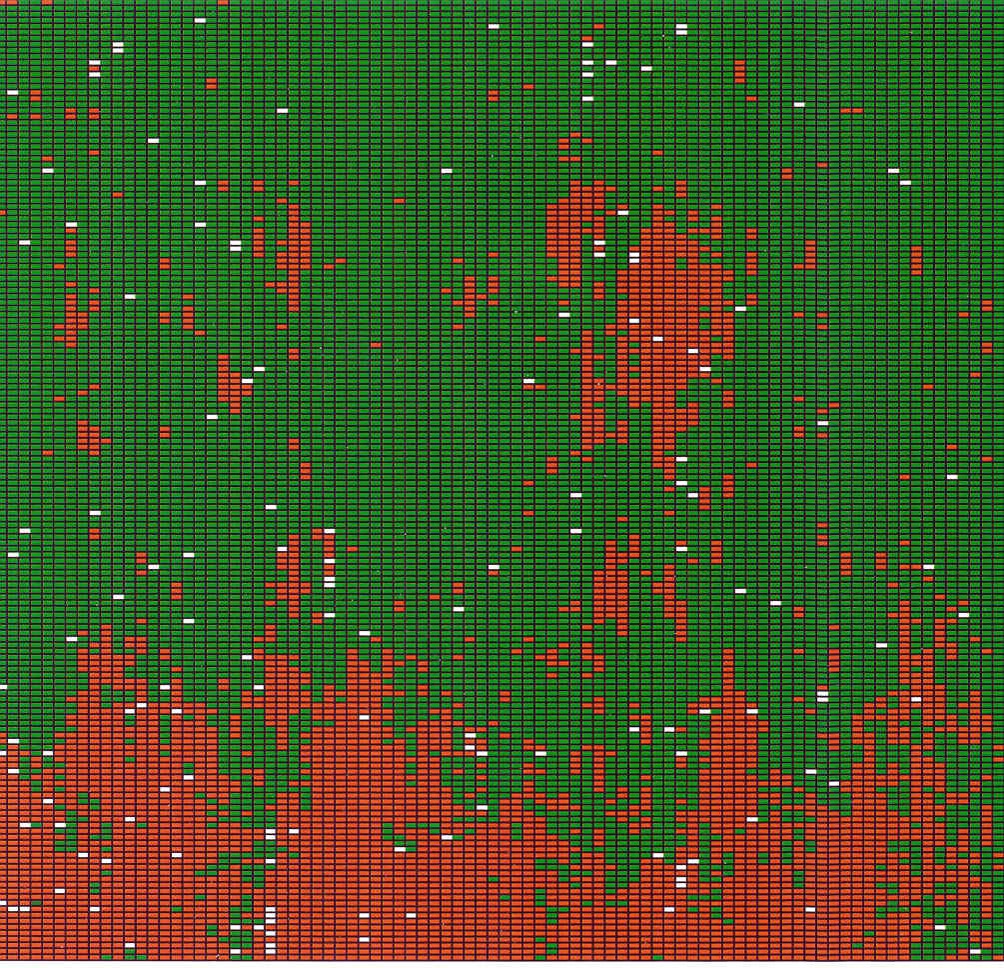 2002 (Leafroll in red, rating = 23.3%) |
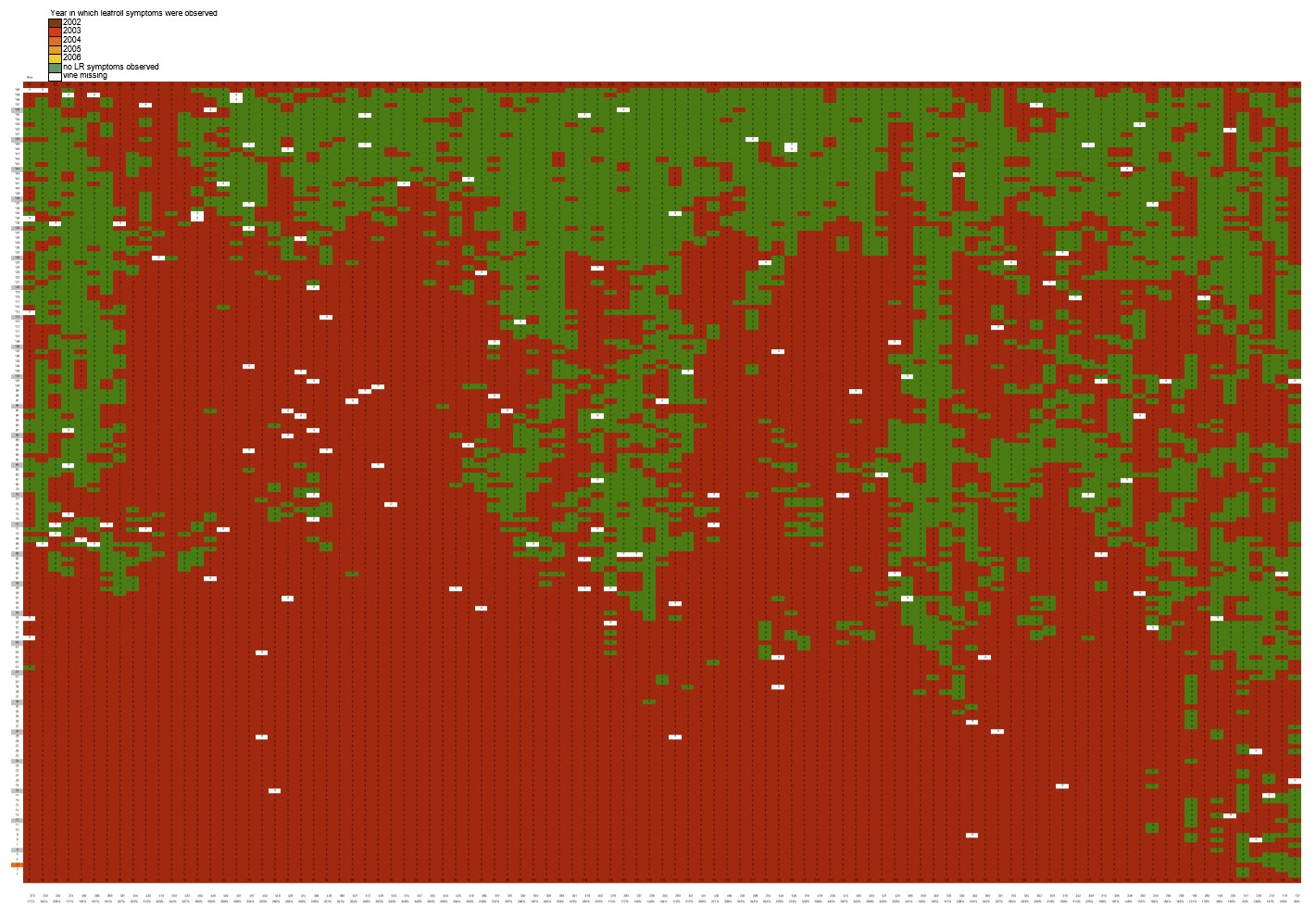
Same vineyard in 2006 |
Rowhani adopted additional molecular tests for use in the FPMS laboratories in the 1990’s as those technologies were developed. Molecular tests screen for a range of suspected “known” viruses and virus strains using a panel of specific tests. FPMS/FPS grapevine selections became subjected to a rigorous group of tests including the more traditional biological and field index and molecular tests.
One of the newer molecular tests was polymerase chain reaction (PCR), a sophisticated and sensitive laboratory test used to detect known viruses and virus-like diseases. Reverse-transcription-polymerase chain reaction (RT-PCR) is an extremely sensitive alternative to ELISA, providing the ability to detect viruses in woody plants throughout the year, even during periods of low titer. Primers are purchased or developed for specific viruses or a specific strain of a virus. Large numbers of samples may be run. Rowhani began using RT-PCR to test foundation vines in 1999.
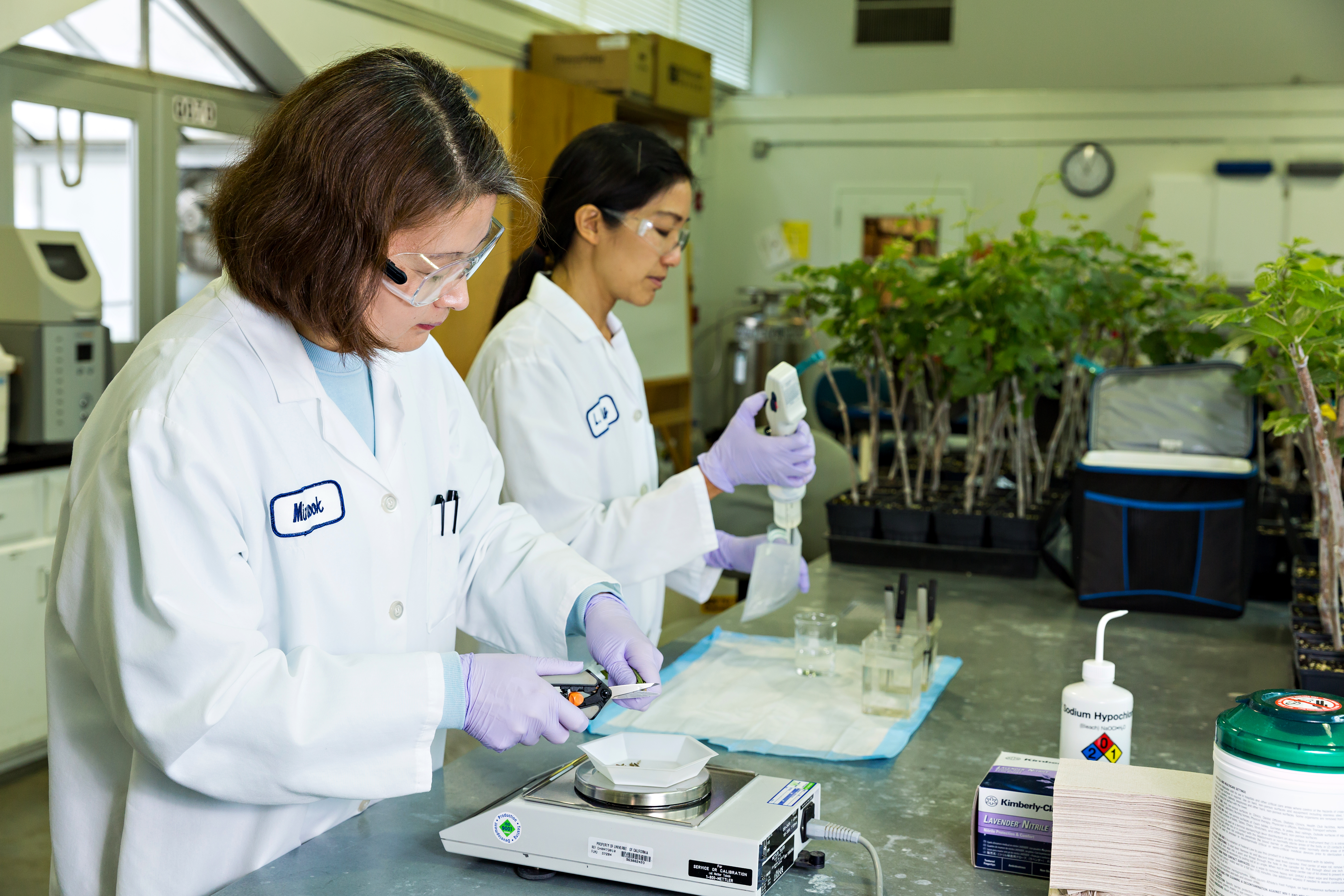 |

|
PCR tests are targeted to particular viruses. One drawback of traditional molecular testing techniques such as ELISA or PCR is that they require prior knowledge of the pathogen that is the object of the test. A genetic sequence of a known pathogen (known as a primer) is applied to a sample to match the presence of that pathogen in the sample. Traditional molecular testing methods are incapable of detecting variants, such as new strains, or new unknown agents that may be present in the sample.
The new ELISA and PCR technologies were more sensitive and revealed diseases at a much earlier stage than index testing. It was not until ELISA testing for leafroll and fanleaf viruses became available in the 1980’s that FPS realized some cultivars had diseases that had gotten through indexing. The same applied to Arabis mosaic virus in the 1990’s. Field index testing does have one advantage over the more specific PCR tests: index testing is a broad-spectrum disease detector and, theoretically, reveals the presence of all diseases in the vine, whether known or not known. 54 FPMS Grape Program Newsletter, October 1999, pp. 9-10.
Golino and Rowhani were convinced that a combination of diagnostics is preferable to use of any single technique. Traditional index testing and the newer molecular based methods exhibited different strengths and were complementary to each other in terms of making a diagnosis. FPS has for years continued to employ both index and biological testing in conjunction with molecular testing. Golino and Rowhani made the decision that at least two separate tests would be required at FPMS/FPS for a selection to be determined negative for virus for the foundation vineyard.
Adib Rowhani retired as FPS Laboratory Director in 2016. His successor would develop a new cutting-edge technology for disease testing in certification programs.

Maher Al Rwahnih
Dr. Maher Al Rwahnih assumed responsibility for matters related to plant health at FPS upon the retirement of Rowhani. He was appointed Research and Diagnostic Laboratory Director at Foundation Plant Services in 2016.
Al Rwahnih works on many viral and other infectious diseases of agronomic significance to FPS crops, which include grapes, fruit and nut trees, roses, strawberries, sweet potatoes and pistachios. His research includes developing improved molecular detection methods for previously known and exotic pathogens. He also investigates the etiology of new diseases in FPS crops. Through his efforts, FPS has become a leader among agricultural test facilities in the application of cutting-edge techniques for the diagnosis and discovery of disease agents in grapevines and fruit trees.
Al Rwahnih obtained his B.S. degree in Plant Protection in 1994 from the University of Jordan, in Amman, Jordan. He earned his M.S. degree in 2000 at the International Center for Advanced Mediterranean Agronomic Studies in Bari, Italy. Al Rwahnih was awarded a PhD in 2004 in Plant Virology from the University of Bari.
Al Rwahnih developed a connection to UC Davis while studying for his Master’s degree in Italy. He took a course from visiting lecturer Jerry Uyemoto, a USDA scientist specializing in fruit tree virology who was affiliated with the Department of Plant Pathology at UC Davis. Uyemoto facilitated Al Rwahnih’s move to Davis.
Al Rwahnih came to UC Davis from Italy on a Postdoctoral Fellowship in 2004. He initially worked directly with Adib Rowhani in the Department of Plant Pathology in the development and optimization of detection of assays for cherry viruses. Uyemoto was also associated with the project.
After the cherry viruses project was completed, Rowhani asked Al Rwahnih to work on grape viruses and attempt to identify the causal agent of a mysterious grape disease known as “Syrah decline”. Researchers had been unable to pinpoint the cause of Syrah decline, and the symptoms were similar to those seen in multiple diseases. Al Rwahnih explored all the conventional methods for diagnosing the problem but was unable to identify a cause using those methods. He decided to “think outside the box”.
A relatively new technology called high throughput sequencing (HTS), also known as next generation sequencing (NGS) or deep sequencing, had not existed as an option for diagnosis of plant viruses when Al Rwahnih started his post-doctoral appointment in 2004. When he did the initial work on Syrah decline, the HTS technology had been used only in connection with human diseases and pharmaceuticals. There were no machines for processing HTS samples on the Davis campus at that time.
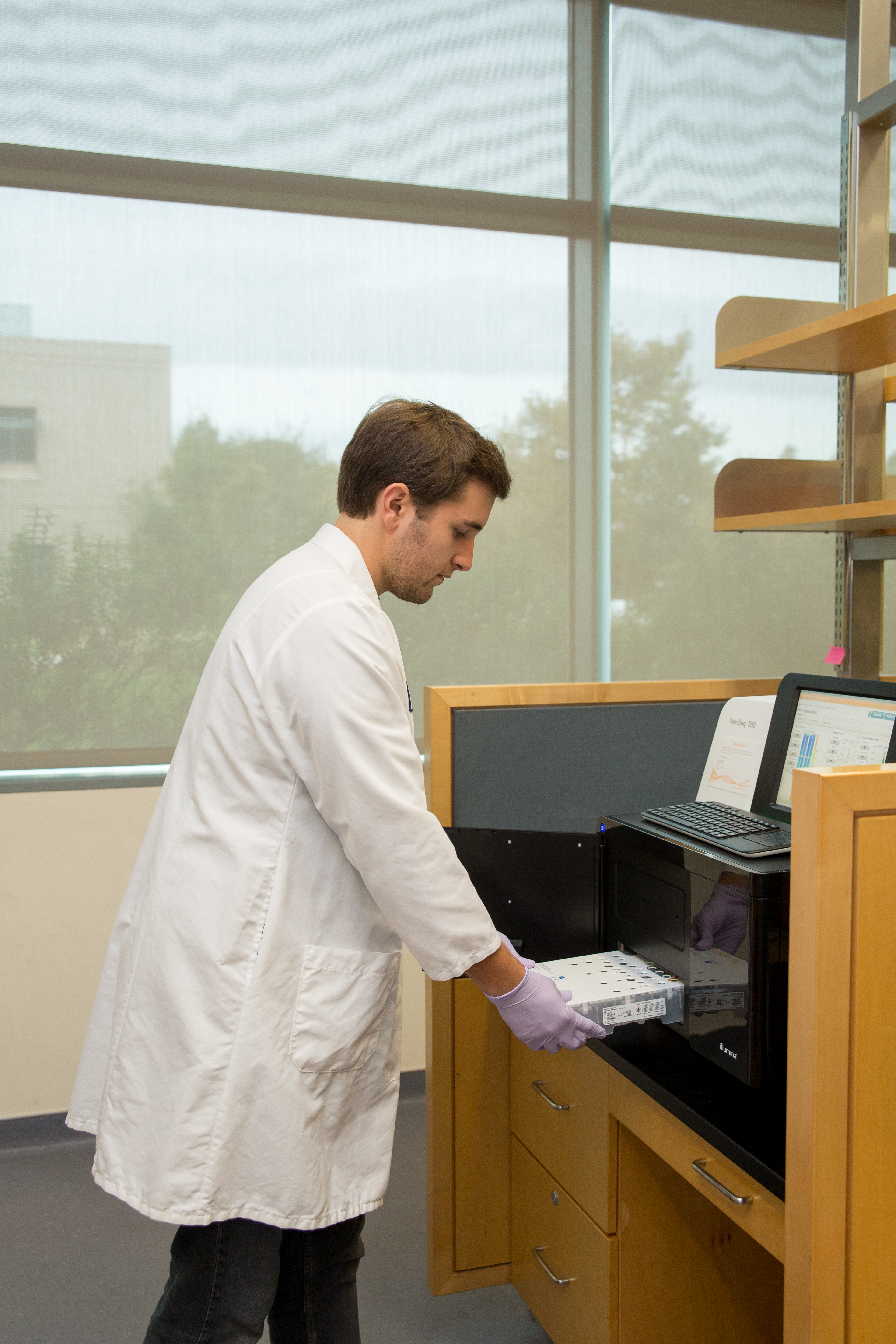 |
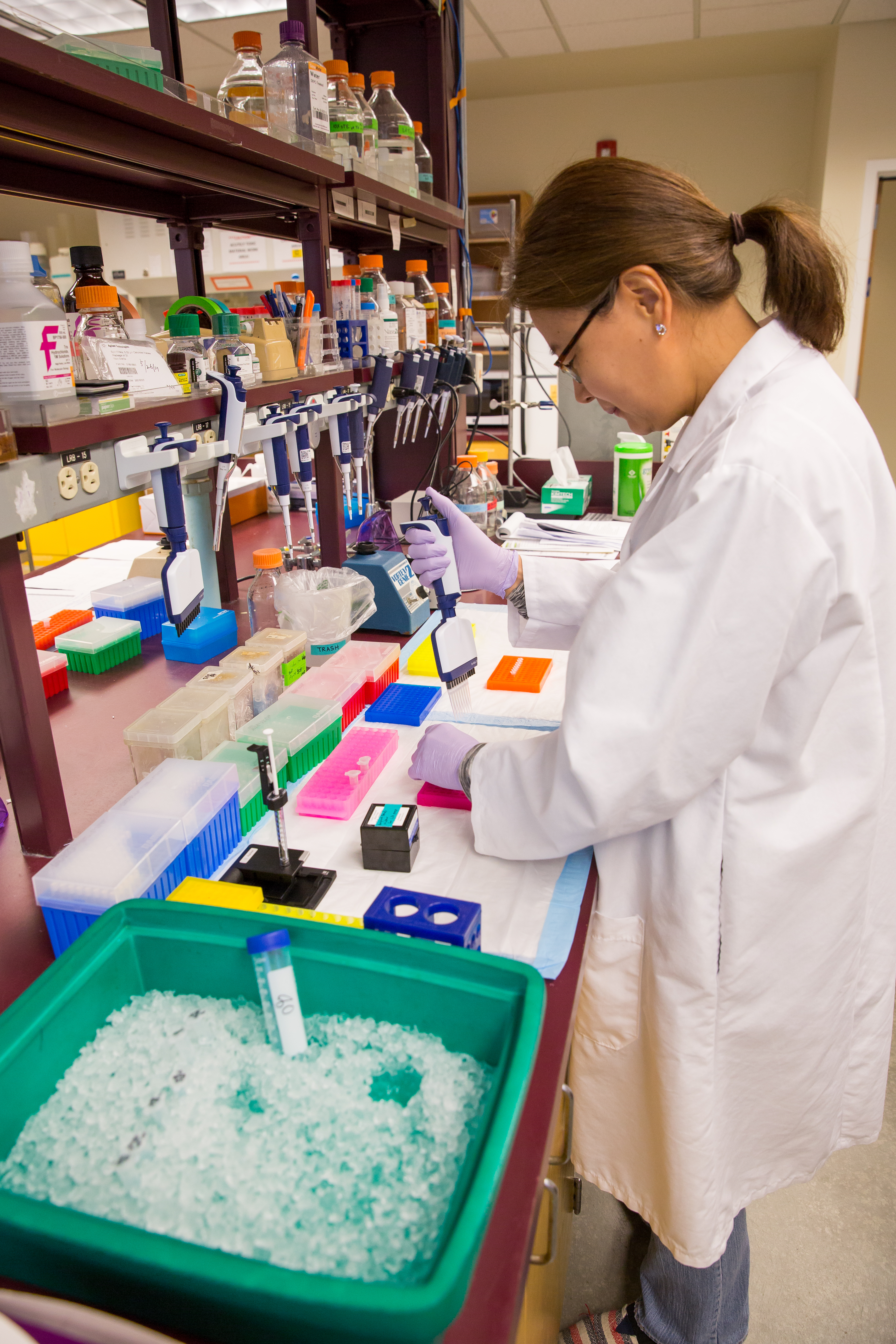 |
Al Rwahnih contacted the company that developed the HTS technology and inquired about using it to diagnose possible viruses in grapevines and other plants. The company offered to process four samples for plant viruses. The HTS technology proved effective in diagnosing plant viruses in grapevines. The ground-breaking research was reported in the journal Virology in 2009. 55 Al Rwahnih, M., Daubert S., Golino D. A., and Rowhani, A. “Deep sequencing analysis of RNAs from a grapevine showing Syrah decline symptoms reveals a multiple virus infection that includes a novel virus”, Virology, 387: 395–401 (2009).
High throughput sequencing is an extremely sensitive and thorough technology that gives a comprehensive picture of the entire microbial profile existing in infected vines. The HTS test compares nucleic acid sequences in a sample (such as a grapevine) to sequences known to be common to pathogens. HTS detects and reveals all markers and all diseases, whether known or not, that are in the grapevine sample. 56 Al Rwahnih et al., “Deep Sequencing analysis of RNAs from a grapevine showing Syrah decline symptoms reveals a multiple virus infection that includes a novel virus”, Virology 387: 395-401 (2009). One paper has stated that “the greatest advantage of HTS over other diagnostic approaches is that it gives a complete view of the viral phytosanitary status of a plant”. 57 Hans J. Maree, Adrian Fox, Maher Al Rwahih, Neil Boonham and Thierry Candresse. “Application of HTS for Routine Plant Virus Diagnostics: State of the Art and Challenges”, Frontiers in Plant Science, volume 9, article 1082, www.frontiersin.org, published 27 August 2018.
There are many advantages to the new technology. HTS does not require prior information on a DNA or RNA virus sequence against which to test the candidate plant. The HTS test will reveal all sequences present in the candidate plant. HTS generates millions of “reads” very rapidly. One HTS run takes about one day and can produce hundreds of millions of reads (nucleic acid sequences). The time difference for detection of pathogens can be reduced from a matter of years (with the more traditional bioassay or field index) to a matter of weeks (HTS). Grapevine material can be screened for nucleic acid sequences allowing for early detection of diseases.
One of the challenges with using HTS technology relates to its broad-brush approach to pathogen detection. HTS is sensitive in detecting previously-unknown viruses or very low asymptomatic species. The technology is very efficient in that sequences produced include all pathogens present in the plant (viruses, viroids, fungi and bacteria). Microbes of unknown pathogenicity are detected. HTS cannot reveal biological characteristics or biological importance of newly-discovered, uncharacterized nucleic acid sequences. The agronomic and viticultural significance will still have to be evaluated by observation of infected plants in order to determine the effect of the sequence on the plant. 58 Saldarelli, P., A. Giampetruzzi, H.J. Maree, and M. Al Rwahnih, “High-Throughput Sequencing: Advantages Beyond Virus Identification”, Grapevine Viruses: Molecular Biology, Diagnostics and Management, eds. Baozhong Meng, Giovanni P. Martelli, Deborah A. Golino, and Marc Fuchs (Springer International Publishing, AG 2017), ch. 30, pp. 625-642.
The main goal of FPS virus testing is to identify “harmful” viruses with significant economic impact. Achieving that goal requires that scientists sort through all the sequences revealed by the HTS process to evaluate their potential impact. FPS scientists suspect that the majority of viruses identified using HTS may be background viruses that need further work to establish their biological significance.
A final challenge relates to the expense involved in using the new HTS technology. The cost per sample can be high, so the technology may be impractical for routine detection for a large number of samples.
Al Rwahnih continued his work with HTS on grapevines following the initial break-through with Syrah decline in 2009. The successes to date for HTS testing were the discovery of Grapevine red blotch virus (GRBV) and many other known and novel viruses. 59 Saldarelli, P., A. Giampetruzzi, H.J. Maree, and M. Al Rwahnih, “High-Throughput Sequencing: Advantages Beyond Virus Identification”, Grapevine Viruses: Molecular Biology, Diagnostics and Management, eds. Baozhong Meng, Giovanni P. Martelli, Deborah A. Golino, and Marc Fuchs (Springer International Publishing, AG 2017), ch. 30, p. 629; Al Rwahnih, M., Golino, D., and Rowhani, A. “First report of Grapevine Pinot gris virus infecting Grapevine in the United States”. Plant Disease, 100(5): 1030 (2016). The red blotch crisis serves as an illustrative case study on how the HTS technology both identified a problem as well as added some perspective.
Red Blotch crisis
Grapevine red blotch virus (GRBV) is in the plant virus family Geminiviridae and manifests in red grape varieties by a patchy discoloration of the leaves (red blotches). The virus is more difficult to detect visually in white grape varieties. GRBV has been shown to be the causal agent of red blotch disease, which is believed to be spread by propagation of infected plant material and transmitted by a vector, the three-cornered alfalfa leafhopper. 60 G. P. Martelli, “An Overview on Grapevine Viruses, Viroids, and the Diseases They Cause”, Grapevine Viruses: Molecular Biology, Diagnostics and Management, eds. Baozhong Meng, Giovanni P. Martelli, Deborah A. Golino, and Marc Fuchs (Springer International Publishing, AG 2017), Ch. 2, pp. 31, 40-41; Yepes, L.M., Cieniewicz, E., Krenz, B., McLane, H., Thompson, J.R., Perry, K.L., and Fuchs, M. “Causative Role of Grapevine Red Blotch Virus in Red Blotch Disease”, Phytopathology 108: 902-909 (2018); Bahder, B.W., Zalom, F.G., Jayanth, M. and Sudarshana, M.R. “Phylogoney of geminivirus coat protein sequences and digital PCR aid in identifying Spissistilus festinus as a vector of Grapevine red blotch-associated virus”, Phytopathology 106: 1223-1230 (2016). GRBV may alter berry ripening and chemistry and can cause significant economic harm from losses due to lower yields, quality price penalization and, ultimately, replanting costs. 61 Johann Martínez-Lüscher, Cassandra M. Plank, Luca Brillante, Monica L. Cooper, Rhonda J. Smith, Maher Al-Rwahnih, Runze Yu, Anita Oberholster, Raul Girardello, and S. Kaan Kultural. “Grapevine Red Blotch Virus May Reduce Carbon Translocation Leading to Impaired Grape Berry Ripening, J. Agric. Food Chem., XXXX, XXX, pubs.acs.org/JAFC, published February 5, 2019; Ricketts, K.D.; Gómez, M.I.; Fuchs, M.F.; Martinson, T.E.; Smith, R.J.; Cooper M.L.; Moyer, M.M.; Wise, A. “Mitigating the economic impact of grapevine red blotch: Optimizing disease management strategies in US Vineyards”, Am. J. Enol. Vitic. 68(1): 127-135, ajev.2016.16009.
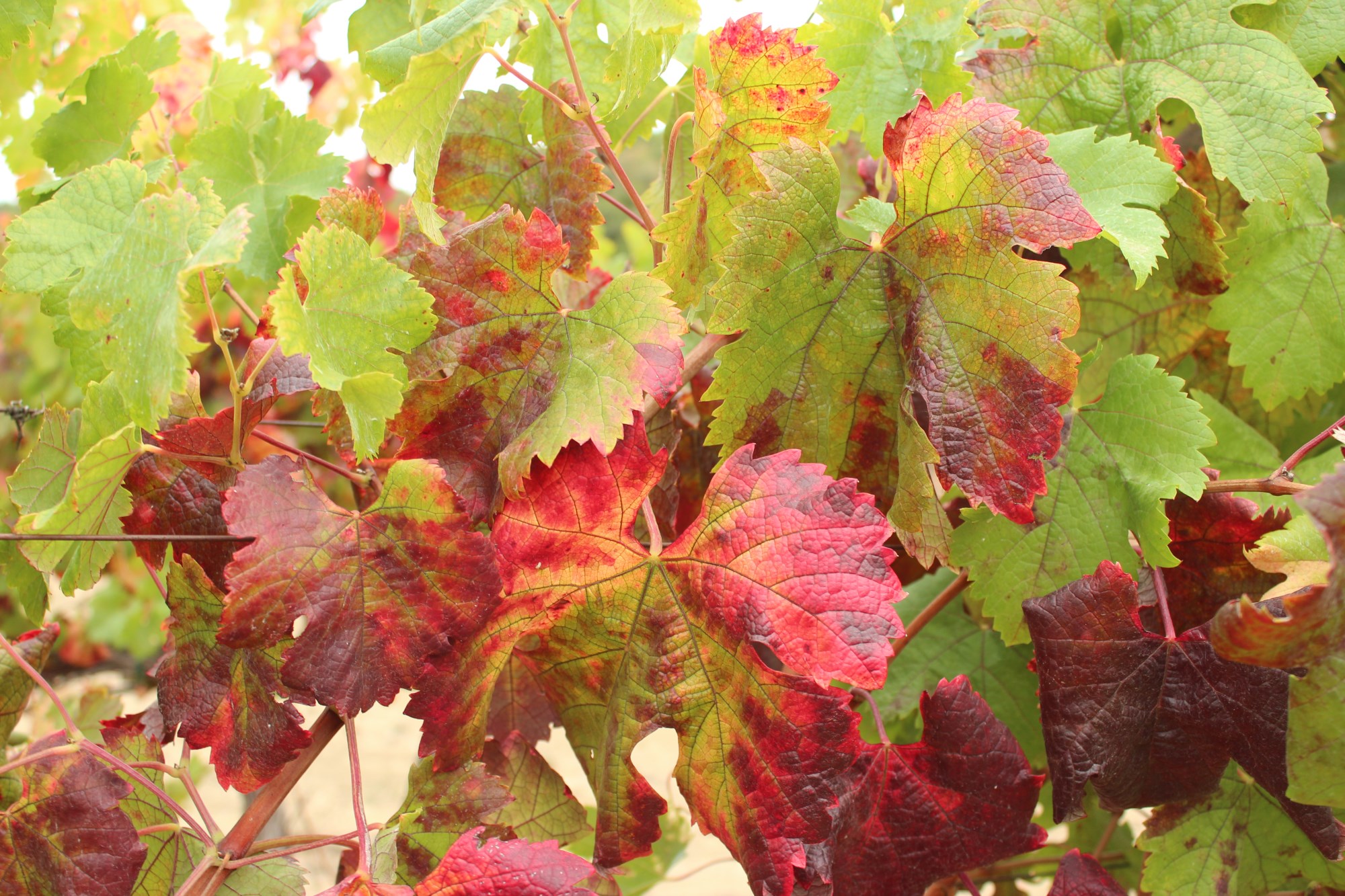
Red blotch disease was described for the first time on Cabernet Sauvignon vines in Napa Valley in 2008. Growers and winemakers started to observe ailing vineyards and reduced quality in the harvest and consulted scientists at UC Davis and the USDA. It would not be an exaggeration to say that a state of panic existed when the Red Blotch problem first came to public attention in California and elsewhere. At that time, there was much uncertainty as to the nature, cause and virulence of the then-unidentified pathogen.
The virus, GRBV, was identified in 2012. A public announcement of the epidemic and statement of known facts at the time were presented at the 17th meeting of the International Council for the Study of Viruses and Virus-Like Disease of the Grapevine (ICVG) at Davis in October, 2012. It is now known that Red Blotch disease is widespread in the United States in both cultivated grapes and free- living vines in riparian areas.
When the problem initially entered the public consciousness, much work was performed at several institutions researching what was thought to be a new virus, including HTS testing performed by Al Rwahnih at FPS, working with USDA-ARS scientist Dr. Mysore Sudarshana from UC Davis. They were able to closely associate the GRBV virus with Red Blotch disease symptoms using HTS. 62 Grapevine Viruses: Molecular Biology, Diagnostics and Management, eds. Baozhong Meng, Giovanni P. Martelli, Deborah A. Golino, and Marc Fuchs (Springer International Publishing, AG 2017), Ch. 14, pp. 303-314, Ch. 30, pp. 629-630; Al Rwahnih, M.A. Dave, M.M. Anderson, A. Rowhani, J.K. Uyemoto, and M.R. Sudarshana. “Association of a DNA virus with grapevines affected by red blotch disease in California”, Phytopathology 103: 1069-1076 (2013a).
Al Rwahnih made an additional discovery that added some perspective to the “Red Blotch panic”. The Center for Plant Diversity at UC Davis is an herbarium that houses plant specimens collected by UC faculty and others for purposes of preservation and research. Those herbarium specimens included dried leaves from an Early Burgundy grapevine collected by Harold Olmo on one of his plant exploration trips in Sonoma County in 1940 - 72 years before GRBV was conclusively identified and correlated to specific symptoms. The herbarium samples were tested for GRBV using both conventional and quantitative PCR assays. One sample was found to be positive for GRBV, indicating that the red blotch disease had existed in Sonoma County for some time. 63 Al Rwahnih, M., Rowhani, A., and Golino, D. “First report of Grapevine red blotch-associated virus in archival grapevine material from Sonoma County, California”, Plant Disease, 99 (6): 895 (2015).
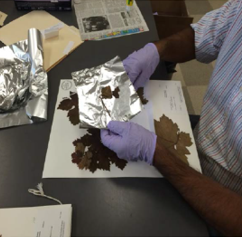 |
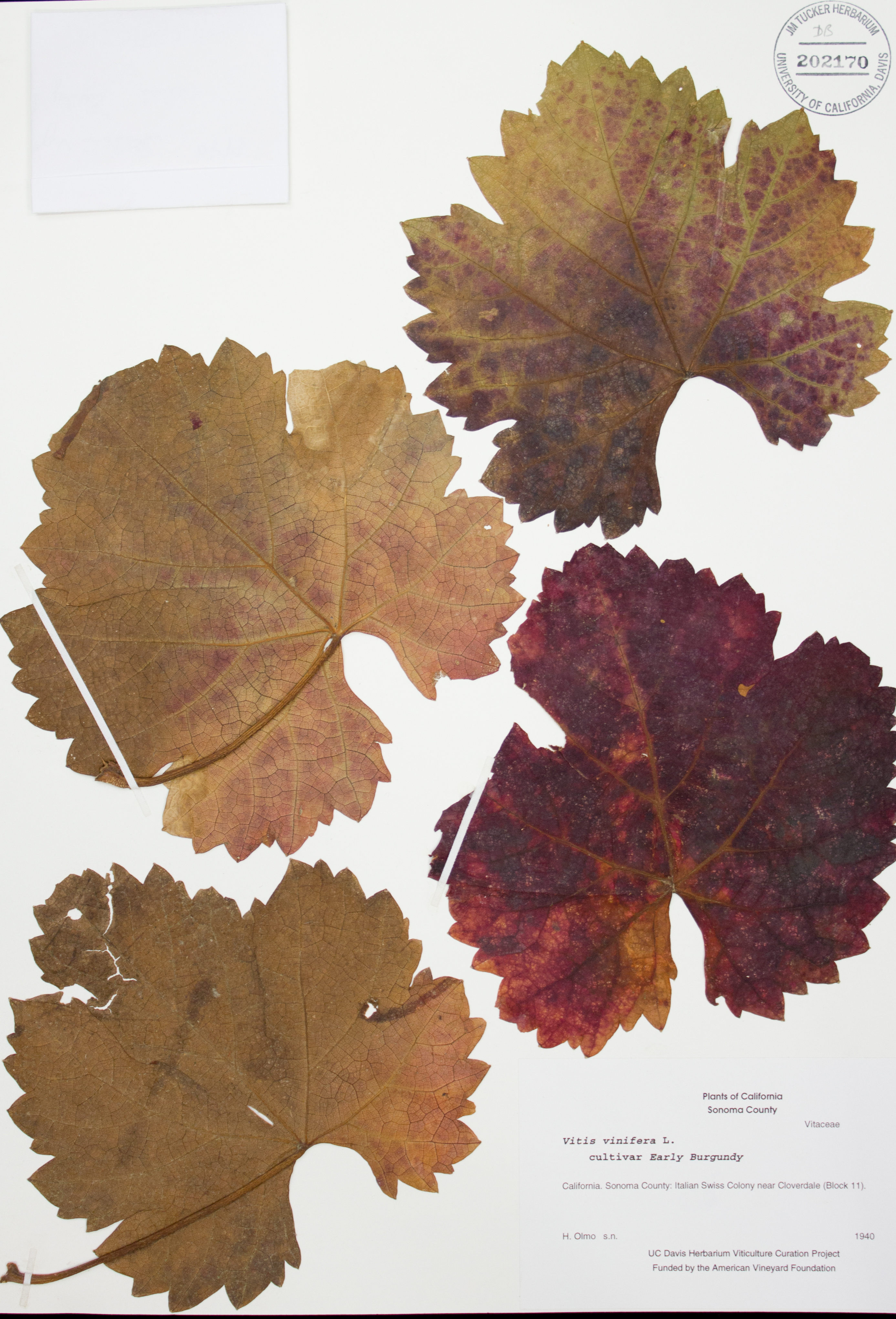 |
Red Blotch virus continues to plague vineyards throughout the country. GRBV has been added to the list of targeted viruses for the California Grapevine Registration & Certification Program, as well as to the NCPN’s 2010 Protocol testing at FPS.
FPS' Russell Ranch Foundation Vineyard (RRV) has been seriously impacted by the red blotch epidemic in California. FPS began a testing regimen for GRBV for the grapevines in its foundation vineyards in 2013.
Red blotch virus (GRBV) was first detected in the Russell Ranch foundation vineyard in 2017. Five of the 4,132 vines (0.1%) in RRV tested positive in 2017. Those vines were immediately removed and destroyed. Since then, despite significant efforts to prevent the occurrence of the disease, the infection rate in the Russell Ranch vineyard has increased to 0.5% (24 or 4,406) in 2018, 7.1% (339 of 4,761) in 2019, and 18% (788 of 4,367) in 2020.
In contrast, Red Blotch infection rates have remained extremely low in the Classic Foundation Vineyard, ranging from 0% to 0.21% since 2013. None of the 4,270 vines in the Classic vineyard were infected in 2020.
Since the discovery of red blotch in the FPS foundation vineyard, all propagated vines related to the GRBV positive vines tested negative in every case, indicating the incidence of red blotch in the Russell Ranch vineyard is due to field transmission of GRBV. In addition, material from those plants was distributed prior to the last negative test date, suggesting that the material was GRBV-free at the time of distribution. In 2018, FPS implemented a test-to-order policy that further ensures orders being shipped were negative just prior to distribution.
One of the greatest challenges in managing red blotch has been vector-mediated transmission. The three-cornered alfalfa hopper, Spissistilus festinus, has been documented as a vector in greenhouse studies and has been found in RRV. Given the threat, FPS has implemented more frequent vineyard inspections and additional spray treatments specifically targeting the vector. A comprehensive program for control of the vector has been developed. It remains unknown if other vectors are involved in the transmission of red blotch. FPS is working with University of California scientists to monitor the foundation vineyards for potential vectors and track the spread of the virus.
In October of 2020, FPS advised its customers that the best course of action was to discontinue distributing material from the Russell Ranch foundation vineyard. Grapevine material from the Classic Foundation vineyard (which represents the majority of clonal families from RRV) continues to be available for distribution to customers as of 2021. FPS tests all grapevine material for GRBV as dormant canes prior to shipping.
FPS and UC Davis planners are currently working on plans for a large greenhouse that will protect approximately 4,000 of FPS' most valued foundation grapevines. The greenhouse solution is viewed as essential to protect the material from vectors and continue to guarantee immediate access to clean plant material in case of field infection. In the interim, FPS is currently renting two greenhouses from the College of Agricultural and Environmental Sciences to temporarily house valuable clonal selections as mother vines in a protected environment.
Use of HTS as a routine diagnostic tool
Having proved that HTS can be used to reliably detect unidentified viruses in grapevines, Al Rwahnih next turned his attention to the issue of whether or not the new technology would be effective and practical as a tool for diagnosing plant viruses on a routine basis in certification programs. He compared HTS analysis against the currently mandated bioassay used in grapevine registration programs, in California and other states. The basic question was whether HTS would be better than the traditional biological indexing tests.
HTS technology was used in a side by side comparison with the traditional biological indexing tests on grapevine selections at FPS for 2 years (testing cycles). HTS proved superior in virus detection (including infections at low titers), was effective in detection of asymptomatic viral strains, was not affected by environmental conditions, and was superior in accuracy and cost to the current bioassays. Al Rwahnih’s study concluded that HTS provides the highest standard available for the certification of grapevine material as free of the major viral pathogens. 64 Al Rwahnih, M., Daubert, S., Islas, C., Golino, D.A., and Rowhani, A. “Comparison of Next Generation Sequencing vs. Biological Indexing for the optimal detection of viral pathogens in grapevine”, Phytopathology, 105:758-763 (2015); Saldarelli, P., A. Giampetruzzi, H.J. Maree, and M. Al Rwahnih, “High-Throughput Sequencing: Advantages Beyond Virus Identification”, Grapevine Viruses: Molecular Biology, Diagnostics and Management, eds. Baozhong Meng, Giovanni P. Martelli, Deborah A. Golino, and Marc Fuchs (Springer International Publishing, AG 2017), ch. 30, pp. 637-638. In 2016, Al Rwahnih received the Lee M. Hutchins Award of Distinction from the American Phytopathological Society for his work with development of HTS technology for use in grapevine virus detection, certification and introduction programs. http://www.apsnet.org/members/awards/Hutchins/Pages/MaherAlRwahnih.aspx
HTS and expedited quarantine testing
The implementation of HTS technology has had a potentially-positive impact for FPS customers and the grape and wine industry related to quarantine testing. Grape growers and winemakers have expressed frustration for years that the normal 2-year (or more) waiting period for grapevine importations undergoing quarantine testing is too long. Sponsors of imported materials are eager to develop their cultivars and clones and become frustrated by long delays waiting for release from quarantine, particularly if the material tests positive for disease and must undergo treatment and another round of testing.
Al Rwahnih’s work with HTS has resulted in a significant advance that will alleviate the long waiting periods of the past. The use of high throughput sequencing (HTS) technology reveals potential disease issues in grapevine material much quicker in time than traditional index testing. In 2017, FPS implemented a protocol that incorporates HTS into the disease testing regimen alongside the traditional methods to establish the new technology as a reliable tool. The ultimate goal was to reduce the normal 2-year time period required to move grapevine imports through the quarantine testing process. The chart below contains a comparison of the release time for grape quarantine selections with the new HTS protocol (on the left) versus the former traditional biological testing (on the right).
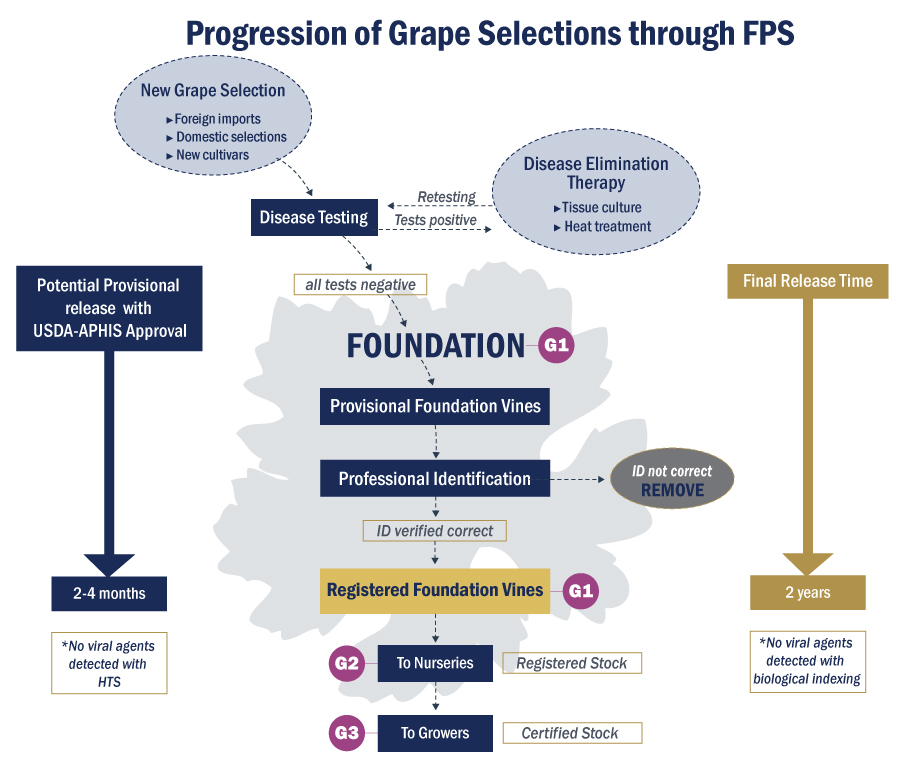
The USDA-APHIS has taken steps to incorporate HTS testing into new regulations for quarantine testing and release of imported grapevine material. The former “Departmental Permit” system under which APHIS operated for so long has undergone an overhaul in recent years. The old Departmental Permit was used by APHIS to cover several activities in one permit. The final “old [FPS] Departmental Permit” with Director Golino’s name on it expired in February, 2017.
The USDA adopted a new permit system in 2016. The new system employs several classes of permits for different activities, one of which is grapevine importation and quarantine testing. The name of the permit related to movement of plant material is now “Controlled Import Permit” (CIP). Controlled Import Permits have a more limited term, e.g., one year with a possible two-year extension. The new system was created in part to facilitate discussions between permit users and USDA-APHIS staff. Permit staff now has better access to experts in plant pathology. 65 Author interview with Erich Rudyj, Coordinator, National Clean Plant Network, USDA, APHIS, Plant Protection and Quarantine, on September 22, 2018; Golino D.A., M. Fuchs, M. Al Rwahnih, K. Farrar, A. Schmidt and G.P. Martelli, “Regulatory Aspects of Grape Viruses and Virus Diseases: Certification, Quarantine, and Harmonization”, Grapevine Viruses: Molecular Biology, Diagnostics and Management, eds. B. Meng, G.P. Martelli, D.A. Golino, and M. Fuchs (Springer International Publishing AG 2017), pp. 591-592.
FPS now manages movement of plant material under a series of Controlled Import Permits issued by USDA-APHIS for grapevines, fruit trees and roses. The new Controlled Import Permits for FPS are issued in the name of Maher Al Rwahnih. Material previously received under the old permit system was transferred to Al Rawhnih.
Four (4) separate CIP permits (PPQ 526) allow for movement of pathogens both interstate and internationally for purpose of diagnostic research. The material moved using PPQ 526 permits may be analyzed but not released to the public.
The old “Departmental Permit” used by FPS for importation and quarantine testing has been replaced by Controlled Import Permit (CIP) PPQ 588, designed to move restricted plant material internationally. Specific countries are listed in the permit. The permit authorizes release of imported plant material through a certification program after successful quarantine testing and virus elimination.
Industry members who import grapevines will experience a significant improvement with a “New Improved” CIP, which incorporates high-throughput sequencing technology. In the past, the permit system required imported grapevine material to complete traditional testing methods for release from quarantine, regardless of any HTS testing results that were completed more quickly. Those traditional methods required a period of at least two years for release, after which the grapevine nurseries developed the material for distribution to growers and wineries.
The new ePermits CIP system allows FPS to release the grapevine material from quarantine with Provisional status based on HTS testing showing that the candidate vine tests free of prohibited viruses. The HTS test results are submitted to the USDA-APHIS for approval. Once that approval is obtained, FPS may release the quarantine material to nurseries and institutions that have a “Level 2” USDA eAuthentication account as well as their own PPQ 588 CIP. The release would be in two to four months of introduction, rather than two years. The release is conditional (Provisional) subject to confirmation of negative results using the traditional biological indexing tests. Meanwhile, the wholesale grapevine nurseries in the California R&C Program can develop the quarantine selections in a greenhouse for future distribution while awaiting results of the biological testing (woody index). 66 National Clean Plant Network, “High Throughput Sequencing (HTS)”, Fact Sheet, November 2017. Theoretically, a grower with his or her own PPQ 588 CIP could also receive his or her Provisional material under the same conditions.
FPS is currently working with other scientists in the United States and abroad to develop protocols and procedures for the implementation and validation of HTS technology in screening for plant diseases. Issues include standards for testing and how and when to release materials based on the technology. According to Al Rwahnih, the difficult part is proving whether or not pathogens discovered using the new HTS technology are the causal agent of harmful viruses (known in science as “satisfying Koch’s postulates”). A complete discussion and analysis of the HTS technology is contained in Grapevine Viruses: Molecular Biology, Diagnostics and Management, chapter 30. 67 Saldarelli, P., A. Giampetruzzi, H.J. Maree, and M. Al Rwahnih, “High-Throughput Sequencing: Advantages Beyond Virus Identification”, Grapevine Viruses: Molecular Biology, Diagnostics and Management, eds. Baozhong Meng, Giovanni P. Martelli, Deborah A. Golino, and Marc Fuchs (Springer International Publishing, AG 2017), ch. 30, pp. 625-642.
FPS has been flexible and innovative over the past 60 years in developing a robust virus detection system. FPMS scientists pioneered index testing methods and heat treatment therapy in the 1960’s. Identification of new grapevine diseases and implementation of improved testing protocols to detect them resulted in regular upgrades over the years in the phytosanitary status of the foundation grapevines. Most recently, high-throughput sequencing (HTS) technology has produced a major advance in processing grapevine material out of quarantine. 68 Golino, D.A., M. Fuchs, S. Sim, K. Farrar, and G.P. Martelli, “Improvement of Grapevine Planting Stock Through Sanitary Selection and Pathogen Elimination”, Grapevine Viruses: Molecular Biology, Diagnostics and Management, eds. Baozhong Meng, Giovanni P. Martelli, Deborah A. Golino, and Marc Fuchs, (Springer International Publishing, AG 2017), Ch. 27, pp. 561-576.
FPS has also been instrumental in developing the other key component necessary for a healthy grapevine collection – treatment of diseased plant material using microshoot tip tissue culture disease elimination therapy to create a new plant that does not contain the virus.
DISEASE ELIMINATION THERAPY USING SHOOT TIP CULTURE
After Austin Goheen retired in the late 1980’s, FPMS ceased virus elimination work on grapes and held the disease-tested selections for future disease therapy. The Department of Plant Pathology reassigned Goheen’s facilities to another researcher but indicated that FPMS could continue to use the heat therapy chambers if they desired.

Photo by Jack Kelley Clark, 1997
Tissue culture therapy work began at FPMS as a result of a decision by the staff at UC Berkeley that it did not want to continue making “clean” UC strawberry plants. Plant Pathology Chair Bob Webster decided that UC Davis would accept the work. A staff person was hired from Dr. Carole Meredith’s laboratory (Department of Viticulture & Enology, UC Davis), who had been exploring the use of tissue culture for grape transformation and genetic engineering. Primitive facilities suitable for tissue culture work with a laboratory and temporary shade house were established in an FPMS building adjacent to the Viticulture & Enology headhouse on Straloch Road. Lights were strung up on metal benches in the laboratory.
Then-Program Manager Susan Nelson-Kluk began to investigate the use of shoot tip culture therapy for grapes at FPMS in the late 1980’s. Her master’s thesis at UC Davis compared two techniques for virus elimination on grapevines using tissue culture techniques. Robert Ball and Nelson-Kluk submitted a proposal to Winegrowers’ of California in 1986 to fund research work using shoot tip culture therapy for virus elimination in specific European grape clones. 71 Minutes, FPMS Industry Advisory Committee Meeting, October 10, 1986, FPS collection AR- 050, box 23: 11 and 13, Department of Special Collections, Shields Library, UC Davis. They also sought funding from the USDA-ARS for tissue culture therapy on 200 virus-infected clones identified by Goheen before his retirement. 72 Burt Ray and Susan Nelson-Kluk, Evaluation Proposal for Grant Funding from the USDA-ARS National Plant Germplasm System, June 29, 1987. In 1989, the grape industry through the group IAB began contributing funding for research relative to the tissue culture work; that funding continues through 2019.
The first shoot tip culture work performed on FPMS grape selections was done in 1988. The goal was to train staff and perfect a successful technique prior to completion of the new Grapevine Importation and Clean Stock Facility. Staff experimented with shoot tips of varying sizes in different media. The technique eventually adopted was called “microshoot tip tissue culture” therapy. FPS began to create selections using shoot tip culture in 1990. Approximately 75 FPMS selections had been cleaned up using the new technology by 1993. 73 Foundation Plant Materials Service, Newsletter, no. 13, October 1993, p. 3; Memo, “Cleaning of Grapevine Material from FSPMS Quarantine Area”, Susan Nelson-Kluk, April 3, 1990, FPS collection AR-050, box 28: 38-39, Department of Special Collections, Shields Library, UC Davis; Minutes, Grape Industry Subcommittee Meeting, November 5, 1991, included in 1992 Annual Report, AR-050, box 29: 49, FPS collection AR-050, Department of Special Collections, Shields Library, UC Davis.
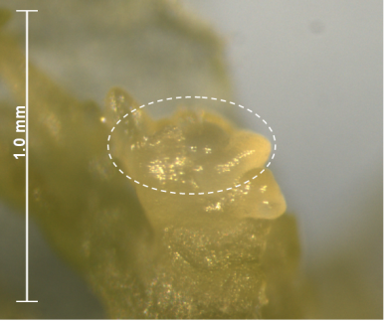
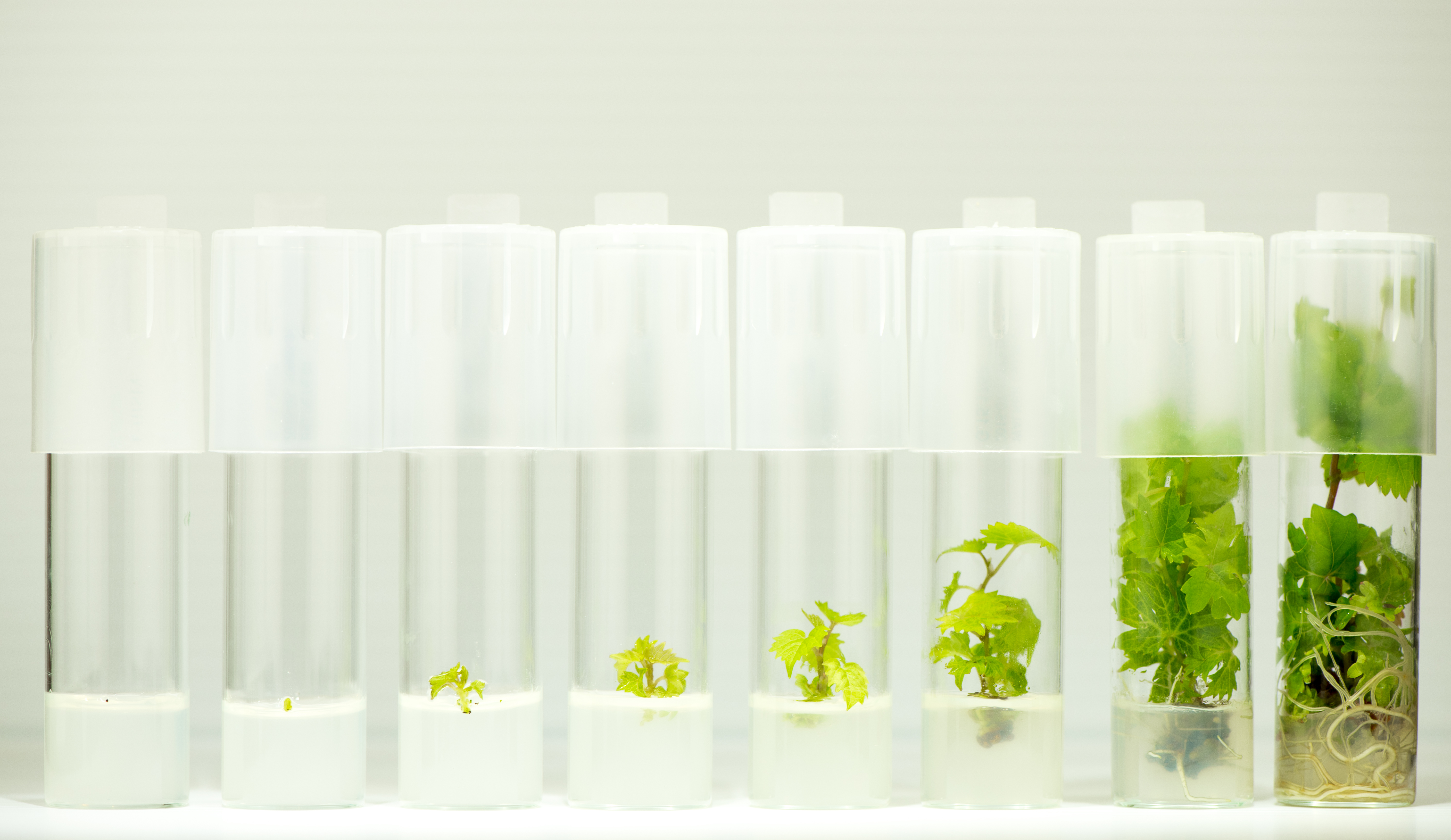
Deborah Golino explains that she, Nelson-Kluk and Rowhani cooperated to identify a protocol for appropriate media and techniques for grape tissue culture that was similar to the procedure still used at FPS in 2019. That protocol was improved over the initial efforts of the 1980’s and has become the “norm” for grape tissue culture therapy. 74 Golino, D.A., M. Fuchs, S. Sim, K. Farrar, and G.P. Martelli. “Improvement of Grapevine Planting Stock Through Sanitary Selection and Pathogen Elimination”, Grapevine Viruses: Molecular Biology, Diagnostics and Management, eds. Baozhong Meng, Giovanni P. Martelli, Deborah A. Golino, and Marc Fuchs (Springer International Publishing, AG 2017), pp. 566-571.
The technique involves excising shoot tips that are less than 0.5 mm long (and include a few leaf primordia) and regenerating grape plants from the shoot tips. The excised shoot tip from the candidate vine is placed in a sterile media. Depending on the cultivar, up to 75% of the time the tip eventually grows into a plantlet with roots and shoots. A combination of low hormone levels and minimum time in culture reduces the chances of any mutation. At FPS, microshoot tip tissue culture therapy has successfully eliminated viruses in 90% of the diseased selections processed in the 25-year period it has been used. 75 Golino, D.A., M. Fuchs, S. Sim, K. Farrar, and G.P. Martelli, “Improvement of Grapevine Planting Stock Through Sanitary Selection and Pathogen Elimination”, Grapevine Viruses: Molecular Biology, Diagnostics and Management, eds. Baozhong Meng, Giovanni P. Martelli, Deborah A. Golino, and Marc Fuchs (Springer International Publishing, AG 2017), Ch 27, pp. 566-576.
Microshoot tip tissue culture has proved to be an effective preventative measure to limit the presence of new viruses and other pathogens such Grapevine red blotch virus (GRBV) and Grapevine Pinot gris virus (GPGV). Some of the vines in the Russell Ranch Foundation Vineyard were planted before the discovery of GRBV and GPGV, and those vines were not tested for those viruses before qualification under the 2010 Protocol. Subsequent high-throughput sequence testing of the vines for the two viruses yielded negative results in almost all cases, suggesting that the microshoot tip therapy may have had that preventative effect.
For many years, grape growers and wine makers were very nervous about production of vines using tissue culture therapy. They had heard gossip and rumors from Europe that grapevines produced by way of tissue culture therapy resulted in off-types.
FPS results discount the fears. Generally, it has become clear that as the plant achieves mature growth by 20 nodes out from the tissue culture plant, no juvenility is evident. Since 2000, FPMS produced 1,000 grapevines using microshoot tip tissue culture techniques, and those selections have showed true to type. The FPS foundation grapevine collection at Russell Ranch in Davis has been produced entirely using microshoot tip tissue culture therapy.
DIVERSIFICATION OF FPS GRAPEVINE COLLECTION
“Harold Olmo…was a great plant explorer and breeder. He sent new grape varieties and clones back to Davis, even after his retirement in 1977. …He often lectured me on the importance of maintaining the quarantine program at Davis and ensuring that new grape varieties continued to flow into Davis. . ..I have made myself a promise to bring as many new grapes to California as Harold in my career, but I intend to do most of it by FedEx”. --Deborah Golino, Grapegrower Interview, Wines & Vines Analytics, February 2011.
University of California scientists and faculty have actively assisted industry stakeholders with the acquisition of new grape varieties and clones, from within the United States as well as from abroad, since the 1930’s. Those outreach efforts increased in the 1980’s when the grape and wine industry experienced a heightened interest in quality clonal material for wine grapes. The result of the Winegrowers’ Project in the 1980’s was the addition of many well-established European clones that became available to the public from the FPS collection. Golino accelerated collaborative efforts with nurseries, growers and winemakers to introduce new grape cultivars and clones to FPS beginning prior to the time she was named Director. The acquisition of new materials took several forms. California heritage clones were identified in vineyards that had existed for decades. Exchange programs with nurseries, universities and government collections in foreign countries were established. California grapevine nurseries entered licensing relationships with large nurseries in Europe resulting in the availability of quality proprietary material in the United States.
FPS has been the beneficiary of public resources for support of the foundation grapevine collection. The California grape and tree industry trade association in the certification programs (IAB) funded nearly 50% of FPS operating costs for a long period of time, enabling use of income from FPS plant sales for many purposes including addition of new varieties and clones to the foundation grapevine collection. Beginning in 2009, the National Clean Plant Network has made major contributions to FPS equipment, addition of new varieties and clones, and vineyard development. FPS acquired 2,163 new grape introductions from 1997 through 2018. The public foundation grapevine collection now has approximately 780 varieties and 3,600 selections (vines from individual vine sources) encompassing all the major winegrape cultivars in the world. The result of the outreach, collaboration and support has been a major expansion and diversification of the FPS foundation grapevine collection.
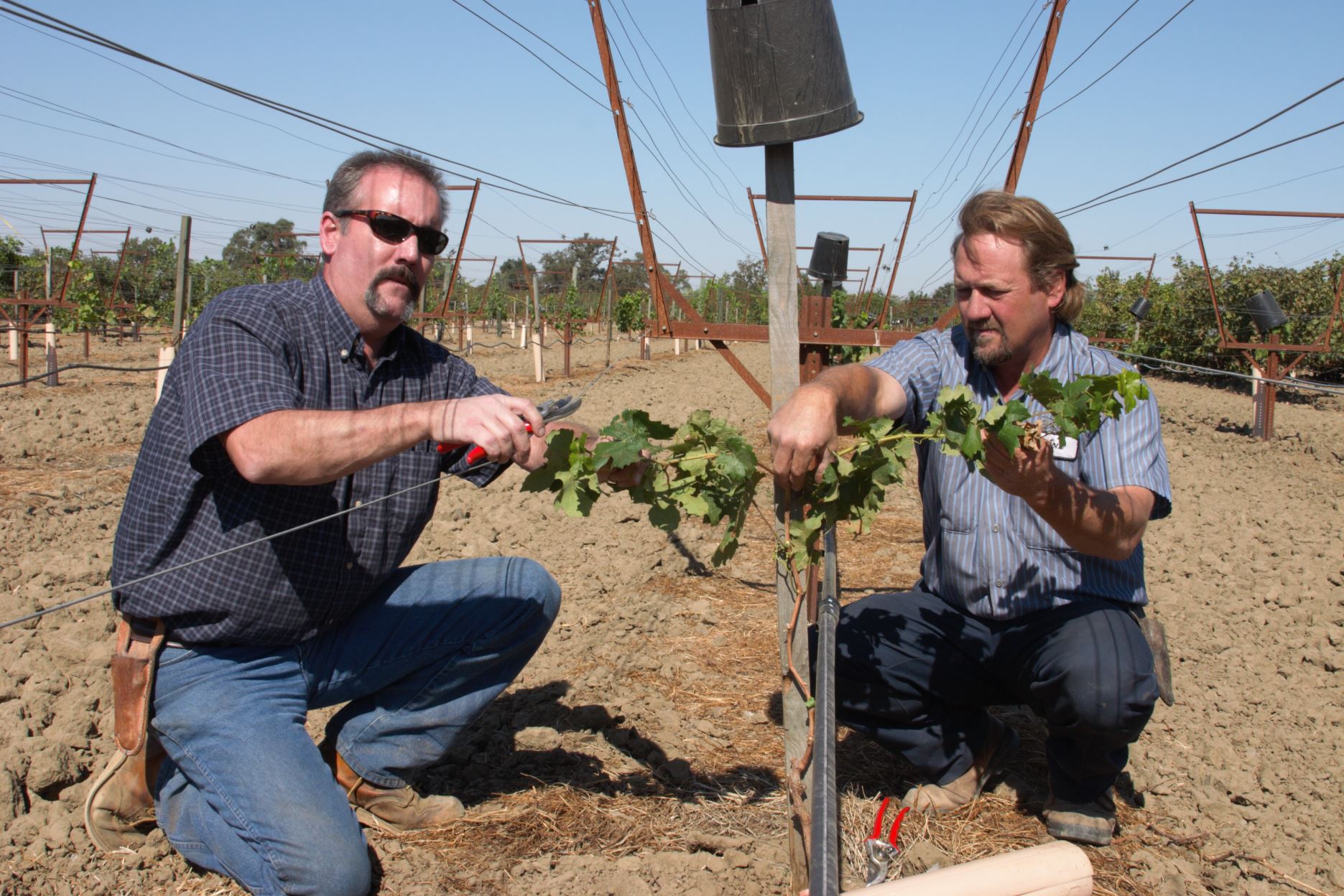
Winegrowers’ Project
Growers and winemakers in California turned their attention to acquisition of what they saw as higher quality winegrape clones in the 1980’s. Prior to that time, industry members had requested a desired cultivar by variety name, without regard to the concept of unique clones from particular sources.
The FPMS Industry Advisory Committee discussed in 1983 the possibility of FPMS formally evaluating the registered clones in the California program. Eventually, it was determined that the Department of Viticulture & Enology would be a more appropriate group to conduct that type of evaluation. 76 Minutes, FPMS Viticulture Industry Advisory Committee Meetings, November, 1983, and December, 1983; filed in the Foundation Plant Services collection, AR-050, box 23: 10, Special Collections, Shields Library, UC Davis.
Manager Susan Nelson-Kluk recalls that FPMS grape and wine industry constituents became more aware of foreign grapevine clonal material during an appearance by Oregon winegrower David Adelsheim at a meeting at FPMS. Winegrowers and university scientists in Oregon had acted upon industry interest in high quality grape clones for the western United States in the 1970’s. Oregon winegrower David Adelsheim (Adelsheim Vineyard, Newberg, Oregon) visited several clonal research stations in Europe and arranged to import some grape clones through Oregon State University (OSU), which had an importation permit for grapevines. Dr. David Cameron at OSU had also cultivated contacts in Europe. The initial importation of European clones to Oregon was made in 1974, and the first clone was released to growers there in 1980. 77 Minutes, FPMS Grapevine Industry Advisory Committee, December 16, 1986, attached to FPMS Annual Report 1987, and Minutes, Grapevine Subcommittee Meeting, December 5, 1985, attached to FPMS Annual Report 1986, both filed in AR-050, box 29: 50, and Minutes, FPMS Grape Industry Advisory Committee Meeting, February 22, 1985, AR-050, box 23: 11, Department of Special Collections, Shields Library, UC Davis.
Industry constituents at the FPMS Grape Industry Annual Meeting in November, 1984, raised the possibility of importation of foreign clones to California and placed the topic on the agenda for a special meeting to be held the following month. 78 Agenda, FPMS Grape Program Meeting, December 14, 1984; Minutes, FPMS Viticulture Industry Advisory Committee Meeting, November 12, 1984; Minutes, FPMS Grapevine Industry Advisory Committee, February 22, 1985 – all on file in Foundation Plant Services collection, AR-050, box 23: 11, Department of Special Collections, Shields Library, UC Davis. Two of the topics at that FPMS Grape Industry Meeting in December, 1984, included presentations on clonal selection and evaluation work performed in the past by UC Davis viticulturists and descriptions of the clonal development programs in New Zealand, Australia and Oregon. 79 Minutes, FPMS Grape Industry Meeting, December 14, 1984, filed FPS collection AR-050, box 23: 11, Department of Special Collections, Shields Library, UC Davis.
California grape and wine industry members that served as advisors to FPMS became increasingly interested in the European clonal material and wanted the same French clones as existed in Oregon. They saw the possibility of more diversity and complexity within grape varieties and wished to compare California and European wines made from fruit of the same varieties. The group felt that the process would reveal whether healthy selections of superior clones would produce high yields and superior wine quality. The clonal evaluation process would be shortened with imported clones since they were from European sources which had already evaluated the clones for viticultural and enological characteristics. 80 “Funding from Winegrowers of CA for Introduction of Selected Winegrape Clones”, Foundation Plant Materials Service Newsletter, no. 7, November 1987, pp. 3-4.
Deborah Golino indicates that California and American growers initially wanted to jump on the band wagon about clonal evaluation when they heard about how clones were developed in Europe. On further reflection, however, they soon saw that the time necessary to bring a clone through winemaking (find the clone, observe it, clean it up if needed, plant it in the field, grow vines and make wines, professionally evaluate the wines) was a long and difficult process. Precise adherence to the process could take 20 to 30 years. Winemakers in the United States were not willing to wait that long for university scientists, viticulturists and enologists to go through the steps. Importation of clones that were already developed in Europe seemed an acceptable compromise.
The Industry Advisory Committee made clear to FPMS their desire for new, foreign grapevine clones at an Industry Advisory Committee Meeting on February 22, 1985. A Grape Germplasm Task Force, which convened for the first time in 1985, was formed to explore the possibilities for new material at FPMS. Publications listing available grape selections and their sources (the blue and green books) were created to improve lines of communication between the industry and university. 81 Minutes, FPMS Industry Advisory Committee Meeting, June 6, 1986, on file in FPS collection, AR-050, box 23: 11, and Minutes, FPMS Grape Industry Advisory Committee, Meeting, October 7, 1988, AR-050, 23: 12, Department of Special Collections, Shields Library, UC Davis.
FPMS and California growers eventually received copies of the clones that had been imported to Oregon through OSU by 1986. FPMS requested further funding for additional clones chosen by California industry members for suitability to the California growing conditions. FPMS submitted a proposal in 1986 to the American Vineyard Foundation (AVF) for the importation, indexing and treatment of additional selected European winegrape clones. AVF is a non-profit organization headquartered in Napa that seeks to improve the American wine industry through research. The group was founded in the late 1970’s to finance research in viticulture and enology and relies on private donors. In 1987, the AVF awarded $20,000 to FPMS for the project, known as the Winegrowers of California - Introduction of Selected Winegrape Clones.
Adelsheim addressed the FPMS Industry and Technical Advisory Committees on March 13, 1987, about the Oregon experience with imported grapevine clones, Adelsheim’s recent trip to Europe in February of 1987 and the clonal selection program in France (“Clonal Selection and Evaluation in France”). He had arranged for the importation of additional clones during that visit to France. 82 Minutes, FPMS Grapevine Industry Advisory Committee, March 13, 1987, filed Foundation Plant Services collection AR-050, box 23: 11, Department of Special Collections, Shields Library, UC Davis. At a meeting in Davis the following March (1988), Adelsheim volunteered to make contacts for clones with specific traits of interest to California growers and winemakers during his trip to France in Spring, 1988. 83 Minutes, Introduction of Selected Winegrape Clones Project Advisory Committee, March 30, 1988, on file Foundation Plant Services collection AR-050, box 23: 12, Department of Special Collections, Shields Library, UC Davis.
The USDA awarded David Cameron (OSU) a Departmental Permit (no. 59008) in February, 1987, to import Vitis cuttings; the permit was valid until March 31, 1988. New winegrape clones were imported for FPMS in 1987 and 1988. The terms of the permit required that 1 to 3 buds from each subclone received at OSU be sent to Austin Goheen at FPMS for leafroll and stem pitting indexing. 84 Minutes, Introduction of Selected Winegrape Clones Project Advisory Committee, March 30, 1988, on file Foundation Plant Services collection AR-050, box 23: 12, Department of Special Collections, Shields Library, UC Davis.
The final report for the Winegrowers of California project was submitted to the AVF in summer of 1988. Adelsheim’s talk on clonal selection in France was included in the final Winegrowers’ Report, and an edited version was excerpted in an article in the September, 1989, Wines & Vines magazine. 85 “Introduction of Selected Winegrape Clones”, FPMS Newsletter, November 1989, number 9, p. 2.
The final report described 53 new clones at FPMS. Some of the clones from France are known in Oregon and California as the “Dijon clones” after the location where they were developed. The selections included Chardonnay (7 clones), Pinot noir (9), Merlot (8), Cabernet Sauvignon (9), Chenin blanc (8), Cabernet franc (16) and Sauvignon blanc (14). 86 Ball, Robert and Susan Nelson-Kluk, Final Report on Projects Funded by Winegrowers of California, University of California, Davis, July 29, 1988.
The last group of clones for the Winegrowers’ Project was received directly by FPMS on March 3, 1989. They included: Malbec (2), Petit Verdot (1), Muscadelle (1), Semillon (3), Cabernet franc (4), Cabernet Sauvignon (6), Merlot (4), Sauvignon blanc (5) and Sauvignon gris (1). Those would be the last grape importations that came to FPMS until the new Grape Importation & Quarantine facility was completed at FPMS in 1994. 87 “Introduction of Selected Winegrape Clones”, Foundation Plant Materials Service Newsletter, no. 9, November 1989, pp. 2-3.
CLONES FROM ABROAD IN THE 2000’s
The FPS foundation grapevine collection was enriched in the years after 1995 through varietal exchange programs and donations of European clonal material. Golino cultivated contacts and established relationships abroad for sources of quality grapevine material. The primary contributions to FPS consisted of warm-climate Mediterranean wine grapes and new clones of important vinifera varieties.
Port varieties from Portugal
Significant donations of European clonal material were made to FPS in the 2000’s. One example of such donation is a shipment of 13 clones from Portugal, donated to FPS in 2000 by nurseryman Jim Duarte of Duarte Nursery in Hughson, California. The clones included Arinto, Fernão Pires, Periquita, Trincadeira Preta, and Viozinho. 88 “New imports for the FPMS Public Collection”, FPMS Grape Program Newsletter, no. 6, October 2000, p. 2.
Vincent series Cabernet clones
A collection of French clonal material from Bordeaux known as the “Vincent series” was donated to the FPS foundation grapevine collection in 2004 and 2005 by a well-respected producer of French wine near Bordeaux, France. The donor, who wishes to remain anonymous, named the series after his vineyard manager in France as well as the patron saint of winegrowers, St. Vincent of Saragossa. The Vincent series encompasses Cabernet Sauvignon and Cabernet franc selections taken from separate vines on the estate in France. 89 “New Imported Proprietary Selections”, FPS Grape Program Newsletter, October 2010, p. 6.
Grapes of the Rhône - Tablas Creek Vineyards
Golino had developed a relationship with prominent San Luis Obispo grower and winemaker Robert Haas, founder of Tablas Creek Vineyards in Paso Robles, California. The general partners of Tablas Creek Winery, Robert Haas and the Perrin family in France, arranged in 2004 to ship to FPS all of the Châteauneuf-du-Pape AOC-approved varieties that were not already in the United States.
The 14 AOC-approved varieties are: Bourboulenc, Cinsaut, Clairette, Counoise, Grenache blanc, Grenache noir, Mourvedre, Muscardin, Picardin, Piquepoul blanc, Roussanne, Syrah, Terret noir and Vaccarèse.
A large collection of Rhône wine grape varieties came to FPS on two occasions in the early 2000’s. The varieties were collected by selection massale from the best performing vines at Château de Beaucastel, which the Perrin family owns, in Châteauneuf-du-Pape in southern France. The selections were from a working vineyard, and most suffered from virus, requiring microshoot tip culture disease-elimination therapy. 90 “FPS Offers New Grape Selections for 2010-2011”, FPS Grape Program Newsletter, October 2010, p. 7; “New FPS Public Grape Varieties and Selections”, FPS Grape Program Newsletter, October 2012, pp. 4-5.
The first shipment of Tablas Creek varieties in 2004 contained several lesser known Rhône wine grapes used in Châteauneuf-du-Pape wine. Varieties in the 2004 shipment included Vaccarèse, Terret noir, Muscardin, Cinsault, Picardan, Piquepoul blanc, Clairette blanche and Bourboulenc. The 2004 donation marked the first time all fourteen Châteauneuf-du-Pape AOC-approved varieties were available in the United States as virus-tested selections screened through authorized U.S. grape quarantine programs. 91 “Less-known Varieties of Châteauneuf-du-Pape are Being Indexed by FPS”, FPS Grape Program Newsletter, November 2005, pp. 4-5.
The second group of Tablas Creek Rhône varieties came to FPS in 2010. The original material for that group had been imported from France through the [Cornell University] Geneva, New York, quarantine program in the 1980’s. Mother plants were later maintained at Novavine Grapevine Nursery in Santa Rosa, California. In 2010, General Partner Robert Haas of Tablas Creek donated cuttings to FPS from the mother plants of Grenache noir, Gros Manseng, Mourvèdre, Petit Manseng, Piquepoul blanc, Roussanne, Syrah and Tannat. The selections originated from separate and unique vine sources in France. All of the Tablas Creek selections were donated to the public foundation grapevine collection at FPS in 2016. 92 “New FPS Public Grape Varieties and Selections”, FPS Grape Program Newsletter, October 2012, pp. 4-5.
Additional detail on the Tablas Creek selections is included in the chapter on The Rhône Rangers.
Exchange program for acquisition of new selections
“Our connections with foreign researchers and curators serve to facilitate the exchange of information as well as grape clones, varieties and germplasm. This enables us to continue moving ahead, adding new varieties and clones of interest to the industry to the collection as funding allows.” --Deborah Golino, FPMS Grape Program Newsletter, October 2003, page 3.
One of the unique initiatives developed by Director Golino to diversify the foundation grapevine collection was the exchange program with entities in other countries. She found the acquisition of new and unique grapevine material could be challenging because many owners have a sense of protection and proprietary value about their material. They look at their holdings as intellectual property and manage them in that fashion. Europeans have competing clonal development programs with multiple programs in France and Italy. It is often difficult to obtain the unique material for the FPS public grapevine collection.
Her approach was to reach out to centers or institutes with similar cultural values and interests as FPS and work out an arrangement that satisfied the interests of both parties. She felt that breakthroughs could be made if nurseries spoke with nurseries, regulators to regulators and university faculty/extension to university faculty/extension on both sides of the negotiation. For example, winemakers may give things to other winemakers because they are all part of the same business dynamic and culture. FPS sought to partner with university researchers in other countries for that reason.
Golino found that, whenever possible, communication was easier and exchanges more likely if the parties felt that ownership of material is respected. Agreements were facilitated when FPS agreed to give value to researchers in return, such as receiving foreign clonal material with an agreement to return the clones to the owners after disease testing and virus elimination therapy. FPS obtained the clones, and, in exchange, the original owner received clean and healthy versions of the clones or varieties.
Golino states that she has had virtually no problem with those kinds of exchanges. They seem to happen fairly freely compared to what otherwise would be long negotiations about proprietary material from entities other than researchers at universities. Some of the major exchange agreements with FPS were with Spain, New Zealand, Croatia and Greece.
Spain
Castilla y León is a quality wine producing region in Spain. Jesús Yuste Bombín, a scientist in the Department of Viticulture, Instituto Tecnológico Agrario de Castilla y León (ITACyL) in Valladolid, Spain, explains that the high quality of the wines from the region is mainly due to the native grapevine varieties used for wine production. ITACyL has managed a Sanitary and Clonal Selection Program for native grapevine varieties in Castilla y León since 1900. 93 Yuste, J.H., H. Peláez, J.A. Rubio, L.Mª Robredo. “Selección clonal y Sanitaria de la vid en Castilla y León”, Agricultura 792: 548-552 (1998). The objective of the program is to select virus-free clones (fanleaf, leafroll and fleck) that are true to variety and produce high quality wines. 94 Yuste, Jesús, “Grapevine Clonal Selections from Castilla y León, Spain, Now Available from FPS”, FPS Grape Program Newsletter, November 2005, pp. 8-11.
Golino worked with UC Davis Extension Specialist Jim Wolpert to obtain Spanish ITACyL clones for the FPMS program beginning in 2000. It was believed that the Spanish varieties would do well in California’s Mediterranean climate. Clones of ten Spanish varieties were sent to FPS between 2000 and 2008: Albariño, Albillo Mayor, Albillo Real, Garnacha gris, Garnacha tinta, Juan García, Mencía, Prieto Picudo, Tempranillo, and Verdejo. In 2005, an Agreement of Collaboration was entered between ITACyL and FPS which allowed FPS to distribute ITACyl clones to the public.
New Zealand
Riversun Nursery is a wholesale grapevine nursery in Gisborne, New Zealand. Riversun works closely with the New Zealand Winegrowers and propagates and produces certified grapevine material under the HAACP (Hazards Analysis of Critical Control Points) certification system. They serve a function similar to the nurseries in the California Grapevine Registration & Certification Program.
In 2006, Golino entered into negotiations with Riversun for the exchange of grapevine varieties, resulting in an informal agreement for 6 FPS selections in exchange for 7 from Riversun. In 2008, FPS received the following varieties for the public grapevine collection: Gewürztraminer, Grüner Veltliner, Lagrein, Müller Thurgau, Muscat Ottonel, Saperavi, and St. Laurent. The varieties and/or clones were new to the FPS collection.
Croatia
The story of the close connection between the grape and wine industry in Croatia and UC Davis is described in detail in the chapter entitled “The Origin of California’s Zinfandel”. Dr. Edi Maletić and Dr. Ivan Pejić of the University of Zagreb collaborated with UC Davis Professor Carole Meredith on solving the mystery of the origin of Zinfandel. DNA analysis at UCD revealed that California’s Zinfandel grape shared a genetic profile with an ancient grape from Croatia, known by several names as Tribidrag and Crljenak kaštelanski. The conclusion was reached that Croatia’s Tribidrag was most likely the source of California’s Zinfandel centuries ago.
Scientists at the University of Zagreb in Croatia agreed to donate to FPS several Croatian Tribidrag (Zinfandel) clones in exchange for which FPS provided California clonal material of Zinfandel and Primitivo to Croatia. The Zagreb scientists also donated to the public grapevine collection at FPS many other native Croatian varieties thought to have potential for California winemakers. Twenty varieties were imported between 2002 and 2010, including Babica, Glavinuša, Malvasia Dubrovačka, Žlahtina, Sansigot and Vugava. FPS tested and treated the material and returned the clean selections to Croatia. 95 Zdunić, Goran. “New Croatian Winegrape Varieties at FPS”, FPS Grape Program Newsletter, October 2012, pp. 8-11.
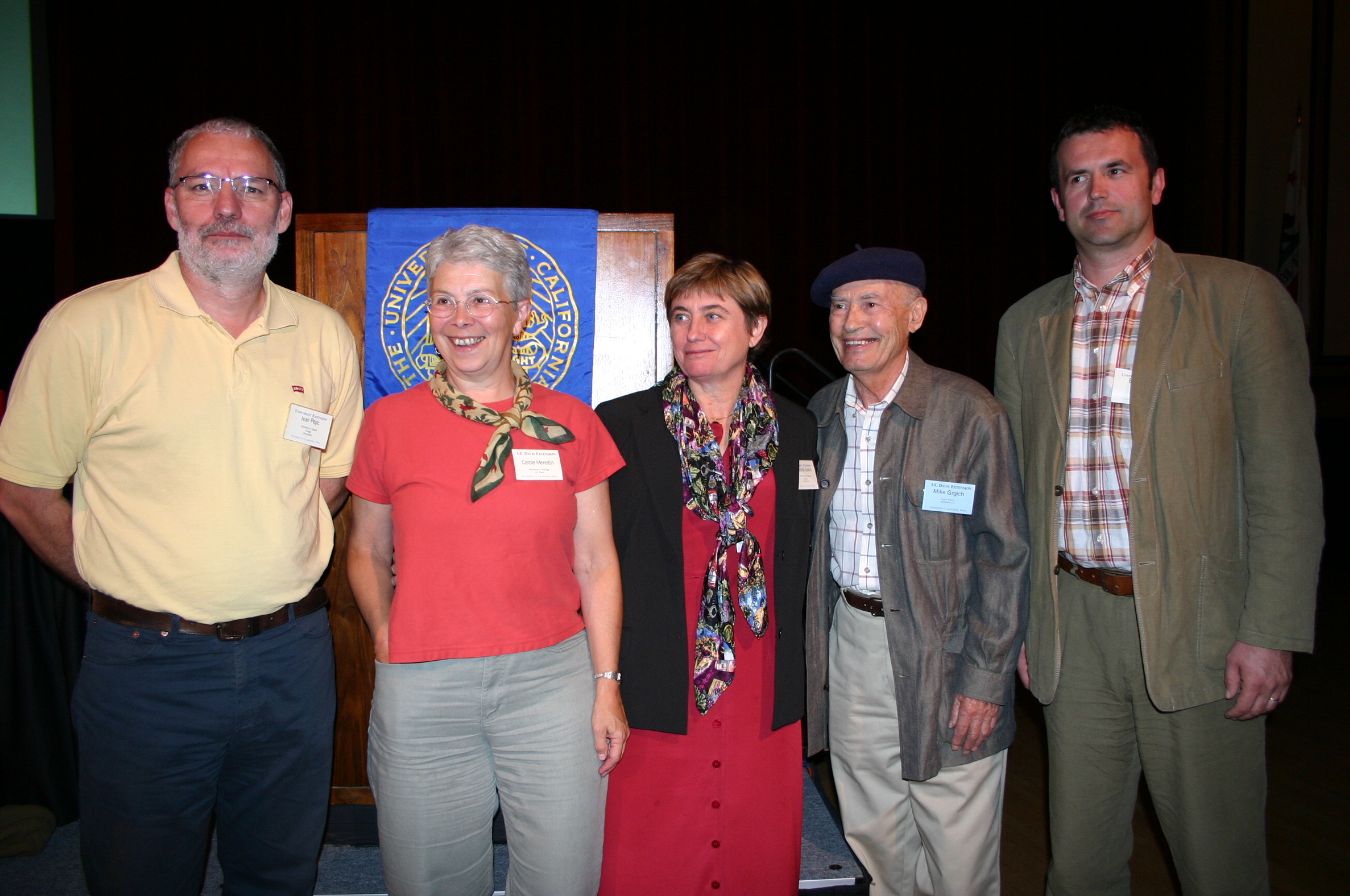
Greece
A seminar held on the UC Davis campus in spring 2014 led to the acquisition of numerous Greek winegrape clones for the FPS public foundation collection. FPS, UC Extension, and a Greek wine grape organization jointly sponsored the seminar, featuring speakers and winetasting. Some of the Greek attendees concluded that the grape and wine industry in the United States could benefit from unique high quality winegrape clones that had been selected and developed in Greece after Harold Olmo collected material there in 1949.
FPS entered an agreement in 2014 with Fassoulis Grapevine Nursery from the Nemea region of Greece for donation of Greek winegrape clones to the FPS public collection. In exchange, FPS agreed to return the clonal material to Greece after virus-testing and treatment, making the healthy grapevine material available in that country.
Fassoulis Grapevine Nursery selected what they believed to be Greek varieties that resulted in high quality wines in Greece, including Agiorgitiko, Assýrtiko, Athiri, Avgoustiatis, Dafni, Fokiano, Kidonitsa, Kotsifali, Lagorthi, Liatiko, Limnio, Malagouzia, Mandilaria, Mavrodaphne, Moschofilero, Plyto, Prikandi, Roditis, Savatiano, Sklava, Vertzami, Vidiano and Xinomavro. The material was sent to FPS between 2014 and 2018. As with the Spanish clonal material, it was thought that the Mediterranean climate in California is particularly suitable for success with Greek varieties. 96 “New FPS Public Grape Varieties and Selections”, FPS Grape Program Newsletter, October 2012, pp. 3, 6; “New FPS Public Grape Varieties and Selections”, FPS Grape Program Newsletter, October 2011, pp. 4-5.
Proprietary European clones
Grape nurseries, growers and winemakers often initiate custom importation of varieties or clones of interest through FPS. FPMS/FPS arrange(d)(s) for those imports through use of business contracts. The cost varies from $1,500 to $6,500, and the testing normally requires a minimum of two years. A contract customer usually has a relationship with someone abroad who is willing to provide the desired variety or selection. Most of those proprietary imports remain in the ownership of the importer, who pays all the expenses for their testing and care.
ENTAV-INRA® proprietary clones
The most well-known proprietary material in the FPS foundation grapevine collection is the ENTAV-INRA trademarked material. Discussions with ENTAV to develop a plan for marketing their sought-after clones in the United States occurred over a period of years in the 1990’s at Domaine de l’Espiguette in Bordeaux and in Davis. ENTAV Director Robert Boidron visited Davis in June, 1995, to discuss the new French “TM” (trademark) program for official ENTAV clones.
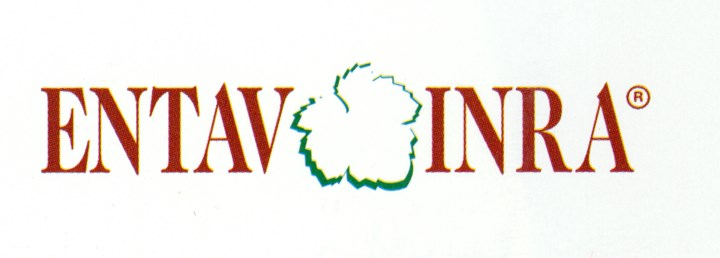
Although there were French clones in the United States prior to the ENTAV-INRA trademark program, ENTAV decided that it wanted to reimport new material directly to assure clonal authenticity. Complicating matters further was the decision by ENTAV to import the clones through nurseries in the United States.
One nursery, Guillaume, tried to be frugal and imported through Missouri State University (MSU) at a cost of $500 per selection, which was significantly less than the FPMS price at the time. When Sunridge Nursery was ultimately granted the exclusive contract for ENTAV importations, Glen Stoller visited MSU and discovered that MSU had suffered some challenges during index testing. He thereafter insisted all importations go through FPMS.
Sunridge took custody of the Missouri grapevine material, which was “grandfathered” into the ENTAV program. FPMS later reimported the same ENTAV clones directly. Deborah Golino indicates that the MSU program became much improved after Dr. Wenping Qiu became Director of the Missouri importation and certification program in October, 2000.
The ENTAV-INRA clonal trademark program eventually debuted in 2002 in the United States. Then-ENTAV Director Jean-Michel Boursiquot officially confirmed the identity of 24 wine grape and five rootstock ENTAV-INRA® clones in the FPMS foundation vineyard. California nurseries cooperating with ENTAV were then able to produce certified ENTAV planting stock from the mother vines at FPMS for grape growers and wine makers. Golino and Boidron had agreed that the official French clones at FPMS would maintain the French clonal numbers that ENTAV assigned to the material in France, rather than be renumbered with different FPMS selection numbers. 97 “ENTAV-INRA® Clones at FPMS”, FPMS Grape Program Newsletter, October 2002, p. 3.
The negotiations with ENTAV for the official French clones were complicated by the presence in the FPS public grapevine collection of “generic French clones”. Those generic French clones had been assigned unique numbers in France by CTPS (Comité Technique Permanent de la Selection) prior to the initiation of the French clonal trademark program. The generic French clones in the FPS foundation vineyard came to FPS with the CTPS numbers, primarily through the Winegrowers Project in the late 1980’s.
FPS designated the source of the generic clones as “reported to be” French CTPS clones but did not claim to guarantee the authenticity of the material. The generic clones were renumbered with FPS selection numbers different from the official French clone numbers. Nonetheless, ENTAV officials were not happy with that characterization and requested FPS to stop selling the generic clones entirely on the basis that they were proprietary to ENTAV. 98 “Negotiations for new French clones”, FPMS Grape Program Newsletter, vol. 2, November 1996, pp. 2-3.
FPS disagreed and continued to distribute the generic French clones that were received at FPS prior to the initiation of the French TM program.
Vivai Cooperativi Rauscedo
Novavine Grapevine Nursery in Sonoma is another large nursery in the California certification program that is licensed to distribute proprietary European clones in the United States. Novavine Nursery began a partnership with Vivai Cooperativi Rauscedo (VCR) of Friuli, Italy, in 1997. Novavine is the exclusive licensee in the United States for the premium VCR series of French and Italian grapevine clones and selections.
CALIFORNIA HERITAGE CLONES
One of the special subgroups in the FPMS/FPS foundation grapevine collection are the heritage winegrape clones from California. Grape and wine industry interest in higher quality and more diverse clones heightened in the late 1980’s at the same time that importation slowed. FPMS was having difficulty at that time obtaining permission from the USDA to complete the testing and treatment necessary to advance the quarantine accessions after Goheen’s retirement in 1988-89. In the interim, Golino consulted with key industry contacts and identified valued heritage winegrape clones for inclusion in the FPMS foundation collection.
California Heritage Clones
FPS has been the recipient of California heritage clones going back to the 1950’s and Harold Olmo’s clonal selection program in California vineyards. Researchers, viticulturists and winemakers around the state have ensured that valuable “heritage” field selections – those collected from premier vineyards with a reputation for quality wine – are available as certified selections through FPS. In some of California’s oldest vineyards, those selections represent pre-1900 European introductions that may contribute greatly to varietal clonal diversity. 99 Golino, Deborah A. and James A. Wolpert. “Vine Selection and Clones”, Wine Grape Varieties in California, eds. L. Peter Christensen, Nick K. Dokoozlian, M. Andrew Walker, and James A. Wolpert, pp. 8-11 (Regents of the University of California, Division of Agriculture & Natural Resources, publication 3419, 2003).
Golino was aware of the increased industry interest in quality clonal material in the late 1980’s and initiated a search for unique California heritage clones with the advice of experienced California winegrowers. 100 Minutes, FPMS Grape Industry Advisory Committee Meeting, Nov 13, 2002, FPS collection AR-050, box 23: 15, Department of Special Collections, Shields Library, UC Davis.
There was a sense that value existed in the grape material that in the past had produced outstanding results for California winemakers. At the time, phylloxera was killing many heritage vineyards in California. Golino credits winegrower Phil Freese with convincing her as a young researcher to pursue the heritage clone effort and preserve the material. The clonal workshops and variety seminars later produced by FPS arose as a by-product of the heritage clone project.
Golino and Freese collected four Cabernet Sauvignon clones in the fall of 1988 in Napa vineyards. Three of the Cabernet clones collected on that trip were Niebaum Coppola (FPS 29), Mondavi (FPS 31) and Disney Silverado (FPS 30). In 1998, those clones, along with the Bear Flat Merlot clone from Sterling Vineyards (FPS 18), were the first selections offered by FPMS as California “heritage clones”. 101 “New Grape Materials”, FPMS Grape Program Newsletter, number 4, October 1998, page 1.
The next significant acquisition was a group of Chardonnays collected with winemaker Zelma Long when she was at Simi Winery. Golino accompanied viticulturist Diane Kenworthy and Long in 1989 to identify vines and collect Chardonnay cuttings (FPS 66). Additional heritage Chardonnay clones were later obtained from Sterling Vineyards (1996), Kendall Jackson Vineyards (1997) and Stags Leap Vineyards (2202).

Morisoli Heritage Vineyard
Golino developed a relationship with winegrower Scott McLeod while processing the Niebaum-Coppola heritage Cabernet Sauvignon clone. McLeod and Golino explored the neighborhood around Inglenook Vineyards in Napa, including the Morisoli Vineyards, for heritage clones. McLeod knew the Morisoli family well and put Golino in touch with them about possible donation of material to FPS.
The Morisoli vineyard was an old California mixed planting with table grapes and many wine grapes. The vineyard was planted in the late 1880’s. Morisoli’s grandfather (born 1902) said that he started replacing some of the old vines as they died when he was a teenager. Morisoli suspected that some of the original vines remained in the 1 ¼ acre parcel in 2002.
One fall day in 2001 when the vines still had fruit on them, Golino and then-ENTAV Director Jean-Michel Boursiquot (who was on sabbatical at FPMS) explored the Morisoli heritage vineyard in Napa selecting and marking clones for the FPS collection. Boursiquot verified the varieties, the identities of which he was very confident.
Gary Morisoli donated nine selections from the Napa Morisoli Heritage Vineyard to FPS in 2001, including Alicante Bouschet, Carignane, Durif, Grand noir de la Calamette, Muscat Hamburg, Négrette, Syrah, Valdiguié and Zinfandel. Deborah Golino collected the wood in 2002. 102 “2002 Introductions for the Future Public Collection”, FPMS Grape Program Newsletter, October 2002, p. 3.
St. Helena Library
Boursiquot also accompanied UC Viticulture & Enology experts Jim Wolpert, Andy Walker and Mike Anderson to the St. Helena Library near Oakville for a project to collect old vine selections for a Petite Sirah planting at the Oakville field station. Three varieties – Durif, Syrah and Péloursin – were found in the library vineyard, suggesting that they might once have been blended into a black variety field blend that was used in the past in the Napa area. The original material for those selections was donated to FPS in 2001.
Larry Hyde
Another connection developed by Golino as a source for heritage clones was Larry Hyde of Carneros, a Napa grape grower who is well respected for the quality of his fruit and collection of field clones. Hyde was at an FPS clonal event and approached Golino after the presentations with an offer to donate his clones to the FPS foundation collection. She indicates she was fortunate that FPS had the resources to accept and process the clonal material. Hyde donated many heritage clones to FPS between 2002 and 2018, including five selections of Chardonnay and clones of other varieties from some of the oldest and most well-known vineyards in Napa and throughout the state.
Ridge Vineyards
David Gates and Ridge Vineyards have been very generous in donating heritage clones to FPS from heritage vineyards in the Santa Cruz Mountains and Sonoma County. The Fountaingrove Cabernet Sauvignon series from the Monte Bello vineyard in 2007 is profiled in the chapter entitled “The Black Grapes of Bordeaux”. Many Rhône clones and unusual French cultivars from Sonoma County vineyards were donated in 2013.
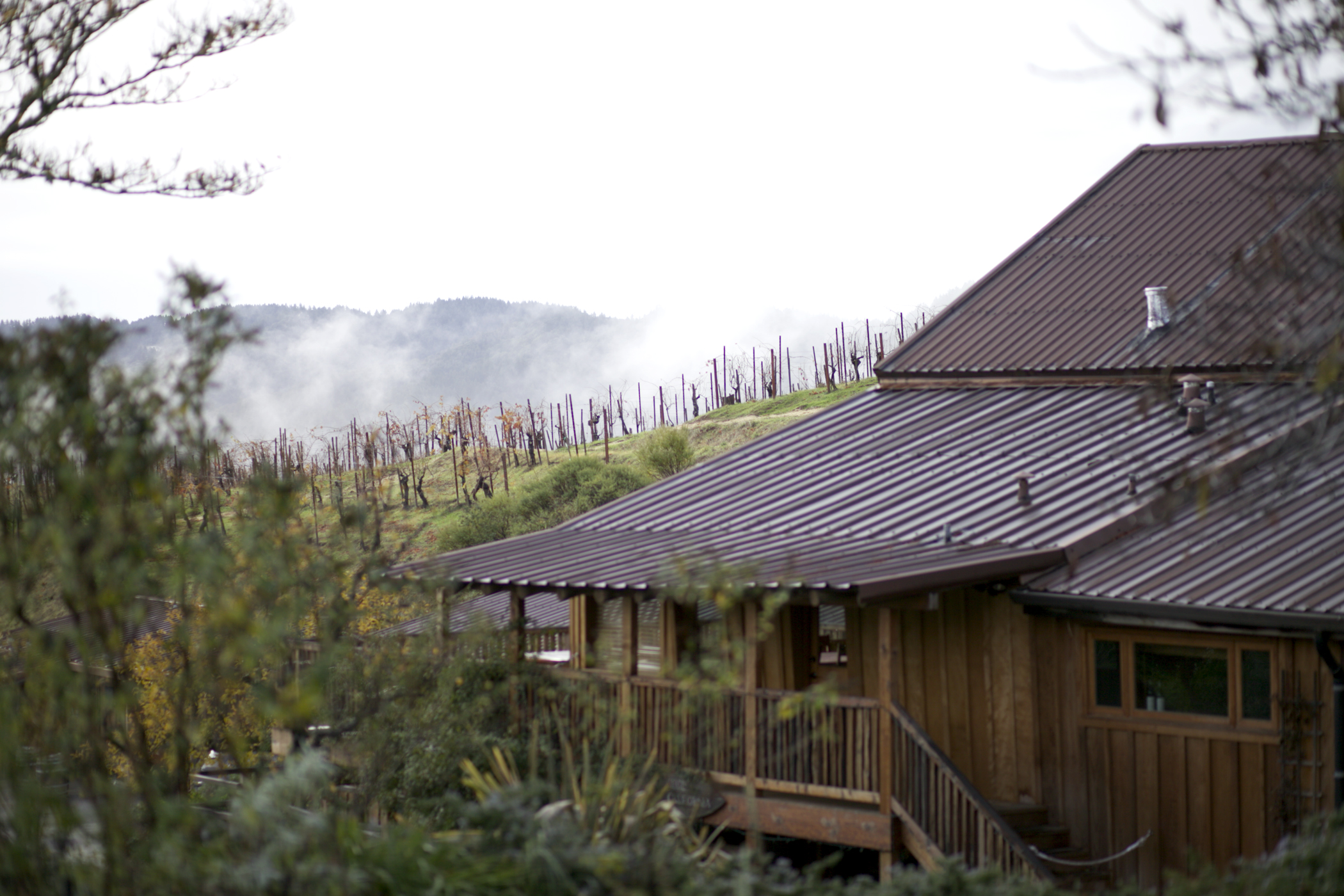
California Zinfandel Heritage Vineyard Project
The California Zinfandel Heritage Vineyard Project was created in the 1990’s to preserve historical California Zinfandel clones for the benefit of the public. The effort was initiated by Dr. Jim Wolpert, Viticulture Extension Specialist at UC Davis, and funded by Zinfandel Advocates and Producers (ZAP), a trade association of producers and consumers of Zinfandel wine. Heritage clones were collected from 14 counties in the state from vineyards planted before 1930. The team specifically sought vines with loose clusters and small berries. FPS donated disease testing and elimination treatment services to the project. A more detailed discussion of that California Heritage Zinfandel project can be found in the chapter entitled “The Origin of California’s Zinfandel”.
FPS Director Golino continued to reach out to growers and winemakers associated with valuable heritage grapevine collections over the years. The effort had a snowball effect. In the past 15 years, if a knowledgeable winemaker or viticulturist had a heritage clone candidate that they valued, they would bring it to FPS. She states that today (2019) more people ask her what clone to use rather than ask about bringing new clones to FPS.
Proprietary material within the US
FPS has made a special effort to reach out to university faculty and USDA breeders to obtain their varieties for the FPS grapevine collection with a minimum of expense for the breeders. For example, Dr. Andy Walker, Department of Viticulture & Enology, UC Davis, has entrusted FPS with his nematode-resistant grape rootstock varieties and vinifera winegrape varieties bred for Pierce’s Disease resistance.
New varieties developed through university research or by USDA breeders are often protected by patents and licensed for distribution. When Golino assumed the directorship at FPS, staff wanted to charge people like USDA breeder Dave Ramming and other breeders for managing their material because it was proprietary. Golino has come to understand over the years that if FPS can take in breeders’ material early from UC Davis, Cornell University, the University of Minnesota and the USDA and have it ready and clean at the time of release, FPS performs more of a service to the industry even if the material is being managed through a patent. FPS accepts such material at no cost to the programs for such breeders.
FPS OUTREACH STRATEGIES
One of the primary functions of a service center such as FPS is bringing university agricultural research and knowledge to the farmers, nurseries and winemakers who benefit from that information. FPS has paid special attention to performing such outreach activity for the grape and wine industry.
Education on clonal diversity
Golino initiated a series of workshops for nurseries and grape industry advisors to educate and facilitate communication about FPS foundation plant material. She explained that the FPS series was inspired in part by an ASEV Clonal Symposium in 1994 that provided a broad review of the concept of “clones”. The American Society for Enology & Viticulture offered Proceedings of the International Symposium on Clonal Selection (June 1995), including 33 original papers on grape clonal selection work that was conducted throughout the world.
The FPMS Grape Clonal Workshop was offered twice to nurseries and FPMS grape industry advisors in 1995. The first clonal workshop was conducted in the headhouse at the new FPMS facility. The workshop was sold out both times. 103 “FPMS Workshops”, Newsletter, Foundation Plant Materials Service, University of California, Davis, November 1995, number 14, p. 2. A workshop binder was prepared with articles describing clonal evaluation work for many of the more popular varieties, as well as those in the pipeline at FPMS. FPMS later (2003) co-sponsored with UC Davis Extension a seminar on the Clonal Aspects of Winegrowing.
In 2005, FPS began a series of more intense seminars for nurserymen and growers focusing an all-day course on a single variety or set of related varieties. The course handouts typically included a history of the variety or varieties in California, a list of the selections and clones for each variety in the foundation vineyard, presentation of the results of university or grower clonal comparisons for the selections, and a winetasting to compare styles or clones. In the later seminars, speakers would often visit from the countries of origin of the featured varieties and discuss clonal selection in those countries.
The initial “Variety Focus” was presented at Freeborn Hall on the UC Davis campus on April 7, 2005 and focused on Pinot noir. Wine writer John Haeger, author of a recent book on Pinot noir, was the keynote speaker on the history of the variety around the world. 104 John Winthrop Haeger, North American Pinot noir (University of California Press, Berkeley and Los Angeles, California, 2004). Golino spoke on the Pinot noir clones at FPS and the process used to test and treat them for the foundation vineyard. University scientists (James Wolpert and Glenn McGourty) and private growers with specialized knowledge on the variety (Francis Mahoney and Robert Haas) discussed the various industry clones. The winegrowers and winemaker Greg LaFollette guided the wine tastings.
Each of the subsequent Variety Focus events coordinated by FPS through UC Davis Extension used the same template for format and topics. All of the events occurred at the former Freeborn Hall. Those Variety Focus events featured grapes of the Rhône region in France (2006), Zinfandel (2007), Cabernet Sauvignon (2008), Grapes of Iberia – Spain and Portugal (2009), and Sauvignon blanc (2010). The presentations were recorded and can now be viewed on the FPS website at http://fps.ucdavis.edu/varietyfocus.cfm (Variety Focus Presentations). The substantive content from the Variety Focus events for the FPS clones for each of the above varieties may also be accessed in later chapters of this book under the appropriate variety name.
Other communication outreach efforts
FPS has sponsored many seminars and courses to educate the grape and wine industry on diseases of concern, recent developments in university wine and grape research, and major developments in the FPS program, such as participation in the National Clean Plant Network (discussed below) and development of the Russell Ranch Foundation Vineyard. Deborah Golino and other FPS scientists visit trade and association meetings to answer questions on disease issues, the benefits of growing clean plant material, and techniques for preventing encroachment of disease in vineyards planted with certified material. FPS scientists regularly visit and consult with vineyard owners and managers who seek diagnosis of potential problem issues exhibited by their vines.
IMPROVED ACCESS TO FPS GOODS AND SERVICES
“Although nurseries are our primary clientele, we have regular contact with numerous growers, consultants, and industry leaders for all of our crops. To better serve this mission, FPMS is working to develop a new series of ‘user friendly’ price lists, brochures, guides and publications for our programs.” –Deborah Golino, Foundation Plant Materials Service Newsletter, November 1995.
One of Golino’s strengths as Director has been implementation of strategies for successful outreach to customer groups by seeking to upgrade FPS technologies and make use of media tools that allow easy access. The goal is effective education and communication about FPS products and services.
Club News and Newsletters
A rich source of historical detail about FPMS/FPS can be found in annual publications from 1970 through 2012 that informed customers of news and events. Newsletters were an early and sustained method of information sharing and outreach in the FPMS/FPS grape program.
The “FPMS Club News” was distributed from 1970 through 1972, providing a glimpse into the early fruit tree and grape programs and their struggle to establish a funding mechanism. The "Club" was disbanded in 1972 and no FPMS news publications were issued again until 1981.
The annual FPMS newsletters for the grape and fruit tree crops were revived in 1980. Detailed grape program newsletters were published every year thereafter until 2012. An important role served by the newsletters was to keep FPMS customers updated about the newest technological developments from grapevine disease detection (molecular biology, PCR), disease elimination, variety identification and creations of new grapevine materials. Technologies drive the changes that continually reshape the FPMS grape program, the California Grapevine Registration & Certification Program and grape nursery industry. 105 “New Technology”, FPMS Grape Program Newsletter, October 1999, page 5.
All of the past FPMS/FPS grape program newsletters may be viewed on the current FPS website at: https://fps.ucdavis.edu/grapenewsletters.cfm.
The origin of the grape selections at FPS and availability of new selections were regularly reported in the newsletters. In the 2000s, FPS staff produced a series of in-depth articles that focused on the history and origin of FPS selections associated with a single variety. Some of those articles have been developed into chapters for this publication. The information on the origin and history of most of the important grape selections was later incorporated into a website created by FPS as an online catalogue for the foundation grapevine collection.
Catalogues of FPS Foundation Grapevine Selections
FPMS published two soft cover books from 1986 to 2006 containing profiles of the FPS foundation grapevine selections (Green Book) and an indication of nursery sources for those selections (Blue Book). Illustrations of the cover pages for the “Blue Book” and “Green Book” can be found in the previous chapter (“The Origin of Foundation Plant Services”).
In 2006, FPS created a web-based catalogue named the National Grape Registry (NGR) that eventually replaced the two paper publications.
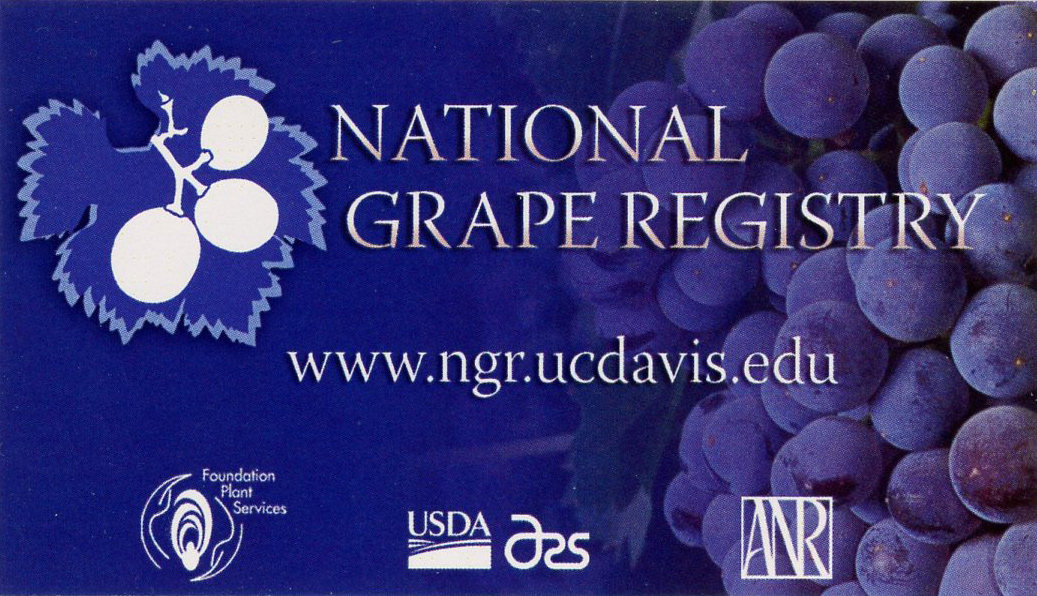
National Grape Registry (NGR)
The original and ambitious intention behind the National Grape Registry website was to provide user-friendly, single-site access to information on virtually all grape material in the United States. At the time, there was no central site in the United States for growers and researchers to obtain information on availability and sources for grape varieties. Commercial producers and researchers had difficulty locating unique or uncommon grape varieties which already existed in collections in the United States. It is expensive and wasteful to reimport varieties that are already in the country.
The initial scope of the NGR website included grapevine varieties and selections available in the foundation grapevine collections associated with universities such as UC Davis, Cornell University in New York and Washington State University (WSU), Prosser, as well as accessions in grape collections maintained by the USDA National Clonal Germplasm Repositories.
FPS tapped talent available at UC’s Division of Agriculture & Natural Resources (ANR) to create and program the new NGR website. Karl Krist is a gifted programmer who at the time was IT Director at ANR in Davis. Krist developed the National Grape Registry using custom software after consultation on content with FPS staff. Valerie Krist, an accomplished web designer at ANR, developed the graphics for the site.
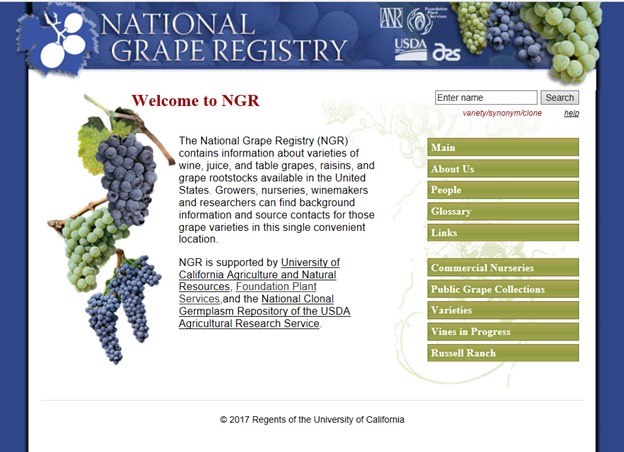
The FPS paper publications were eventually superseded in 2007 by the National Grape Registry website, promoted as a user-friendly reference for locating commercially-desirable grape plant material within the United States. The site included grape variety profiles, synonym lists, and an easy search function that linked prime grape names with their synonyms. The search function assisted with location of varieties in the face of a history of multiple and erroneous synonym usage and misnaming or misidentification of varieties. The participating nurseries in the California Grapevine Registration & Certification Program were displayed with contact information and lists of available FPS grape selections.
The major collections on the NGR site containing certified grapevine material were the foundation grapevines at FPS and WSU, Prosser. The FPS foundation grapevine collection is large and diverse (780 varieties and 3,600 individual selections). The Prosser foundation collection specializes in grapes suitable for cooler climates. The NGR presented an online catalogue for both foundation collections with information such as origin and history and testing and treatment status for each selection.
FPS Director Golino was so impressed with Krist’s skills and talent that she eventually convinced him to come to FPS in 2014 as IT Director to upgrade the FPS database and websites.
FPS Grape Registry (FGR)
FPS was faced with some important decisions about the future of the National Grape Registry website by 2016. ANR, the UC entity that serviced the NGR site, was no longer able to perform that function as of 2015. Krist was by then employed at FPS and was able to accept transfer of his custom-designed NGR website to FPS.
Several important considerations resulted in a decision to change the scope of the NGR once FPS assumed responsibility for its servicing. The original plan to include all grape varieties in the United States on the NGR site had proved overly ambitious. The USDA germplasm collections within the United States contained thousands of varieties, many of which were not sought after for commercial purposes. It was determined that the workload to enter all those varieties on the NGR would not produce a worthwhile return.
The NGR site had evolved over the 10 years of its existence into an online catalogue for the FPS and WSU-Prosser foundation grapevine collections. The participating nurseries in the California Grapevine Registration & Certification Program were having difficulty maintaining the list of registered/certified selections on both their own business websites and the NGR.
In 2016, FPS opted to streamline the NGR data and create a new feature on the FPS website (http://fps.ucdavis.edu) limiting the content to varieties and clones included only in the FPS foundation collection. The new feature, renamed the FPS Grape Registry (FGR), serves as an online catalogue for the Provisional and Registered foundation grapevine selections and those in the pipeline at FPS.
The variety and clone information were imported from the NGR to the FGR for each FPS selection. Krist linked the FPS database to the FGR so that database entries made thereafter in the database would automatically appear on the FGR, making annual maintenance and updating of the online catalogue much easier and more efficient for FPS staff. The data for the grapevine selections from WSU-Prosser were returned to WSU for their use on their website.
A change was made relative to the nursery information (former “Blue Book”) on the FGR website. The nursery availability information is not explicitly part of the FGR site. Instead, FPS has provided a list of the direct contact information for the participating California Grapevine R&C Program nurseries that annually purchase grapevine material from FPS, as well as a link to each of their own business webpages if the nursery so desires.
The FPS Grape Registry is now accessible in the Grapes section of the FPS website.
FPS Technology Upgrade
When Karl Krist started at FPS in 2014, the database, information and workflow systems and purchasing were managed using obsolete computer software in combination with paper files. The processes relied heavily on human input and manual tracking. The system was time-consuming, inefficient and subject to human error. Krist assumed the overhaul of the system and remade the components into reliable and user-friendly resources for FPS staff and customers. Director Golino characterizes the new database system as “transformative”.
Database and ordering system
FPMS purchased its first computer in 1983 and developed a database modelled on the "Dbase" software used at the nearby USDA National Clonal Germplasm Repository. Long-time FPS staff person Carole Lamb was a Repository employee before her tenure at FPS and recommended the software to Manager Susan Nelson-Kluk. FPMS staff entered data into the Dbase program from the Goheen indexing binders, including source, testing and planting location information for each grape selection. 106 Memo from Susan Nelson-Kluk to FPMS Technical Advisory Committee, August 17, 1987, FPS collection AR-50, box 23: 11, Department of Special Collections, Shields Library, UC Davis; Foundation Plant Materials Service, Newsletter, no. 4, October 1984, page 1. That initial database predated the FoxPro program that was used later at FPMS for order processing.
Prior to tracking orders by way of a computerized system, FPS maintained order records on 5-inch by 8-inch cards containing the variety or selection ordered and the source from which FPMS harvested the cuttings to fill the order. In the early days and sometimes thereafter, the notation may have been made that the order was filled from a group of vines from a particular variety, rather than a specific vine or selection. That lack of precision made tracking a particular clone to an order very difficult. A computerized system was needed for greater detail and precision.
FPMS began processing orders for plant material by computer in July, 1988, having switched to a Dataflex system that was converted to FoxPro in the 1990's. Packing slips accompanying the orders were designed to make the information easier to read and understand. The new system was a more secure system to assure correct labelling for source and registration status. A special verification feature assured that all materials were correctly labelled by variety, selection number, source and registration status. Source information was eventually changed to include a unique plant number rather than a location within a block. 107 Foundation Plant Materials Service Newsletter, no. 8, November 1988, pp. 1-2.
Tracking grape material was accomplished for purposes of the California R&C Program by the use of a color-coded tag system. White CDFA foundation stock tags accompanied plant material deliveries from FPMS to participating nurseries in the certification program to document the source of the material and official status in the program. “Mother block” tags (eliminated in 1984) were purple. Increase blocks (usually provided to customers by nurseries) had blue tags.
FPMS included the white foundation stock tags with the packing slip in the delivery to customers. In the late 1980’s and early 1990’s, FPMS started to include the stock tag numbers on the new computer-generated customer packing lists with a report of the same numbers to CDFA. The physical tags were no longer essential although they were included in the shipments for years thereafter. 108 “Computerized Order Processing”, FPMS Newsletter, November 1988, number 8, p. 1.
The physical foundation stock tags were eventually eliminated as workload pressures in the FPS plant introduction unit grew and efforts to eliminate unnecessary tasks intensified. R&C Program officials at CDFA and participating nursery representatives enthusiastically supported elimination of the white foundation stock tags in 2008. A “virtual tag” numbering system was created and generated within the FPS computer database. Nurseries no longer received the white paper foundation stock tags in the orders sent out from FPS by late winter of the 2007-2008 season. 109 “What Happened to My Foundation Stock Tags??”, FPS Grape Program Newsletter, October 2008, p. 13.
The FoxPro database was cumbersome and limited and relied on manual entries for all fields. Compilation of reports was problematic and very time-consuming. The system was clearly outdated by 2014. Reliance on paper records and manual tracking further reduced efficiencies and increased the errors.

ADAPT database
Krist has completely updated and expanded the FPS database, which can perform many more functions in a fraction of the time it took in the past. The new database is named ADAPT. Krist estimates that FPS can now track three to four times as much information as in the past. In addition to the basic functions of introductions, disease testing and planting, available new functions include such things as managing chemical inventories and applications, tracking the daily status of tissue culture explants, and automated tracking of introductions by plant all the way to planting date.
Major improvements in disease status reporting have been made. Testing data is entered by location and result for each selection. Test results are available on the database within a day or two of running the test and may be acted upon quickly (as opposed to a 6-month to two-year process in the manual tracking system). The disease report for plants advancing from quarantine can be run in minutes once the results are in (as opposed to the prior process of reviewing stacks of papers, compiling results and entering on a spreadsheet for uploading to the FoxPro database).
The data is much more accurate and reliable now that the need for human input for every report is reduced and the reports are automated. Relationships among grape selections can be tracked quickly and easily and test results for those groups are compared quickly. Paperwork associated with each introduction has been digitized and added to the database, rather than stored in large binders.
The plant ordering and distribution system has received a significant upgrade with real time monitoring of cuttings taken in the field. An inventory is maintained of every cutting taken and entered as the field crew collects the material. The field entry made simultaneous with collection is much more efficient. The cuttings are tracked and monitored daily until the material is packed.
Krist indicates that FPS ADAPT greatly reduces the amount of staff time needed to produce reports or results for customers. The database allows staff to access information quickly using high quality tools that are reliable. The data is trustworthy and accurate.
FPS Website
FPMS announced its first website in 1998, allowing customers online access to FPMS program information, collection lists and ordering procedure materials. The site also provided email access to the center for inquiries about materials and services. 110 “FPMS Web Site Now Online!”, FPMS Grape Program Newsletter, no. 4, October 1998, at p.11.
The 2018 FPS website is much improved and contains exponentially more information than the old site. Much of the FPS website is drawn directly from FPS ADAPT, again reducing manual entry and human error. For example, portions of the FGR (former NGR) are now automatically populated from ADAPT. The lists of available selections and varieties for each FPS crop are drawn from ADAPT.
The new features on the expanded FPS website are (in addition to the FGR) the Prunus Encyclopedia and the Rose Encyclopedia, and the book, Winegrapes of UC Davis. The Winegrapes of UC Davis consists of a series of chapters detailing the history of FPS and the nursery industry in the California Grapevine Registration & Certification Program, as well as many chapters on the origin and history of the selections in the FPS foundation grapevine collection.
The technology upgrade at FPS is an extraordinary accomplishment. Additional features are in progress. One new feature under construction in 2019 is designed to facilitate customer access to information in their FPS accounts, past history and ease of ordering. The goal of improving industry access to FPS goods and services took a big leap with the new technologies present at FPS.
STABLE FUNDING SOURCE FOR FPS
FPS is a departmental unit of the College of Agricultural and Environmental Sciences (CAES) at UC Davis. FPS is dedicated to the distribution of plant materials produced by UC researchers, improved by technology developed by UC researchers, or valuable to the specialty crop nursery stakeholders in the United States. The primary mission of FPS is service, and the center is supposed to be self-supporting. Over the years, the lack of dedicated operating funds from the University contributed to periodic financial uncertainties and irregular funding patterns.
Deborah Golino’s long-term goal as Director has been to establish a stable funding source for FPS clean plant work. She was taken by the quotation presented at the beginning of this chapter referencing the “twin goals of discovery and service” that land-grant universities must constantly balance. The practical reality is that university administrators often place a greater value on teaching and research and less on applied research and service work. The challenge of managing a program such as that at FPS is developing funding sources in the face of economic downturns and budgetary constraints.
The grape program has always been the largest and most complex of the FPS programs. Funding for FPS programs traditionally has come from a combination of sales of plant materials and services, IAB tax assessment funds, grants from industry, donations and user fees paid by nurseries for use of FPS grape selections. One of the most notable financial developments for FPS the past decade has been the availability of federal funding from the USDA’s National Clean Plant Network (NCPN). Multiple sources of income are an important part of a diversified management plan for a self-supporting unit. Those multiple income sources have become essential to the stability and quality of the FPS programs.
FPS-Industry Partnership
FPS programs have always required support above and beyond direct sales to continue. Direct sales of plant material are a highly variable source of income at FPS. FPS is embedded in the agriculture community, in which farmers, nurseries and wine producers can experience ups and downs in business cycles. For each program, FPS has looked for industry stakeholders to supplement the costs of the program.
FPS has been very successful in developing industry partnerships for improvement of the clean plant program since the 1950’s. Over the years, FPS has sought to improve the program by optimizing department procedures, increasing quality control standards, and improving communication with our diverse, sophisticated grape and wine clientele.
Industry partners saw value in the FPMS/FPS service work in the early years and became personally involved with program operations by serving on advisory committees and acting as consultants to the new and growing center. Those relationships lasted and developed over time. Industry members have initiated or supported many critical initiatives in the growth of FPMS/FPS.
In addition to donations of time and technical expertise, industry support through the years took the form of financial contributions from the CDFA Assessment Board called IAB (the Fruit Tree, Nut Tree and Grapevine Improvement Advisory Board), customer user fees, and direct donations and grants.
User fees
User fees have been an important part of FPMS/FPS grape program income since 1970. User fees were originally instituted to help offset the high cost of producing small quantities of many types and varieties of plant material. The plant material sold by FPS is covered by a grower agreement contract which customers are required to sign when ordering material. The grower or wholesale nursery customer agrees to pay FPS a small amount (originally $0.02) per propagative unit that they create from FPS certified material and thereafter sell, exchange or retain. 111 “Financial Report”, Foundation Plant Materials Service, Newsletter, number 3, October 1983, pp. 2-3; “FPMS grower agreement and user fees”, FPMS Newsletter, number 2, November 1996, at p. 5.

At various times over the years, FPS was encouraged by many of their industry advisors to step up enforcement (collection) of user fees, because income was critical to an ongoing high-quality grape program. One of Director Golino’s early successes was active enforcement of and consistent collection of user fees and monitoring user fees accounts receivable (tracking).
Enforcement of contracts promising to pay FPS user fees was stepped up in 1996-97 when penalties for nonpayment of user fees were instituted. Customers who failed to pay user fees were not allocated any materials that were in limited supply. As a result, compliance increased significantly. FPS contracted with the CDFA Audit Office to conduct audits of customers for compliance with user fees and IAB nursery assessments. Most customers reported and paid their 1997 user fees. 112 “FPMS user fee enforcement”, FPMS Grape Program Newsletter, no. 3, October 1997, page 8.
In 2010, the nurseries in the California Grapevine R&C Program demonstrated the value they place on the grapevine material produced by FPS. The R&C Program grapevine nurseries voted to double the user fee amount to $0.04 per vine to insure continuity of the FPS grape program.
Nursery tax assessments
FPMS experienced income deficits in the years between 1982 and 1988. Funding was inconsistent due to “slow downs” in the nursery industry, decrease in plant sales at FPMS and increased operating costs and expenses. Efforts to enforce user fees were facilitated by comparison of fees collected with certification tag records until ordering was computerized in 1988. However, user fees were inadequate, inequitable and difficult to collect during that early period.
In an effort to provide more consistent and reliable funding to FPMS, a law was passed in September, 1987, creating an assessment of ¼ of 1% on the gross sales of FPMS products sold by nurseries in California. The fruit tree and grapevine nurseries in the California certification program (also known as IAB) agreed to the legislation. The assessment money was designed to replace user fees as a steady stream of FPMS funding.
The funding was administered by the California Department of Food & Agriculture, which created an industry board to make funding recommendations. Those funds were projected to start flowing in 1989. User fees were suspended in 1986-87 in light of the new legislation creating the IAB tax assessment. 113 Foundation Plant Materials Service, Newsletter, no. 7, November 1987, pp. 1-2; Minutes, Project Advisory Committee, Introduction of Selected Winegrape Clones, March 30, 1988, on file in AR-050, box 23: 11, Department of Special Collections, Shields Library, UC Davis.
Funding for FPMS continued to be problematic in 1988. Revenue from the new tax assessment fell well short of projections in 1988. An amendment to the law was signed in fall of 1988, increasing the assessment to 1%. It was estimated that FPMS would begin to receive significant revenue from the assessment by 1991. FPMS industry advisors recommended reinstating user fees beginning in 1989 to help balance the budget until the assessment funding was realized. 114 Foundation Plant Materials Service, Newsletter, no. 8, November 1988, pp. 1-4; Report from FPMS Grapevine Technical Advisory Committee to Industry Advisory Committee, July 11, 1988, on file in AR-050, box 23: 11, Department of Special Collections, Shields Library, UC Davis.
Prices for FPMS material were increased in October 1988 because of continuing deficits. In 1988-1989, FPMS net income was up due to increased grape material prices and collection of reinstated grapevine user fees. Although total sales were down 14% for all crops over 1989-90, additional financial help was expected in spring 1990 from an increase in the tax assessment rate – assessments money was to be appropriated in spring. 115 “FPMS Financial Report”, Newsletter, Foundation Plant Materials Service, November 1989 page 1.
Bright light in the 1990’s
FPMS continued to juggle various funding sources in the early 1990’s. Distribution of plant material did not improve until the planting boom of the 1990’s took hold.
Income from sales of grape material was down in 1991-92, but the program still showed significant gain. 116 “FPMS Financial Report”, FPMS Newsletter, no. 12, November 1992, at p. 1. In 1992-93, the grape program made a net profit, primarily through sales, user fees, UC patent royalties and assessment funds. Grape prices were increased again at FPMS, in part because a reduced number of foundation cuttings were available due to the leafroll crisis in the foundation vineyard. An increased number of MPPs were created as a result. The grape reserve money was used to make up for tree and rose program losses. 117 “Price Increases for FPMS Grape Materials”, FPMS Newsletter, no 13, October 1993, p. 3.
Two extremely important demonstrations of industry support for the FPMS program occurred in the 1990’s. The grape and wine industry participated in two projects that had a lasting positive impact on the FPMS program.
Clean Stock Importation and Quarantine Facility (1994)
Industry advocacy in Congress and financial contributions were instrumental in realizing the Clean Stock Importation and Quarantine Facility completed at FPMS in 1994. The details of that project were described earlier in this chapter. The commitment by the grape and wine industry to the continuation of the FPMS program was illustrated by their vigorous efforts in support of the new facility that made the importation and clean plant work possible.
Funding the new Director position (1994)
Key industry players cooperated with UC Davis administrators in an in-depth review of the FPMS program, culminating in the Task Force Report issued in 1992. The committee established high minimum qualifications for the new Director. The University established a new funding structure for the position.
The challenges faced in continuing the work of the clean plant centers at universities arise in part from the traditional dichotomy between research and service work, as described in the quotation at the beginning of this chapter. The competition for resources between research and service work frequently results in short-changing the service component.
University centers with faculty members in the Director position often did not give the Director adequate time to complete the service work as well as meet expectations for research, teaching and other academic work. UC Davis attempted to remedy that situation when they hired Deborah Golino as the new Director for FPMS in 1994. The funding structure for the Director position was established with an eye toward value for service work.
UC Davis committed a faculty administrative position to serve as FPMS Director. Golino was hired to fill that position. The position description for the FPMS Director assigned 70% of the Director’s time to the Academic Administrator classification (CAES) and 30% to Cooperative Extension Specialist work (ANR). With those faculty titles, it would be possible for the new Director to have career success while performing service work. The service work is valued most by the industry stakeholders, who demonstrated their commitment by substantial funding commitments to the FPMS program. The IAB committed to providing 40% of that faculty Director’s salary and benefits.
The new building and the new Director were critical components to the future of the FPMS program in 1994. The grape and wine industry demonstrated the value they placed on the clean plant program by active participation in the key areas.
The planting boom of the 1990’s contributed to a more secure financial footing for FPMS for a time. In 1994-1995, FPMS gross revenues exceeded 1 million dollars for the first time. Of those funds, direct sales of materials and services comprised only 35%.
Increasingly, the support commodity interest groups provided the backbone of FPMS programs. User fees, industry donations, the IAB and University’s Office of Technology Transfer contributed 60% of the total income for 1994-1995. 118 “Financial Report”, FPMS Newsletter, no. 14, November 1995, page 2. By 1995, IAB funding comprised nearly 50% of FPMS operating funds. 119 Minutes, FPMS Grape Advisory Committee Meeting, Thursday, August 10, 1995, DANR Conference Room, University of California, Davis.
FPS stakeholders have described the foundation grapevine collection as both insurance against possible field infection of cultivars at the nursery and as a library of cultivars. Most of them purchase from FPS every year but, normally, they do not repurchase the same cultivars every year. To provide a practical example, if Nursery A purchases cuttings of a popular Chardonnay clone and establishes an acre of Chardonnay in a nursery increase block, it might be as much as 20 years before Nursery A purchases that clone again. FPS still must continue to test and maintain the vines of that Chardonnay clone in the foundation vineyard – an expensive proposition. However, it is much cheaper to maintain that Chardonnay against potential industry need than it would be to eliminate it from the collection and have to start over when needed again.
FPS estimates the incremental cost of creating a single clean grape cultivar as $10,000. The process often takes up to five years. In any given year, cuttings are sold from perhaps less than 10% of the total foundation vines; however, it is almost impossible to predict which vines will be requested or sold. FPS does not prune until late March, just before bud break, because new orders are received for dormant cuttings from early October until the time of pruning.
FPMS saw an all-time high income of $1.2 million to date for all crops in 1995-96. Ironically, the grape program lost money that year due the expense of increased plantings after the leafroll crisis and investment in new equipment. 120 Minutes, FPS Grape Advisory Committee, January 15, 1997, FPS collection AR-050, box 23: 15, Department of Special Collections, Shields Library, UC Davis. Demand was high for mist-propagated plants in 1997; FPMS sold more than 30,000 plants which was a very large volume for FPMS. The large planting boom in California, combined with high demand for new releases coming out of quarantine, resulted in requests that extended FPMS facilities and staff to full capacity. 121 Memo from Deborah Golino to All Grape Program Participants, dated June 17, 1997, FPS collection AR-050, box 23: 15, Department of Special Collections, Shields Library, UC Davis; Minutes, FPMS Grape Advisory Committee, dated November 5, 1997, FPS collection AR-050, box 23: 15.
The bright lights and successes of the 1990’s reverted to financial challenges in the 2000’s, illustrating the unpredictable nature of work and economic vicissitudes in the agricultural business.
Funding challenges in the 2000’s
Robert Woolley, then Owner and General Manager of Production at Dave Wilson Nursery, observed in 2005: “the FPS grape program has been running at a loss since the planting boom of the 1990’s”. At the time, Woolley was arguing in favor of ongoing federal funding for clean plant services for specialty crops such as grapes. 122 Robert Woolley, “Proposal for a National Clean Plant Network”, FPS Grape Program Newsletter, November 2005, p. 17.
Deborah Golino commented on “Challenging Times Ahead for FPS” in her column in the FPS Grape Program Newsletter of October 2003. She noted that FPS was not the recipient of state or federal funds directly to support its programs at that time. Each of the commodity programs was supported by funding from the industries that were served. Adverse economic trends and recent budget cuts to UC and the Agricultural Experiment Station and Cooperative Extension had been difficult for the industries served by FPS. Sales revenue, custom contracts, and user fee payments were down. The IAB dedicated its contribution to efforts to improve future plantings, rather than on introduction, testing and clean up of new grape selections. FPS suffered layoffs and unfilled positions. 123 “Challenging Times Ahead for FPS”, FPS Grape Program Newsletter, October 2003, p 3.
Perhaps as a reflection of new things to come, FPMS changed its name on June 1, 2003, from Foundation Plant Materials Service (FPMS) to Foundation Plant Services (FPS). It was thought that the name “Foundation Plant Services” better reflected the FPS mission to provide a broad range of plant-related services, in addition to plant materials. Custom services for all crops were part of the FPS offering, as was access to new technology developed by UC researchers for improving planting stock. A new center logo was also introduced. 124 “Name Change and Logo”, FPS Grape Program Newsletter, October 2003, p 1.

Industry steps up again
The grape and wine industry contributed again in the 2000’s in two significant ways to improve the FPS clean plant program and secure its future. The actions were reaffirmations of the strong support and partnership between FPS and its constituencies.
Industry members in 2009 contributed to a second building to house the expanding FPS program and foster an environment conducive to education on clean plant issues, application of advanced scientific technologies, and production of innovative and customer-friendly outreach methods for customer access to FPS products and services.
Trinchero Family Estates Building
“It was 1994 when we moved into the university’s National Grapevine Importation and Clean Stock Facility located west of the Davis campus. Since then, our programs have more than tripled, necessitating expansion for new staff and information technology needs.” --Deborah Golino, From the Director’s Desk, FPS Grape Program Newsletter, October 2010.
In 2009, FPS was in dire need of additional facilities as many staff members, including laboratory scientists, were housed in an old portable trailer that had deteriorated severely. There were problems in the trailer with heating and cooling and leaks during rainstorms. The trailer also housed the equipment for the FPS computer servers for the FPS database and website. A secure facility was also needed to accommodate a planned overhaul of the FPS information technology program.
Director Golino had secured funds to pay for University assistance in the planning stages of a new facility to replace the trailer. The new facility was designed to include office space for scientists and staff that were then housed in the laboratory in the main building at FPS. In the event the scientists and staff could be moved into a new facility, additional laboratory space would be made available.
Golino initially hoped that funding for a new building might be provided by the then-new National Clean Plant Network (Food, Conservation, and Energy Act of 2008, commonly known as the Farm Bill of 2008, section 10202). However, Congress had specified in the enabling legislation that funds would not be made available through the NCPN for new construction at clean plant centers. Golino expressed her disappointment about the NCPN funding constraint to a representative of the Trinchero Family Estates company, who was willing to talk to the Trinchero Family about a possible contribution to the new FPS facility that had been planned.
Trinchero Family Estates is a family-owned wine company in the Napa Valley. The Trinchero family came to Napa Valley in 1947 and purchased an abandoned winery named Sutter Home. Following the success of Bob Trinchero’s “white Zinfandel” in the 1970’s, they expanded their portfolio to include 23 different wine labels, including Sutter Home, Trinchero Napa Valley, Napa Cellars, Terra d’Oro, Montevina, Trinity Oaks, Folie à Deux, Ménage à Trois, and the alcohol-removed wine, Fre. The Trincheros are well known as a very generous family who has a long-standing commitment to charitable giving and innovative philanthropic initiatives.
In October, Golino was invited to have lunch with Bob and Roger Trinchero to discuss her ideas about the new facility for FPS. In November of 2009, FPS was the recipient of a generous gift of $1 million from the Trinchero Family Estates company. The gift allowed construction to begin on the new facility, which was named the Trinchero Family Estates Building (TFEB).

The TFEB facility is a 7,500-square-foot building south of the main FPS building on Hopkins Road. TFEB includes a large meeting room and offices and conference rooms for FPS scientists. 125 FPS Grape Newsletter, October 2010, p. 3; FPS Grape Newsletter, October 2011, p. 1. A donation from grower and winemaker Francis Mahony resulted in a conference room named in his honor. The large meeting room where events, meetings, seminars and stakeholder gatherings are regularly held, was named after Pete Christensen, late Viticulture Specialist in the Department of Viticulture & Enology, for his long-time support of FPS’ clean plant work and dedication to viticultural advancements.
The TFEB project was completed in two Phases at a total cost of $3.5 million. Phase I of the construction, building the cold shell, was completed in 2012. A celebration dedicating the new building was held at FPS in May 2012. Dean Neal Van Alfen (CAES) welcomed FPS stakeholders and guests, including Bob and Roger Trinchero representing the Trinchero Family, donor Francis Mahoney, and the family of Pete Christensen. 126 “From the Director: A Fruitful Year of Expansion”, FPS Newsletter, October 2012, pp. 1, 36.
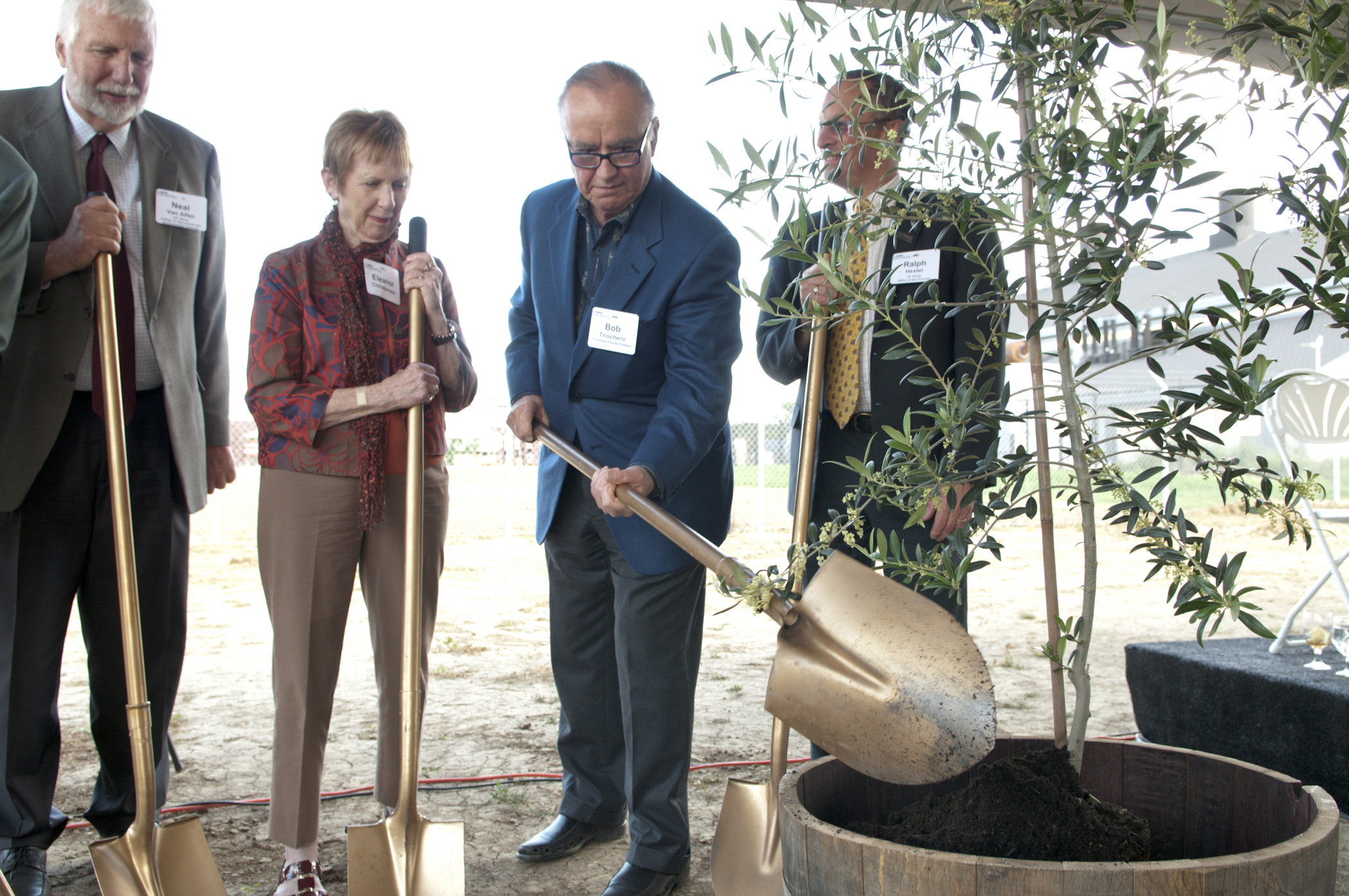
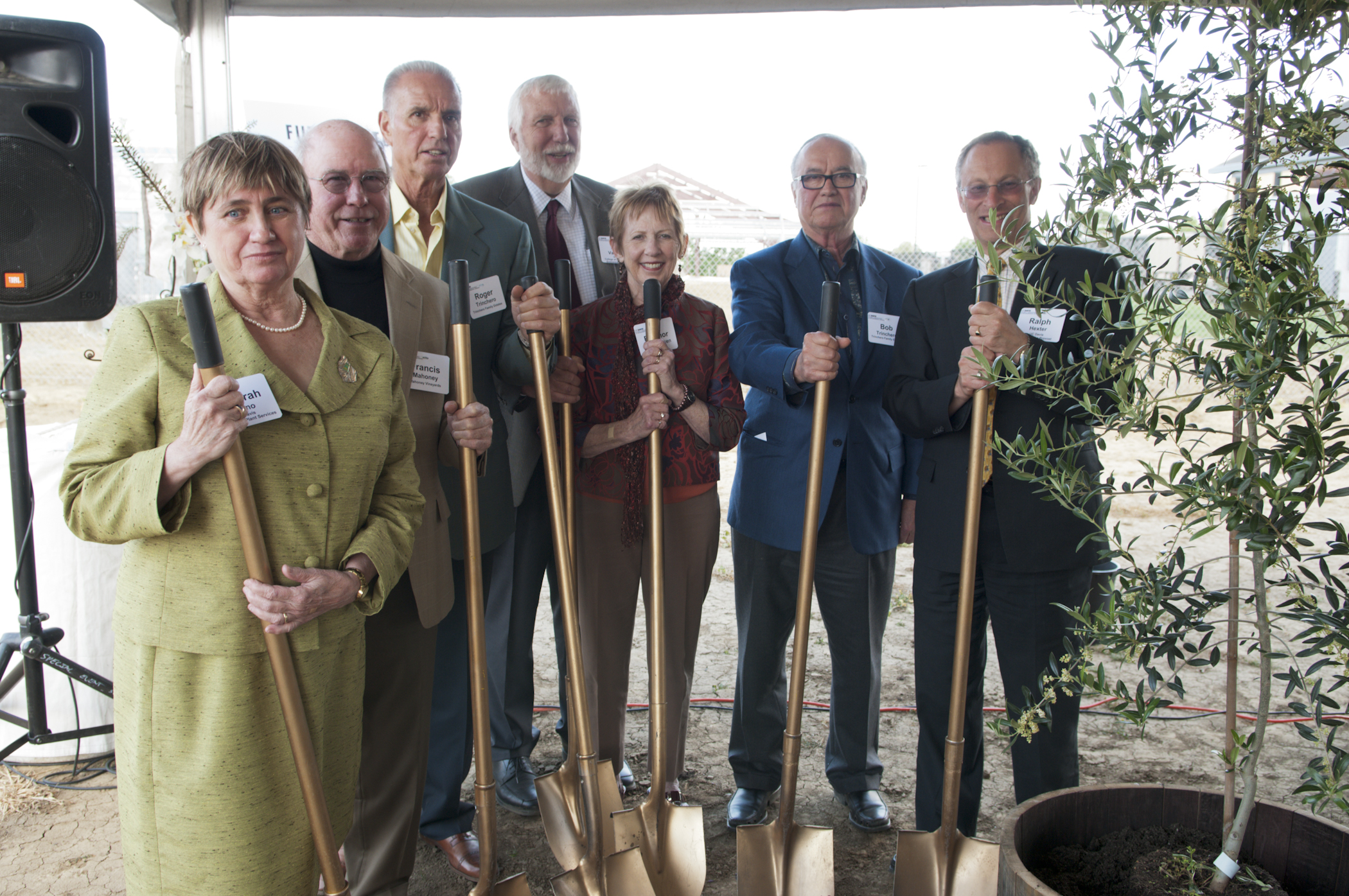
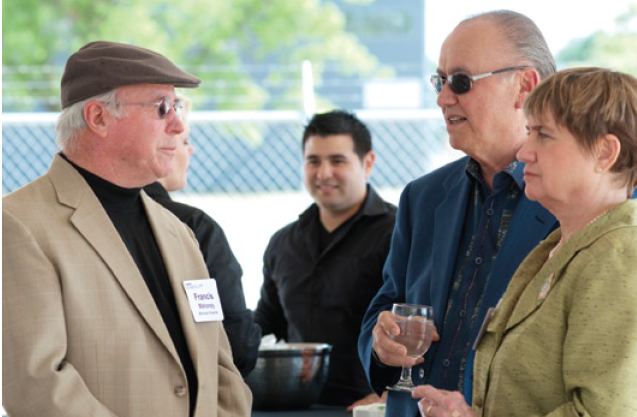
In the following years, FPS raised $2.5 million in order to complete the construction and finish the tenant improvements (interior walls, doors, electrical and plumbing) and landscaping. Many sustainable design features (water and energy efficiency) were included in the construction. Phase II was funded by plant sales which was only possible due to the federal funding which had become available through the National Clean Plant Network. A certificate of occupancy for the TFEB building was granted in March, 2015.
The TFEB construction exemplifies the effective partnership that has existed between FPS and industry stakeholders over the years. Grape growers and wine makers have stepped up to ensure that FPS has the resources necessary to produce high-quality plant material desired by the industry. The TFEB enables FPS to meet that goal much more effectively.
Former Senior Vice President of Vineyard Operations for Trinchero Family Estates Hal Huffsmith expressed what he appreciated about FPS after long term contact with the program: “My lasting impression of Dr. Golino’s contribution to California viticulture is her unwavering focus on and dedication to supplying the industry with virus tested ‘clean’ plant material. Despite the unrelenting attack of grapevine pathogens and their vectors, Deborah has tenaciously pursued the single-minded objective of generating and propagating grapevine scions and rootstocks that give each viticulturist an opportunity to maximize vineyard longevity and grape quality”. 127 Hal Huffsmith email to author, November 2, 2018.
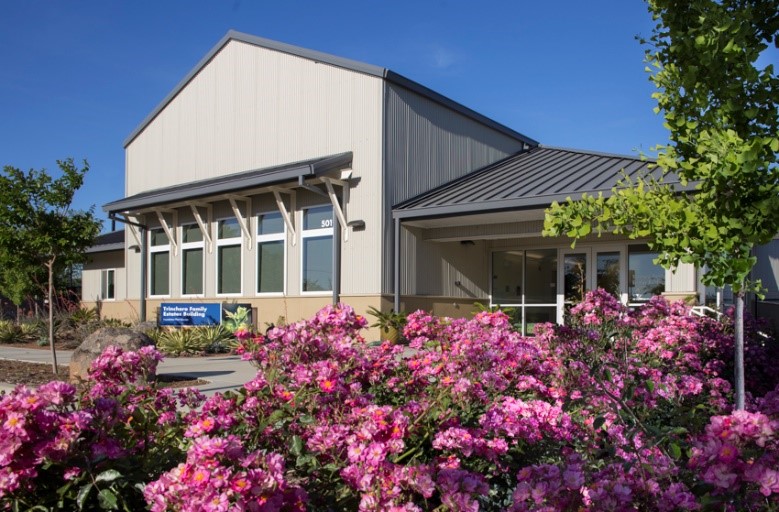
Advocacy for NCPN
Despite long term financial assistance from industry stakeholders and the University of California, Golino saw the need for a regular federal funding stream to secure the long-range productivity and continuity of FPS and other clean plant centers in the country. She assumed a leadership role in the founding of the National Clean Plant Network (NCPN) from the time the network was “only an idea”.
FPS’ industry partners played a critical role in advocating to Congress for the creation of the National Clean Plant Network. The cooperative effort of government, university extension and industry representatives has made that stable funding concept a reality in 2019.
National Clean Plant Network (NCPN)
FPS and other clean plant programs in the United States faced funding challenges that reached a critical phase in the period 2003 to 2005. Those programs were normally associated with land grant colleges, where service work was eschewed in favor of teaching and research activities. Service work suffered the lion’s share of the budget cuts that afflicted universities in the decades prior to 2003.
The grape program at FPS had begun to suffer financial challenges in the late 1990’s and ran at a loss after the end of the planting boom of the 1990’s. Golino felt that the clean plant work was important and necessary service work for the grape and wine industry and for agricultural security. She had long advocated the availability of federal funds to augment university resources in support of service programs such as FPS and sister programs at UC Riverside, Cornell, WSU-Prosser and USDA-Corvallis. 128 “From the Director’s Desk”, FPS Grape Program Newsletter, October 2010, p. 3.
Robert Woolley described the struggles experienced by the clean plant center in the State of Washington in an article in the 2005 FPS Grape Program Newsletter. He wrote that funding for the NRSP-5 (National Regional Support Project) at Washington State University-IAREC (Irrigated Agriculture Research and Extension Center) [now known as Clean Plant Center Northwest, Prosser, Washington] was expected to be dramatically reduced in the immediate future. That center, like FPS, administered clean plant services to fruit and nut trees and maintained foundation collections for fruit trees and grapes. USDA/CSREES [now known as NIFA, the National Institute of Food and Agriculture] presided over diminishing experiment station funds upon which Prosser was almost entirely dependent. NRSP-5 had been supported by funds earmarked for research until university administrators decided that clean plant programs were considered service activities that should not receive research monies. 129 Robert Woolley, “Proposal for a National Clean Plant Network”, FPS Grape Program Newsletter, November 2005, page 17.
In that environment, discussions intensified in 2005 for the creation of a national clean plant network to provide ongoing federal support for clean plant services. Nurseries and growers served by the clean plant centers for grapes and fruit trees and other horticultural crops approached the CSREES [now NIFA] division of the USDA with the proposal. FPS and NRSP-5 were identified as the foundation for the network. Other regional facilities for the Mid-West, South and Northeast were suggested.
The rationale for the proposal was that sustained federal support was needed because the existing programs were not able to address nationwide clean stock needs for grapevines, fruit and nut trees due to budget pressures and reduced funding. 130 Robert Woolley, “Proposal for a National Clean Plant Network”, FPS Grape Program Newsletter, November 2005, page 17. The federal funding would supplement the allocation from the land grant colleges for applied research and service activities.
A meeting to discuss “Elements of a National Grape Importation and Clean Plant Network” was held in Davis, California, on September 28 and 29, 2005. FPS sponsored the meeting. The NCPN proposal and National Grape and Wine Initiative priorities were explained to the attendees. The focus of the discussion was on coordination of the existing grape clean plant programs. Reports were presented by attendees from existing grape importation and/or clean plant programs: Pacific Northwest NRSP-5 (Ken Eastwell, Gary Ballard); Mid-Atlantic (MD, PA, and VA) (Elwin Stewart, Joe Fiola, Mark Chien); Cornell/East (Marc Fuchs); Missouri State University (Keith Striegler, Wenping Qui) and FPS (Deborah Golino). The second day of the meeting focused on development of a National Registry of grape plant materials.
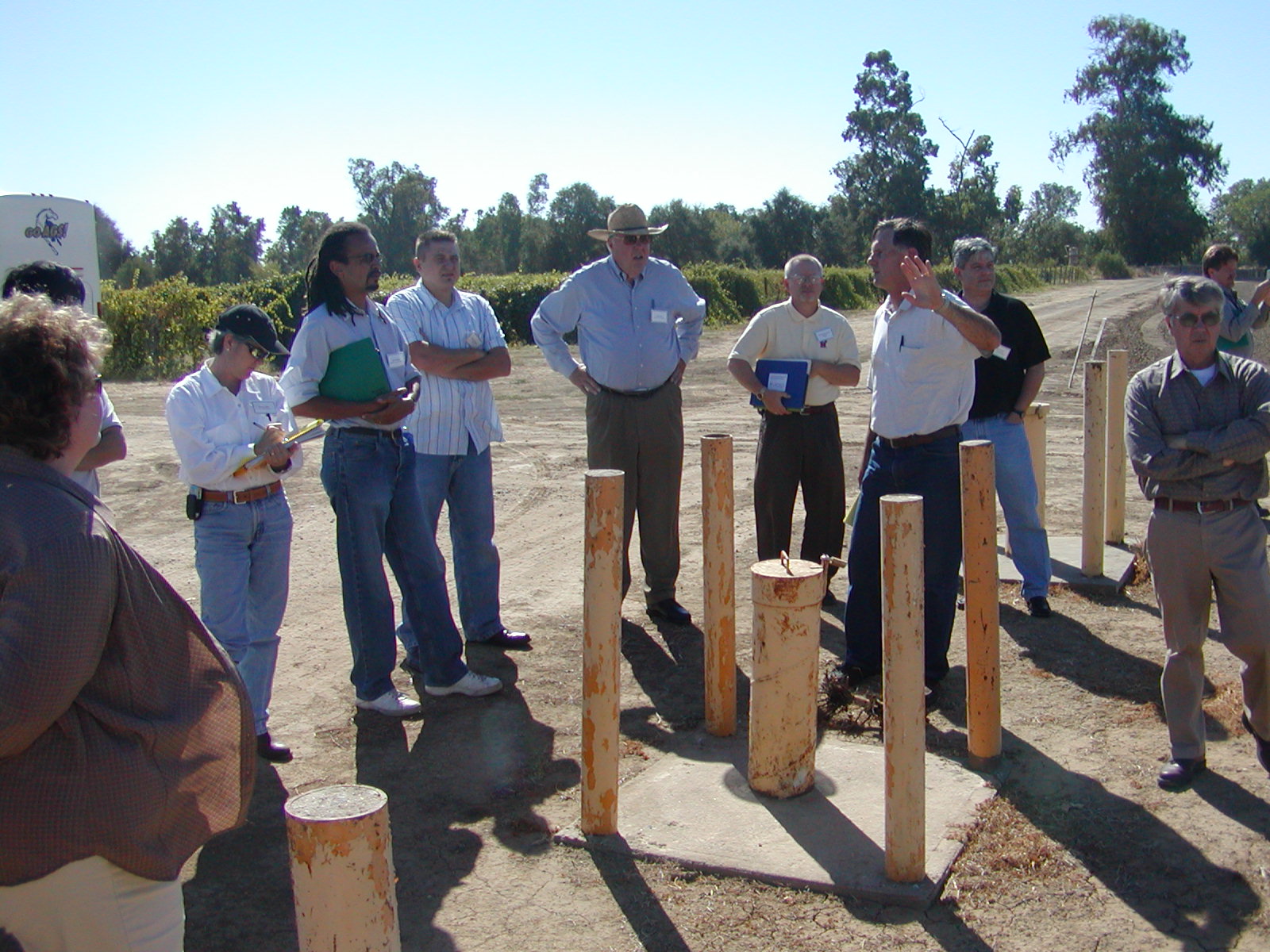

Extensive discussions to formalize a plan for the clean plant network were coordinated by the USDA between 2005 and 2008. A steering committee was formed in November, 2006, to review existing clean plant programs and prioritize crops for funding. The steering committee was composed of representatives from the nursery industry, the grower community, the National Plant Board and other state regulatory agencies, the land-grant university system, USDA-APHIS, Agricultural Research Service (ARS), and CSREES (now NIFA). FPS through Deborah Golino participated in the planning efforts.
A national workshop was conducted at USDA-APHIS headquarters in Riverdale, Maryland, on May 8-9, 2007. Deborah Golino presented a national overview of the scope and importance of key service programs at FPS, UC Riverside, Cornell, WSU-Prosser, Clemson and USDA-ARS Corvallis. She was one of the founders of the NCPN network and was there at the beginning conceptualizing what a clean plant network might look like. 131 Author interview with Erich Rudyj, Coordinator, National Clean Plant Network, USDA APHIS, October 5, 2018.
The steering committee and other participants at the Riverdale workshop developed a mission statement and debated clean plant goals and objectives. A draft implementation plan was prepared as a result of those discussions. The agenda, discussion guide and workshop discussions may be accessed on the NCPN website in the section entitled “About the NCPN, 2007 Organizational Workshop”.
The concept of a clean plant network for certain important specialty crops was promoted to members of Congress on several bases. Grape and wine industry members were vigorous advocates on Capitol Hill for the proposal. They explained that healthy planting stock is the key to the cost-effective production of horticultural crops such as fruit trees, nut trees and grapevines. It is easier to propagate, requires fewer chemical inputs and produces higher crop yields and better crop quality than common planting stock. Healthy planting stock is necessary for U.S. agriculture to remain internationally competitive and economically viable. The most efficient approach to producing healthy stock is through programs that screen valuable plant selections for viruses and other diseases that can be spread and maintain the tested/treated material in protective isolation at clean plant centers.
In May, 2008, the federal Farm Bill (H.R. 6124, Food, Conservation, and Energy Act of 2008) became law. Section 10202 directed the Secretary of the United States Department of Agriculture (USDA) to establish a National Clean Plant Network program for specialty crops to provide reliable sources of propagative material that are free of propagative-borne pathogens. The bill authorized creation of a network of clean plant centers in the United States to conduct diagnostic and pathogen-elimination services and establish mother/foundation blocks to provide safe, virus-free plant materials to nurseries and growers.
The 2008 Farm Bill did not provide funding for the NCPN for fiscal year 2008. USDA-APHIS provided start-up funding of $750,000 for that initial year ($350,000 of which was granted to FPS). The Farm Bill did provide funding of $5,000,000 for each of the years 2009 through 2012 for a total of $20 million in “no-year funds”, to be administered through the USDA.
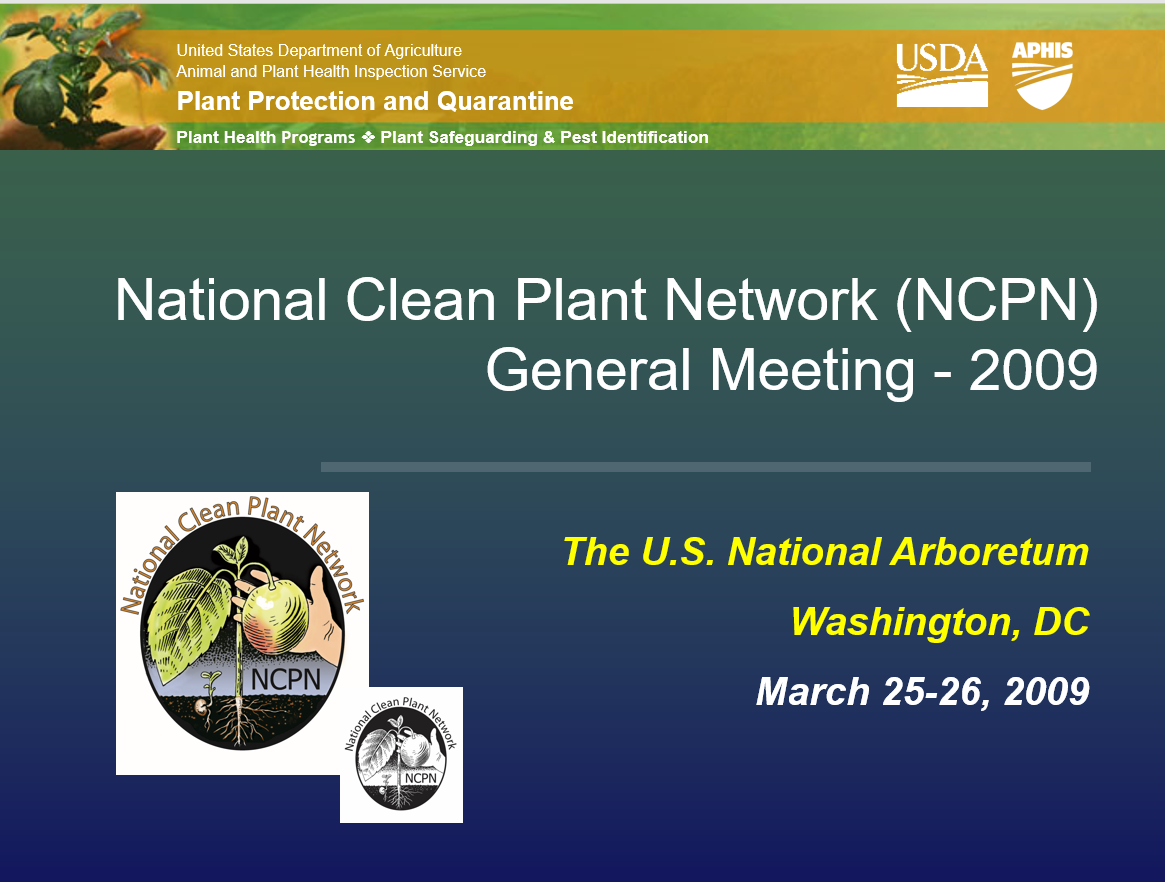
The structure and operational details of the new National Clean Plant Network (NCPN) were revealed to stakeholders at a three-day meeting assembled in Washington, D.C. on March 25-26, 2009. The three USDA agencies that coordinated the NCPN proposal (ARS, APHIS, CSREES now NIFA) agreed on a Memorandum of Understanding (MOU) to facilitate comprehensive NCPN program development. Murali Bandla, director of Plant Safeguarding and Pest Identification at APHIS, Thomas Bewick of CSREES (NIFA), and Erich Rudyj (APHIS) were the primary presenters on behalf of the USDA.
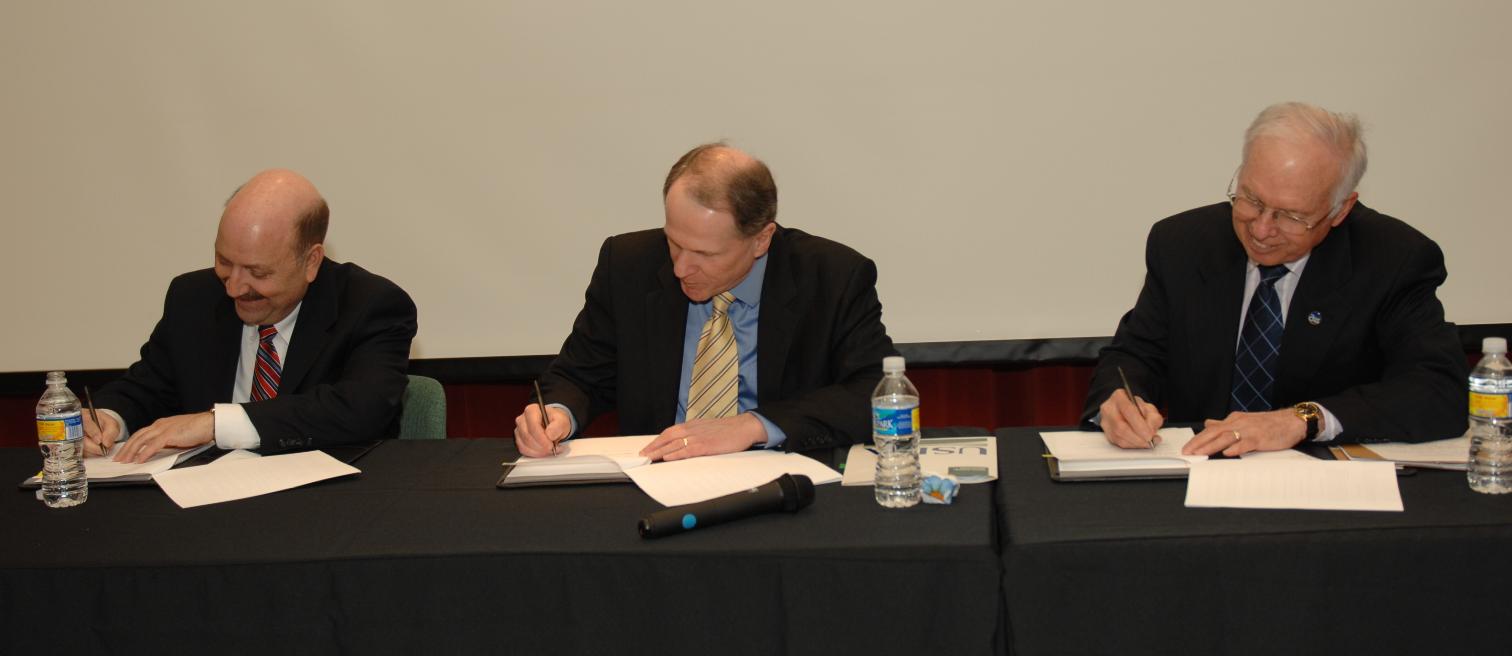
The NCPN is a voluntary association of specialty crop commodity groups having the common purpose of developing clean plant material for industry. USDA-APHIS manages the NCPN operations. A Governing Body of representatives from each of the three USDA agencies and five state and federal members distributes the funding. Industry representatives provide recommendations for funding to the Governing Body.
The initial specialty crops participating in the first years of the NCPN’s existence were grapes, fruit & nut trees, and hops. Over the years, additional crops were added. By 2019, the NCPN crops included grapes, fruit & nut trees, hops, citrus, berries, sweet potatoes and roses.
Grapevines play an important role in the U.S. economy in that they are grown in every region of the country, provide jobs and income in a multitude of industries and products. Pushing new cultivars and clones through the system is critical for the grapevine and grape products industries to have the best quality plant materials available and compete in the global market. In many cases these materials open doors for new domestic and export grapes and grape products, and also allow us to differentiate our current products to improve their consumer acceptance and overall quality.
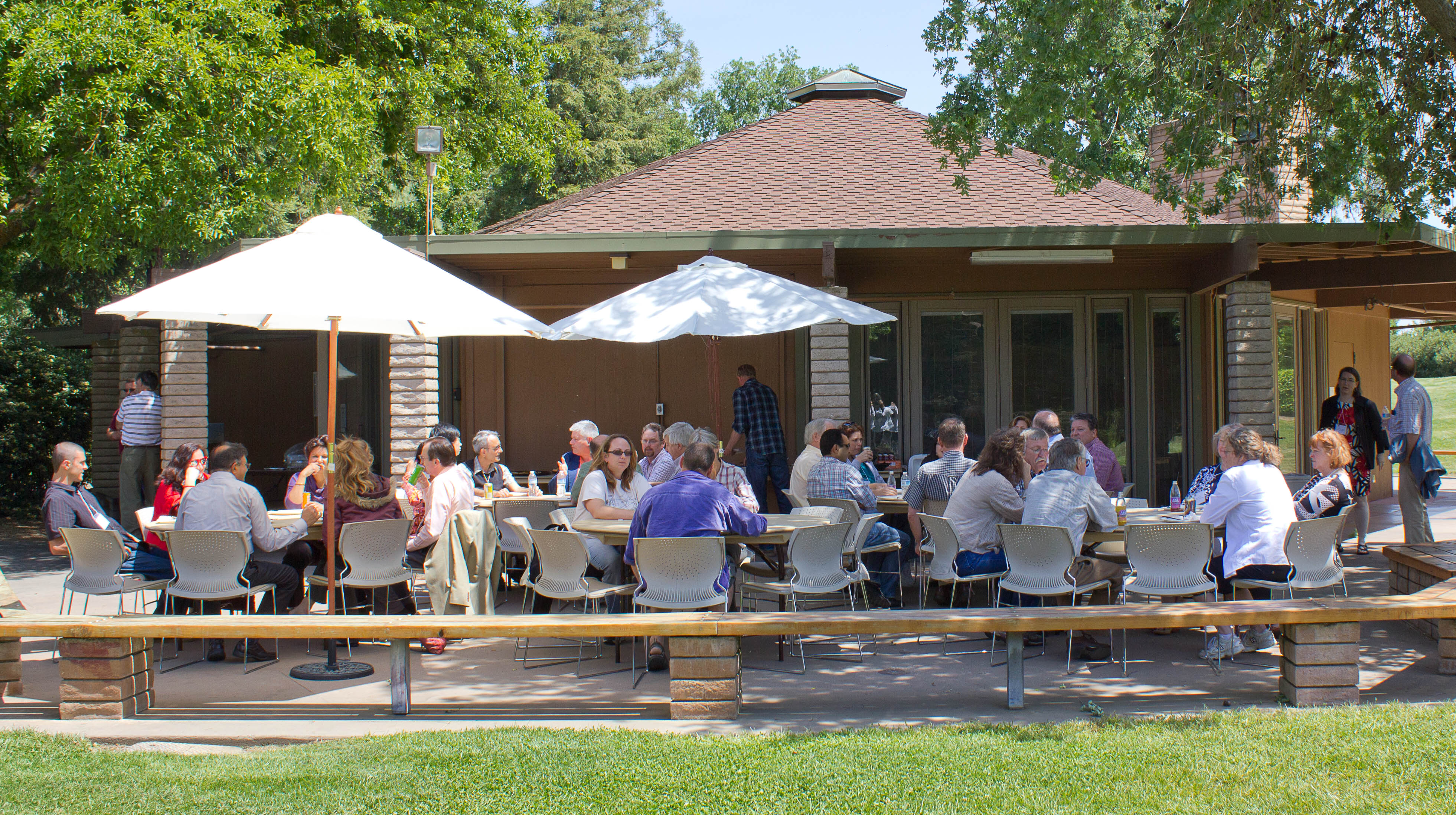
In the first year of its existence, the NCPN commodity groups organized the crop-specific governing boards and set up charters and rules for their governance. Their mission was to harmonize processes and cooperate in the activities of the centers for their crops.
FPS was designated the headquarters for NCPN Grapes because FPS manages the largest collection of pathogen-tested and treated grapevine plant material in the United States. FPS is a full-service center involved with all the functions necessary for a complete clean plant program, including maintenance of foundation collections, management of permits, performance of diagnostics and therapeutics, and distribution of plant material to the end users. FPS was recognized as the flagship center for grapes, as well as a significant center for other potential NCPN crops such as fruit trees.
NCPN – Grapes
Deborah Golino was elected Chair of NCPN Grapes. The Grapes Board has 22 members from throughout the United States with representatives from the nursery industry, grower community, state regulatory agencies, research and extension.

The first call for proposals for funding was issued by the USDA in June 2009. The NCPN Grapes Network entered cooperative agreements with the USDA for four institutions based on proposals that strengthened and improved their existing programs. Funding of $230,000–$1,300,000 was provided to grape clean plant centers at Washington State University; University of California, Davis; Cornell University; Missouri State University. Since the initial year, Florida State University has developed a clean plant program for grapes native to the American Southeast region. In 2010, NCPN established an Education and Outreach Working Group to develop and deliver extension materials to nurseries and growers. A Cross-Commodity Industry Leadership Team was established in 2011 to ensure that NCPN-generated products meet the needs of industry.
NCPN funding was renewed by section 10007 the Farm Bill of 2014, also known as the Agricultural Act of 2014. The NCPN was “made permanent” at that time and incorporated into the United States Code in its own right. 132 Title 7 U.S.C. section 7721(e). A specific allocation of “not less than $5,000,000 per year” is made to the USDA to fund the National Clean Plant Network.
NCPN, through its Cooperative Agreements Program, provided about $44,000,000 in support of 35 initiatives (all crops) at 27 clean plant centers in 19 States and U.S. Territories between 2008 and 2018.
NCPN Grapevine Collection at FPS
FPS has developed an extensive foundation grapevine collection in the years since its inception in the 1950’s. The large foundation vineyard contains hundreds of grape cultivars suitable for all climates and regions of the United States. An important decision reached by the NCPN in February, 2009, set the national standard for grapevine foundation material in the United States at a rigorous new level.
In 2009, UC Davis assigned to FPS the use of 100 acres in a farmland parcel located 4 miles west of the main campus and known as Russell Ranch. FPS developed a proposal to the NCPN to establish a new foundation vineyard on the Russell Ranch property to be managed by the highest phytosanitary standards in the world. The NCPN-Grapes Board approved the concept and recommended NCPN funding for the project. NCPN funds were granted for the infrastructure improvements for the new foundation vineyard beginning in 2009.
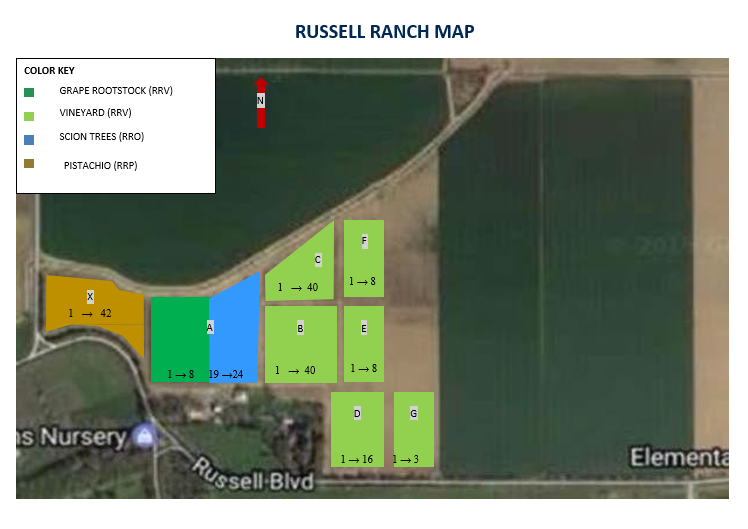
2010 Protocol
The NCPN-Grapes Board also approved a protocol in 2010 for qualification of all grapevine selections planted at the new Russell Ranch Foundation Vineyard. The testing protocol (known as the “2010 Protocol”) contained an extremely rigorous set of requirements for testing foundation grapevines. The standards require foundation grapevine material to satisfy two elements: (1) generation by microshoot tip tissue culture therapy for disease elimination; and (2) negative RT-PCR test results for an extensive list of diseases, mostly viruses.
The disease testing required by the 2010 Protocol is much more comprehensive than that required by the regulations of the California R&C Program. Candidate selections must satisfy the 2010 Protocol to qualify for planting in the Russell Ranch Foundation Vineyard. It is believed that FPS foundation selections undergo the most stringent testing and treatment in the world. [The development of the Russell Ranch Foundation Vineyard is described in more detail in the preceding chapter, “The Origin of Foundation Plant Services”].
FPS has since 2010 moved a substantial number of the selections from the Classic Foundation Vineyard (qualified over the years for the California R&C Program) to the Russell Ranch Foundation Vineyard. Russell Ranch foundation grapevine materials are in high demand by nurseries and growers and have become the accepted standard for the industry in California and some other states. NCPN provided the lion’s share of the funding for the elite foundation vineyard.
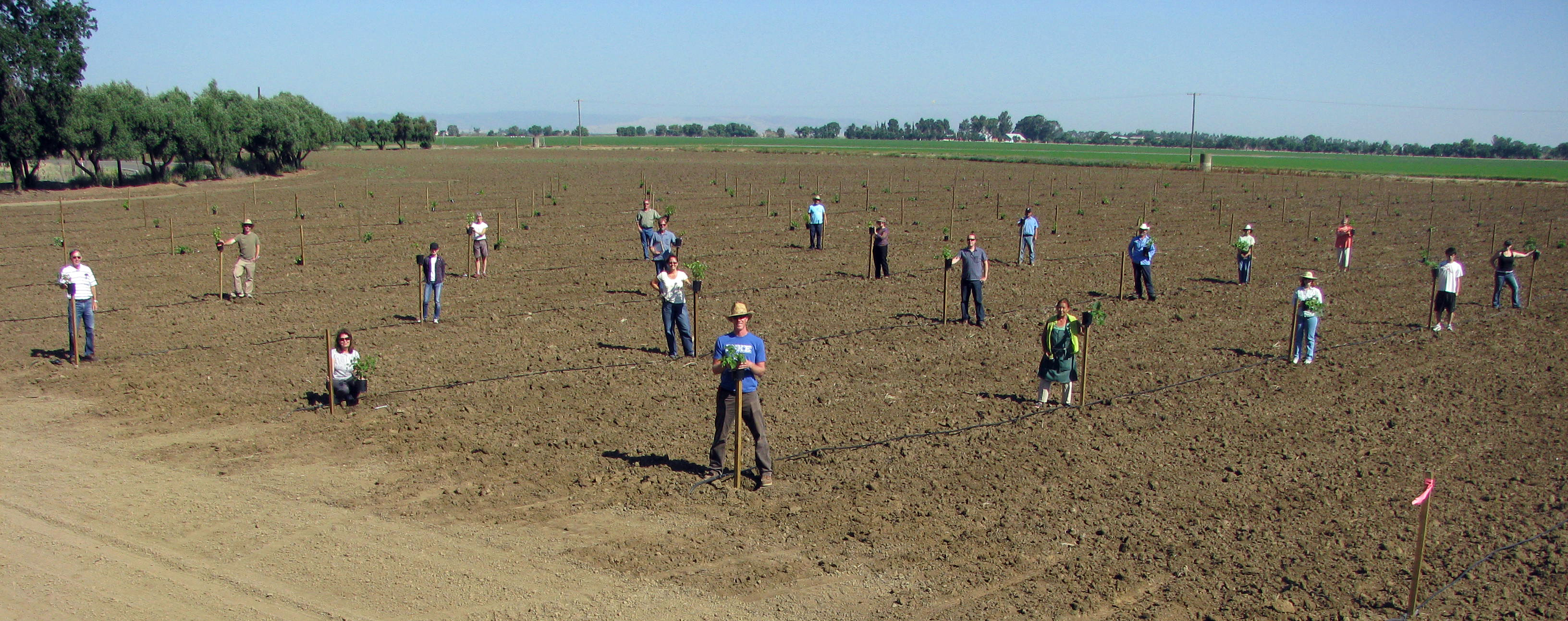
Economic value of clean grapevine plantings
Several studies reported between 2012 and 2018 have estimated the economic impact of leafroll viruses and potential value to the industry in the use of certified plant material. Research produced in California and New York has shown that the benefits of starting a planting with clean stock can be significant.
FPS was able to finance an economic study on the value of certified grape stock to grape growers in California’s North Coast. This relatively small part of U.S. vineyards was chosen because it is an area of fairly uniform grape prices, helpful to making straightforward economic analysis. The researchers were able to develop a model demonstrating that the value of virus free grape planting material to this one part of California is in excess of $20 million per year for the region, substantially outweighing the costs. That savings dwarfs the cost of the FPS program (source of nearly all California grape nursery stock) of about $2-3 million per year. 133 Fuller K.B., J.M. Alston, and D. Golino. “The Economic benefits from Virus Screening: A case study of grapevine leafroll in the North Coast of California”, American Journal of Enology and Viticulture (AJEV). Doi: 10.5344/ajev.2018.18067, formerly AJEV 66: 112-119.
Another study showed that, in New York’s Finger Lakes region, using clean plants at planting could raise net economic returns by $9693 to $16,014 per acre over the 25-year life of the vineyard by eliminating grapevine leafroll virus. 134 Atallah S.S., M.I. Gomez, M.F. Fuchs, and T.E. Martinson. “Economic impact of grapevine leafroll disease on Vitis vinifera cv. Cabernet franc in Finger Lakes vineyards of New York”, American Journal of Enology & Viticulture 63: 73-79 (2012); see also, Golino M.A., M. F. Fuchs, S. Sim, K. Farrar, and G. P. Martelli. “Improvement of Grapevine Planting Stock Through Sanitary Selection and Pathogen Elimination”, Grapevine Viruses: Molecular Biology, Diagnostics and Management, ed. B. Meng, G.P. Martelli, D.A. Golino, and M. Fuchs (Springer International Publishing AG, 2017), ch. 27, pp. 574-575.
In an as-yet unpublished study, economists at Cornell University in collaboration with FPS leadership evaluated the economic impact of use of FPS virus-tested grapevines in combatting leafroll virus for a 10-year period (2006 to 2015). Assumptions included production acreage with “clean” (virus-tested FPS) vines for a 10-year period from the time the vines are selected at FPS through production in the vineyard. Returns to investments ranged from an 18.1 rate for a 5% leafroll disease incidence in California vineyards by 2015 to a projected 134.5 rate for a 20% leafroll disease incidence in California vineyards by 2025. For every $1 invested in FPS operations, $18 (5% leafroll) by 2015 or $134 (20% leafroll) by 2025 are returned for the benefit of grape growers and grape nurseries. The total projected benefit was quantified at $270 million (5%) by 2015 to $4.099 billion (20%) by 2025 for use of virus-tested grapevines. 135 The study is not yet published but has been submitted for publication in 2019 to the American Journal of Viticulture & Enology. Miguel Goméz et al.
FPS has been the lead grape clean plant center for NCPN since the beginning and has pioneered new techniques and strategies. The cooperative effort of the NCPN grape centers in sharing resources and knowledge and in reaching out to industry members to educate on the value of healthy plant material have raised awareness on the beneficial effects of such materials.
Erich Rudyj has been the Coordinator of the National Clean Plant Network, since its inception in 2008. He assessed FPS’ contribution to the network as follows:
“The NCPN would not be as successful as it is today without the flagship centers such as FPS. From the beginning Deborah Golino and other FPS representatives have participated in defining the network, bringing all necessary players to the table, and ensuring and facilitating all existing clean plant centers’ participation in the network. FPS is recognized within the network as one of the premier clean plant centers in the NCPN. FPS has been the catalyst that has made the NCPN for Grapes thrive.” 136 Author interview with Erich Rudyj, Coordinator, National Clean Plant Network, USDA APHIS, October 5, 2018.
The Future for FPS
The financial future of the FPS program looks very promising. Multiple sources of income are an important part of a diversified management plan for a self-supporting unit such as FPS. Income from direct sales of plant materials and services, custom testing and treatment of proprietary selections, grape user fees paid by nurseries for FPS selections, IAB assessment funds through CDFA, and other industry donations and grants have been essential for the stability of the FPMS/FPS program in years past, prior to creation of the National Clean Plant Network.
One of the most notable financial developments for FPS in the past decade (2008-2018) has been the availability of federal funding from the newly created USDA National Clean Plant Network (NCPN). The Farm Bill of 2014 made that annual stream of income a predictable and stable source of income. The flow of NCPN funding has been critical to securing the quality of FPS programs.
The chart below (Figure 1) shows the sources of income at FPS from direct sales, custom testing and treatment of proprietary selections, grape user fees, IAB, NCPN and other industry grants averaged for the years 2006-2014. Total gross income during that period averaged $2,884,787 per year. The NCPN Governing Board considers the distribution of multiple funding sources to be a highly desirable balance to the federal funding.
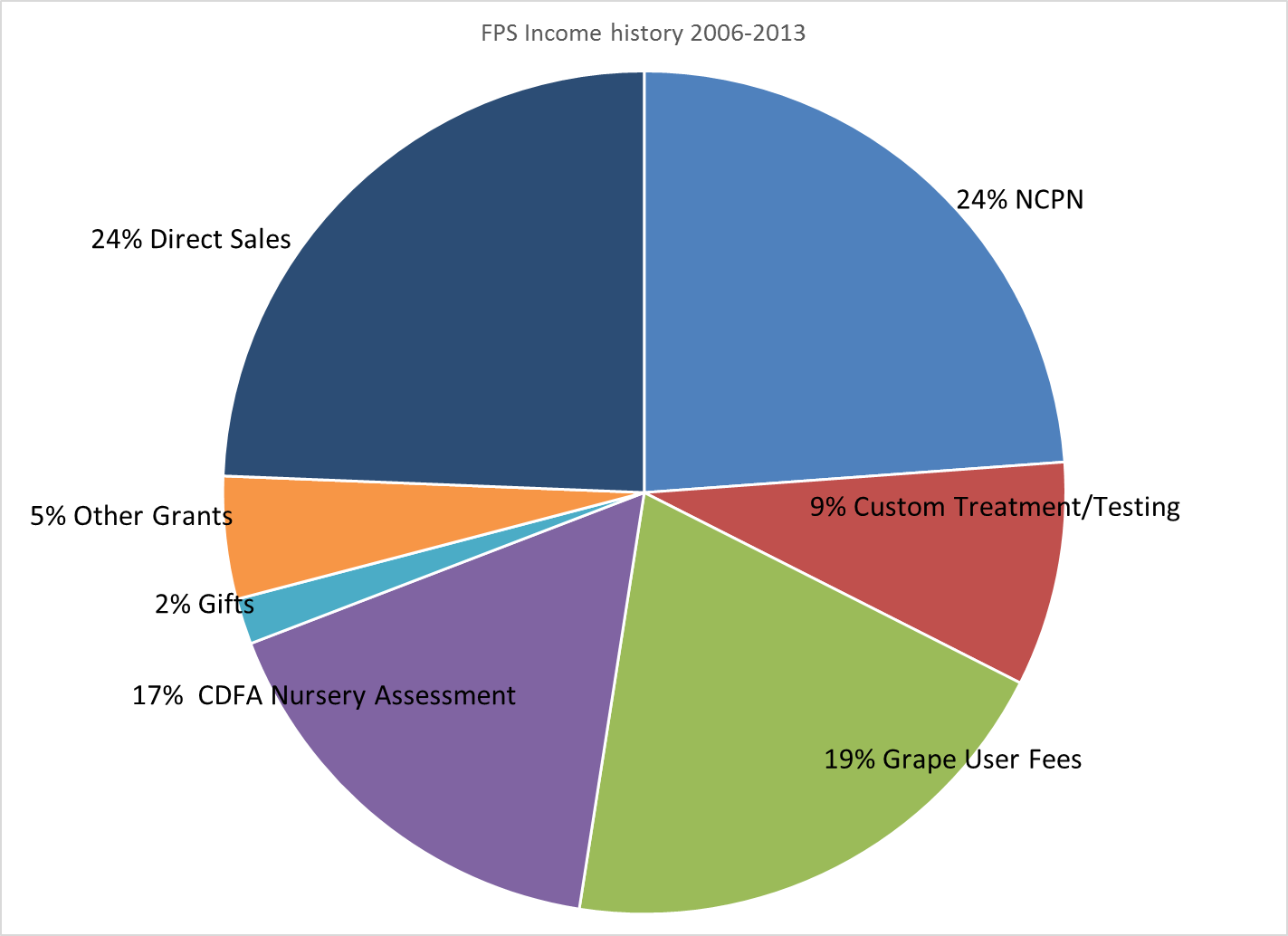
Figure 2 (below) illustrates how important a diversified portfolio of income sources is to the stability of the clean plant center at FPS. In any given year, there may be large variation in income from individual income sources including grants from NCPN, IAB, and other grant sources such as industry commodity funds. Figure 2 shows a variability in IAB assessments and user fees based on the success of the industry each year. Even with careful fiscal planning, there are unpredictable aspects to all of FPS income sources, including NCPN funds.
Figure 2 also illustrates how unpredictable income from sales is for FPS. In 06-07, FPS had approximately $1.3 million in sales; UCB-1 pistachio seed represented $987,836 of this income. Many of our pistachio experts expect this source of income to be eliminated in the near future as the industry moves to clonally propagated pistachio rootstock. The income from sales is subject to unexpected market fluctuations due to economic uncertainties.
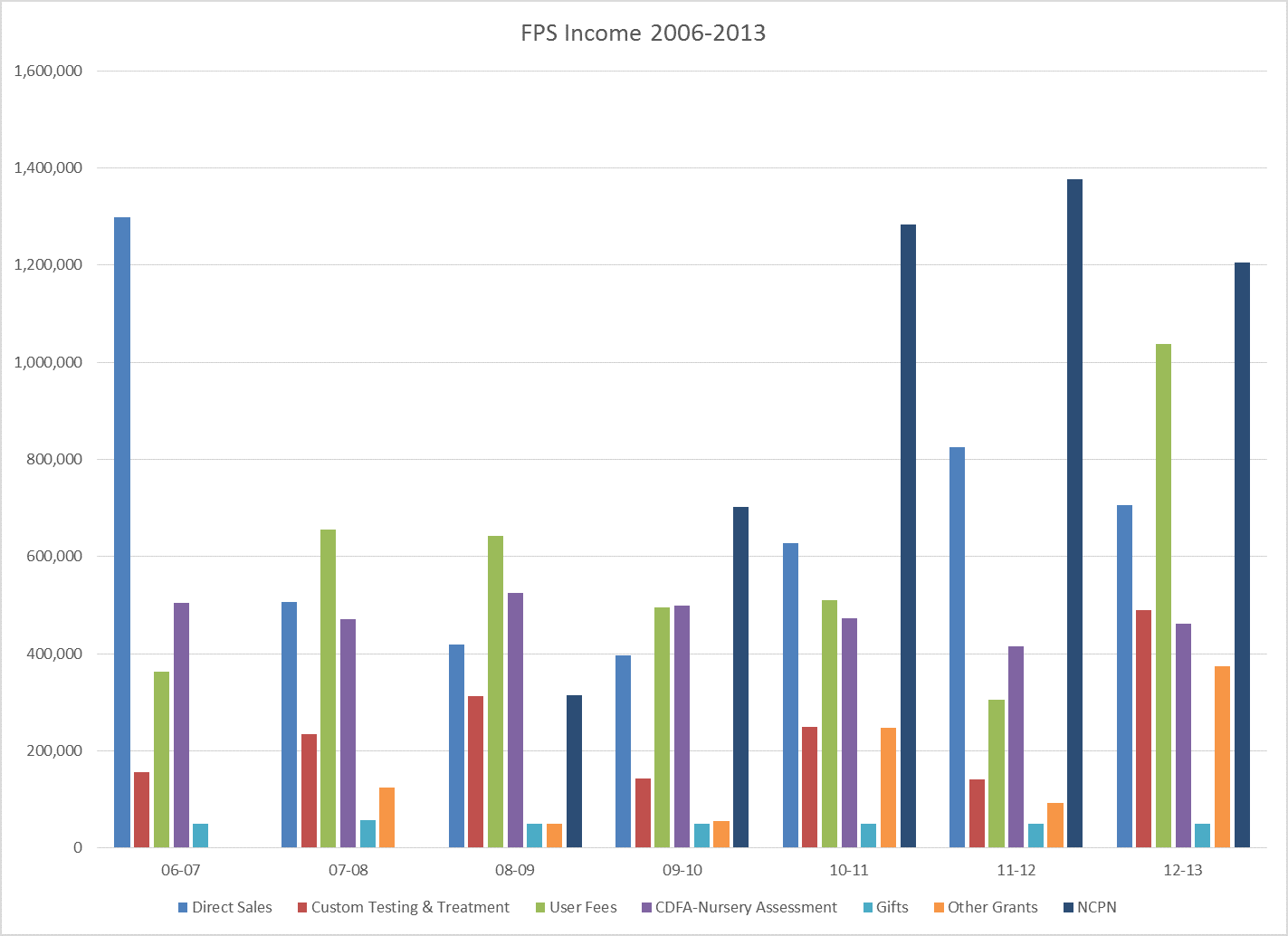
Taken together, the multiple sources of funding have achieved the elusive “stable funding” source for FPS to secure long-range productivity and continuity of the FPS clean plant program.
In recent years, the financial support from all sources has enabled FPS to modernize laboratory equipment; refurbish growth chambers and greenhouses; establish the Russell Ranch Foundation Vineyard at a high phytosanitary standard; largely expand grape importation, quarantine and therapy programs; increase and upgrade pathogen testing for the tree and grape collections; and organize and host stakeholders’ meetings.
CONCLUSION
FPS and other clean plant centers fill an important niche in developing quality plant material for specialty crop industries in the United States. The financial difficulties experienced in the past have been substantially ameliorated by federal funding from the National Clean Plant Network. Multiple funding sources including contributions from industry provide stability for the FPS program and effectively support the service activities and applied research that are valued by industry customers.
The FPS foundation grape collection is a valuable asset to the grape and wine industry in the United States. The many years of plant exploration, collection of heritage materials and importation of new varieties and clones have resulted in a large and diverse grape collection. Development of new technologies and scientific discoveries have produced a healthy product for FPS customers. The experiment begun at UC Davis in 1958 can be considered a success.


